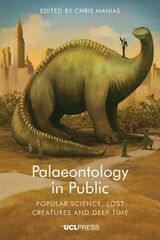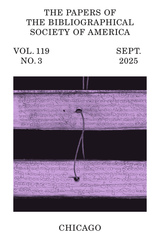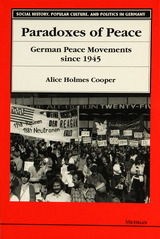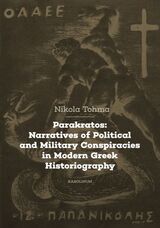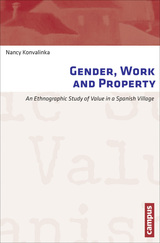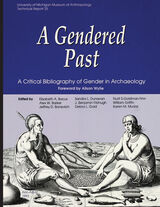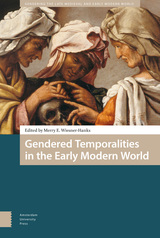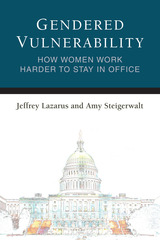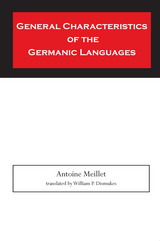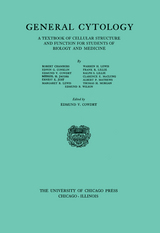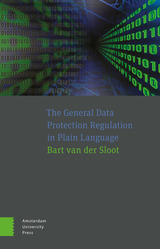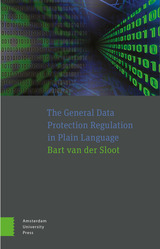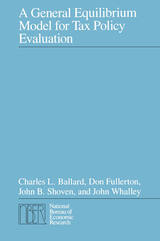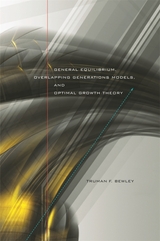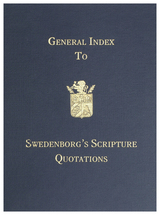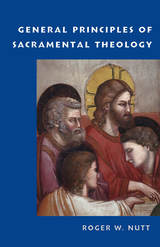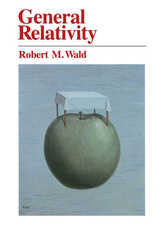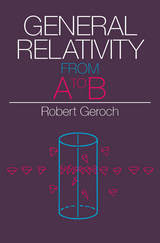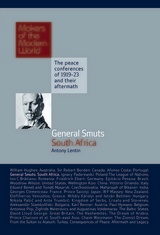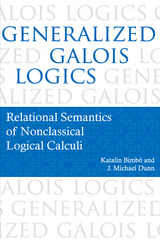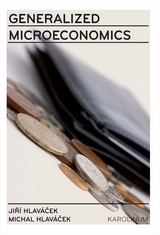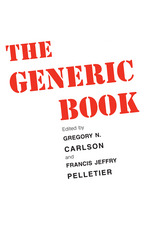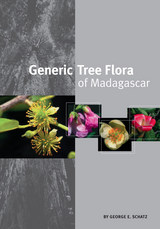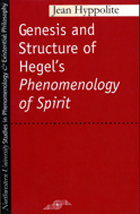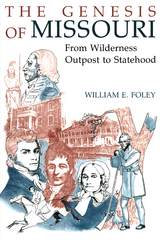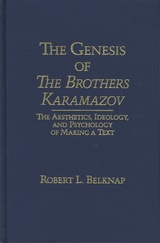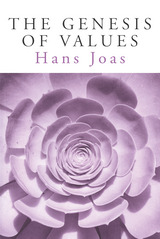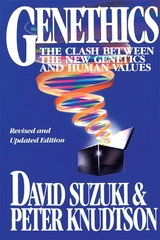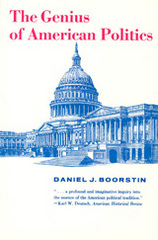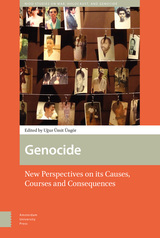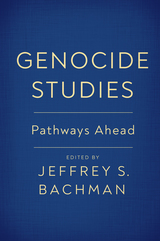Gender Studies: New Directions in Feminist Criticism
Judith A. Spector
University of Wisconsin Press, 1986 The essays in Gender Studies explore relationships between gender and creativity, identity, and genre within the context of literary analysis. Some of the essays are psychoanalytic in approach in that they seek to discover the sexual dynamic/s involved in the creation of literature as an art form. Still others attempt to isolate and examine the sexual attitudes inherent in the works of particular authors or genres, or to determine how writers explore the sensibilities of each gender.
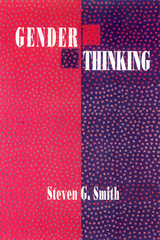 Gender Thinking
Steven G. Smith
Temple University Press, 1992 How can we accept the gender system in view of its ills? Yet, are we really at liberty to abolish gender differences, "when the gender system gives us benchmarks of personal identity and worth along with primary channels in which to pursue the rewards of love?" With this double question, Steven G. Smith introduces his inquiry into the idea of gender and how it is implicated in love, respect, equality, and personal character. Gender Thinking is the first comprehensive philosophical exploration of the concept of gender Asking the question, what is gender?—that is, what sort of thing do we take femininity and masculinity to be?—Smith considers how gender thinking is interwoven with ideas about human nature. He suggests ways in which ideas about race, class, culture age, temperament, and sexual orientation can be understood from clues found in gender thinking. And he calls for a renegotiated procreative partnership between women and men as the key to the redemption of gender.
 Gender Violence and the Press: The St. Kizito Story
H. Leslie Steeves
Ohio University Press, 1997 On the night of Saturday, July 13, 1991, a mob of male students at the St. Kizito Mixed Secondary School in Meru, Kenya, attacked their female classmates in a dormitory. Nineteen schoolgirls were killed in the melee and more than 70 were raped or gang raped. The explanations in the press for the attack included a rebellion by male students over administrative mismanagement, academic stress, cultural norms for the Meru ethnic group, and victim characteristics (as assumed in rape myths). Rape had been tolerated at the school, according to press accounts. Dr. Steeves studied all stories published in three Nairobi daily newspapers and a weekly Kenyan newsmagazine for the year following the crime. She also examined a sampling of international reports. Her qualitative analysis sought to identify “framing patterns” supportive of patriarchal or of feminist ideologies of rape, and the ways in which those patterns have been affected by news values and traditions. Gender Violence and the Press shows how media discourse may allow space for feminist interests within the dominant patriarchal ideology. In this instance, the appearance of resistant views was significant in making alternative meanings available and in supporting women’s growing anti-violence activism.
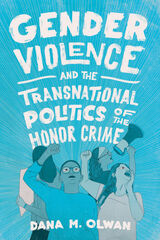 Gender Violence and the Transnational Politics of the Honor Crime
Dana M. Olwan
Ohio State University Press, 2021 In Gender Violence and the Transnational Politics of the Honor Crime, Dana M. Olwan examines how certain forms of violence become known, recognized, and contested across multiple geopolitical contexts—looking specifically at a particular form of gender-based violence known as the “honor crime” and tracing how a range of legal, political, and literary texts inform normative and critical understandings of this term. Although a number of studies now acknowledge the complicated mobilizations of honor crime discourses, the ways in which these discourses move across and in between different geographies and contexts remain relatively unexplored. This book fills that void by providing a transnational feminist examination of the disparate—yet interconnected—sites of the US, Canada, Jordan, and Palestine, showing how the concept travels across nations and is deployed to promote hegemonic agendas—becoming intertwined in notions of modernity, citizenship, and belonging. More specifically, Olwan traces the term’s appearance in public and popular works that allow for its continued mass acceptance and circulation—from media depictions in Canada and beyond, to how it is taken up in national registers about migration and belonging in the US, to activism in Palestine that reveal the fault lines between activist and academic critiques of the honor crime, and finally to feminist efforts in Jordan and the wider Middle East to confront legal codes used to sanction gender-related violence. Through these cases, Olwan demonstrates how the honor crime functions as a signifier that governs and manages populations and how its meanings travel and circulate across and between separate and interconnected circuits of power and knowledge.
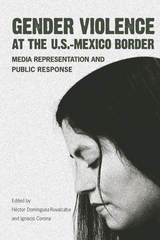 Gender Violence at the U.S.–Mexico Border: Media Representation and Public Response
Edited by Héctor Domínguez-Ruvalcaba and Ignacio Corona
University of Arizona Press, 2012 The U.S.-Mexico border is frequently presented by contemporary media as a violent and dangerous place. But that is not a new perception. For decades the border has been constructed as a topographic metaphor for all forms of illegality, in which an ineffable link between space and violence is somehow assumed. The sociological and cultural implications of violence have recently emerged at the forefront of academic discussions about the border. And yet few studies have been devoted to one of its most disturbing manifestations: gender violence. This book analyzes this pervasive phenomenon, including the femicides in Ciudad Juárez that have come to exemplify, at least for the media, its most extreme manifestation.
Contributors to this volume propose that the study of gender-motivated violence requires interpretive and analytical strategies that draw on methods reaching across the divide between the social sciences and the humanities. Through such an interdisciplinary conversation, the book examines how such violence is (re)presented in oral narratives, newspaper reports, films and documentaries, novels, TV series, and legal discourse. It also examines the role that the media have played in this process, as well as the legal initiatives that might address this pressing social problem.
Together these essays offer a new perspective on the implications of, and connections between, gendered forms of violence and topics such as mechanisms of social violence, the micro-social effects of economic models, the asymmetries of power in local, national, and transnational configurations, and the particular rhetoric, aesthetics, and ethics of discourses that represent violence.
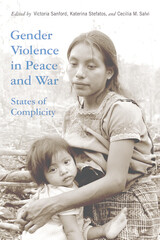 Gender Violence in Peace and War: States of Complicity
Sanford, Victoria
Rutgers University Press, 2016 Reports from war zones often note the obscene victimization of women, who are frequently raped, tortured, beaten, and pressed into sexual servitude. Yet this reign of terror against women not only occurs during exceptional moments of social collapse, but during peacetime too. As this powerful book argues, violence against women should be understood as a systemic problem—one for which the state must be held accountable. The twelve essays in Gender Violence in Peace and War present a continuum of cases where the state enables violence against women—from state-sponsored torture to lax prosecution of sexual assault. Some contributors uncover buried histories of state violence against women throughout the twentieth century, in locations as diverse as Ireland, Indonesia, and Guatemala. Others spotlight ongoing struggles to define the state’s role in preventing gendered violence, from domestic abuse policies in the Russian Federation to anti-trafficking laws in the United States. Bringing together cutting-edge research from political science, history, gender studies, anthropology, and legal studies, this collection offers a comparative analysis of how the state facilitates, legitimates, and perpetuates gender violence worldwide. The contributors also offer vital insights into how states might adequately protect women’s rights in peacetime, as well as how to intervene when a state declares war on its female citizens.
Gender, Work and Property: An Ethnographic Study of Value in a Spanish Village
Nancy Konvalinka
Campus Verlag, 2013
Why do young men born in many small villages in Spain tend, at the end of the twentieth century, to stay there to live, often remaining unmarried, while young women from the same villages tend to leave? In Gender, Work, and Property, Nancy Konvalinka explores this phenomenon using the case of one small village in northwestern Spain, and she extrapolates her findings there to understand similar processes elsewhere in Europe.
The changes in this village are analyzed and documented through long-term ethnographic research, participant observation, interviews, kinship diagrams, life-course models, and archive study in order to help bring the village alive for the reader.
Gender/Body/Knowledge: Feminist Reconstructions of Being and Knowing
Jaggar, Alison M
Rutgers University Press, 1989 The essays in this interdisciplinary collection share the conviction that modern western paradigms of knowledge and reality are gender-biased. Some contributors challenge and revise western conceptions of the body as the domain of the biological and 'natural,' the enemy of reason, typically associated with women.
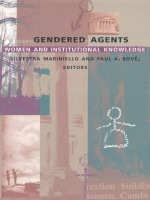 Gendered Agents: Women and Institutional Knowledge
Silvestra Mariniello and Paul A. Bové, eds.
Duke University Press, 1998 Gendered Agents, edited by Silvestra Mariniello andPaul A. Bové, presents essays by influential feminist theorists who challenge traditional Western epistemology and suggest new directions for feminism. By examining both literary and historical discourses, such critics as Gayatri Spivak, Hortense Spillers, and Lauren Berlant assess questions of sexuality, ethics, race, psychoanalysis, subjectivity, and identity. Gathered from various issues of the journal boundary 2, the essays in Gendered Agents seek to transform the model of Western academic knowledge by restructuring its priorities and values. In the introduction, Mariniello urges feminists to begin anew but take as their starting place the achievements of feminism and feminist theory: an understanding of language that considers the implications of silence, the motivation to decompartmentalize experience, and the acknowledgement that everything is political. Challenging both a canonical organization of knowledge and the persistently self-referential "ghettoization" of feminism, contributors subsequently tackle subjects as diverse as pre-Marxist France, the American fetus, black intellectuals, queer nationality, and the art of literary interpretation. Contributors. Lauren Berlant, Karen Brennan, Margaret Cohen, Nancy Fraser, Elizabeth Freeman, Carol Jacobs, Silvestra Mariniello, Larysa Mykyta, Laura Rice, Ivy Schweitzer, Doris Sommer, Hortense J. Spillers, Gayatri Chakravorty Spivak, Judith Wilt
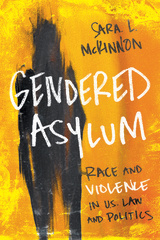 Gendered Asylum: Race and Violence in U.S. Law and Politics
Sara L. McKinnon
University of Illinois Press, 2016 Women filing gender-based asylum claims long faced skepticism and outright rejection within the United States immigration system. Despite erratic progress, the United States still fails to recognize gender as an established category for experiencing persecution. Gender exists in a sort of limbo segregated from other aspects of identity and experience. Sara L. McKinnon exposes racialized rhetorics of violence in politics and charts the development of gender as a category in American asylum law. Starting with the late 1980s, when gender-based requests first emerged in case law, McKinnon analyzes gender- and sexuality-related cases against the backdrop of national and transnational politics. Her focus falls on cases as diverse as Guatemalan and Salvadoran women sexually abused during the Dirty Wars and transgender asylum seekers from around the world fleeing brutally violent situations. She reviews the claims, evidence, testimony, and message strategies that unfolded in these legal arguments and decisions, and illuminates how legal decisions turned gender into a political construct vulnerable to American national and global interests. She also explores myriad related aspects of the process, including how subjects are racialized and the effects of that racialization, and the consequences of policies that position gender as a signifier for women via normative assumptions about sex and heterosexuality. Wide-ranging and rich with human detail, Gendered Asylum uses feminist, immigration, and legal studies to engage one of the hotly debated issues of our time.
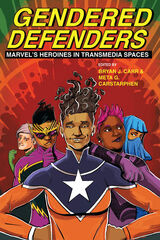 Gendered Defenders: Marvel's Heroines in Transmedia Spaces
Edited by Bryan J. Carr and Meta G. Carstarphen
Ohio State University Press, 2022 Gendered Defenders: Marvel’s Heroines in Transmedia Spaces delivers dynamic and original analyses of how women perform in super heroic spaces. Contributors from a range of disciplinary perspectives—communications, international relations, cultural and media studies, English, history, and public policy—take on Marvel’s representations of women and gender to examine how relations of power are (re)produced, understood, and challenged. Through vivid retellings of character-based scenarios, these essays examine Carol Danvers, Jessica Jones, Ms. Marvel, Shuri, Pepper Potts, Black Widow, and Squirrel Girl across media forms to characterize and critique contemporary understandings of identity, feminism, power, and gender. Collectively, Gendered Defenders challenges notions about female identity while illuminating the multidimensional portrayals that are enabled by the form of speculative fiction. Making explicit the connections between women’s lived experiences and the imagined exploits of superheroines, contributors explore how these pop culture narratives can help us understand real-world gender dynamics and prepare pedagogical, political, and social strategies for dealing with them. Contributors: Bryan J. Carr, Meta G. Carstarphen, Julie A. Davis, Rachel Grant, Annika Hagley, Amanda K. Kerhberg, Gregory P. Perreault, Mildred F. Perreault, CarrieLynn D. Reinhard, Maryanne A. Rhett, Stephanie L. Sanders, J. Richard Stevens, Anna C. Turner, Kathleen M. Turner-Ledgerwood, Robert Westerfelhaus
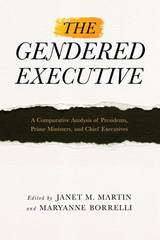 The Gendered Executive: A Comparative Analysis of Presidents, Prime Ministers, and Chief Executives
Janet M. Martin
Temple University Press, 2016 Excluded from the ranks of elite executive decision-makers for generations, women are now exercising power as chiefs of government and chiefs of state. As of April 2016, 112 women in 73 countries have served as presidents or prime ministers. The Gendered Executive is a critical examination of national executives, focusing on matters of identity, representation, and power. The editors and contributors to this volume address the impact of female executives through political mobilization and participation, policy- and decision-making, and institutional change. Other topics include party nomination processes, the intersectionality of race and gender, and women-centered U.S. foreign policy in southern Africa. In addition, case studies from Chile, India, Portugal, and the United States are presented, as are cross-national comparisons of women leaders in Latin America. The Gendered Executive will enhance our understanding of the complexity of gender in and comparative analyses of executive politics. Contributors include: Amy C. Alexander, Sheetal Chhabria, Georgia Duerst-Lahti, Maria C. Escobar-Lemmon, Cory Charles Gooding, Lilly Goren, Karen M. Hult, Farida Jalalzai, Daniela F. Melo, Catherine Reyes-Housholder, Ariella R. Rotramel, Leslie A. Schwindt-Bayer, Michelle M. Taylor-Robinson, and the editors
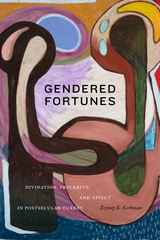 Gendered Fortunes: Divination, Precarity, and Affect in Postsecular Turkey
Zeynep K. Korkman
Duke University Press, 2023 In Gendered Fortunes, Zeynep K. Korkman examines Turkey’s commercial fortunetelling cafés where secular Muslim women and LGBTIQ individuals navigate the precarities of twenty-first-century life. Criminalized by long-standing secularist laws and disdained by contemporary Islamist government, fortunetelling cafés proliferate in part because they offer shelter from the conservative secularist, Islamist, neoliberal, and gender pressures of the public sphere. Korkman shows how fortunetelling is a form of affective labor through which its participants build intimate feminized publics in which they share and address their hopes and fears. Korkman uses feeling—which is how her interlocutors describe the divination process—as an analytic to view the shifting landscape of gendered vulnerability in Turkey. In so doing, Korkman foregrounds “feeling” as a feminist lens to explore how those who are pushed to the margins feel their way through oppressive landscapes to create new futures.
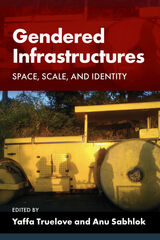 Gendered Infrastructures: Space, Scale, and Identity
Yaffa Truelove
West Virginia University Press, 2024 Brings together feminist and geographical approaches to the gendered dimensions of various types of infrastructure across the globe.
The first book to take a feminist geographical approach to infrastructure, Gendered Infrastructures delves into the complex relationships between identity, social relations, and infrastructure. By drawing on feminist scholarship to enable new frameworks for critical study, this edited volume explores the gendered nature of infrastructures as diverse as Senegal’s waste disposal, Vietnam’s cement industry, and Lilongwe’s water kiosks. The chapters consider how infrastructural assemblages rework and shape gendered relations, identities, and meanings across space, while tracing the intersectionality of relations and uneven geographies that surround infrastructure. Ultimately, the contributors show how gender is always present in the quotidian building blocks that organize the socio-material world and daily life.
Edited by Yaffa Truelove and Anu Sabhlok, and the third book in Amy Trauger and Jennifer Fluri’s Gender, Feminism, and Geography series, the original essays in Gendered Infrastructures respond to and build upon a “new infrastructural turn in critical scholarship”—one that has helped enliven studies of identity across scale. The volume is relevant to geographers, anthropologists, architects, sociologists, urban researchers, and other interdisciplinary scholars interested in the gendered and social dimensions of infrastructure.
 Gendered Justice in the American West: Women Prisoners in Men's Penitentiaries
Anne M. Butler
University of Illinois Press, 1997 In this shocking study, Anne M. Butler shows that the distinct gender disadvantages already faced by women within western society erupted into intense physical and mental violence when they became prisoners in male penitentiaries.
Drawing on prison records and the words of the women themselves, Gendered Justice in the American West places the injustices women prisoners endured in the context of the structures of male authority and female powerlessness that pervaded all of American society. Butler's poignant cross-cultural account explores how nineteenth-century criminologists constructed the "criminal woman"; how the women's age, race, class, and gender influenced their court proceedings; and what kinds of violence women inmates encountered. She also examines the prisoners' diet, illnesses, and experiences with pregnancy and child-bearing, as well as their survival strategies.
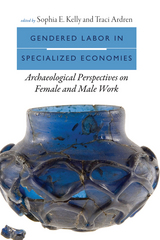 Gendered Labor in Specialized Economies: Archaeological Perspectives on Female and Male Work
Sophia E. Kelly
University Press of Colorado, 2016 Prehistoric economic relationships are often presented as genderless, yet mounting research highlights the critical role gendered identities play in the division of work tasks and the development of specialized production in pre-modern economic systems. In Gendered Labor in Specialized Economies, contributors combine the study of gender in the archaeological record with the examination of intensified craft production in prehistory to reassess the connection between craft specialization and the types and amount of work that men and women performed in ancient communities.
Chapters are organized by four interrelated themes crucial for understanding the implications of gender in the organization of craft production: craft specialization and the political economy, combined effort in specialized production, the organization of female and male specialists, and flexibility and rigidity in the gendered division of labor. Contributors consider how changes to the gendered division of labor in craft manufacture altered other types of production or resulted from modifications in the organization of production elsewhere in the economic system.
Striking a balance between theoretical and methodological approaches and presenting case studies from sites around the world, Gendered Labor in Specialized Economies offers a guide to the major issues that will frame future research on how men’s and women’s work changes, predisposes, and structures the course of economic development in various societies.
Contributors: Alejandra Alonso Olvera, Traci Ardren, Michael G. Callaghan, Nigel Chang, Cathy Lynne Costin, Pilar Margarita Hernández Escontrías, A. Halliwell, Sue Harrington, James M. Heidke, Sophia E. Kelly, Brigitte Kovacevich, T. Kam Manahan, Ann Brower Stahl, Laura Swantek, Rita Wright, Andrea Yankowski
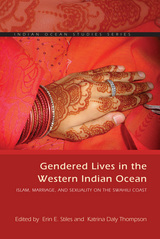 Gendered Lives in the Western Indian Ocean: Islam, Marriage, and Sexuality on the Swahili Coast
Erin E. Stiles
Ohio University Press, 2015 Muslim communities throughout the Indian Ocean have long questioned what it means to be a “good Muslim.” Much recent scholarship on Islam in the Indian Ocean considers debates among Muslims about authenticity, authority, and propriety. Despite the centrality of this topic within studies of Indian Ocean, African, and other Muslim communities, little of the existing scholarship has addressed such debates in relation to women, gender, or sexuality. Yet women are deeply involved with ideas about what it means to be a “good Muslim.”
In Gendered Lives in the Western Indian Ocean, anthropologists, historians, linguists, and gender studies scholars examine Islam, sexuality, gender, and marriage on the Swahili coast and elsewhere in the Indian Ocean. The book examines diverse sites of empowerment, contradiction, and resistance affecting cultural norms, Islam and ideas of Islamic authenticity, gender expectations, ideologies of modernity, and British education. The book’s attention to both masculinity and femininity, broad examination of the transnational space of the Swahili coast, and inclusion of research on non-Swahili groups on the East African coast makes it a unique and indispensable resource.
Contributors: Nadine Beckmann, Pat Caplan, Corrie Decker, Rebecca Gearhart, Linda Giles, Meghan Halley, Susan Hirsch, Susi Keefe, Kjersti Larsen, Elisabeth McMahon, Erin Stiles, and Katrina Daly Thompson
 Gendered Memories: An Imaginary Museum for Ding Ling and Chinese Female Revolutionary Martyrs
Xian Wang
University of Michigan Press, 2025 Gendered Memories: An Imaginary Museum for Ding Ling and Chinese Female Revolutionary Martyrs takes readers on a journey through the lives and legacies of Chinese female revolutionary martyrs, revealing how their sacrifices have been remembered, commemorated, and manipulated throughout history. This innovative book blends historical narratives with personal narratives, creating an “imaginary museum” where the stories of these women are brought to life. Author Xian Wang employs this imaginary museum to create a conceptual space mirroring an actual museum that juxtaposes historical narratives with countermemories of Chinese female revolutionaries, such as the prominent writer Ding Ling. Exploring Ding’s experiences with martyrdom and the commemoration of female revolutionary martyrs associated with her, the book provides a compelling argument that female revolutionary martyrdom reinforces, rather than rejects, the traditional concept of female chastity martyrdom. Narratives that challenge established gender norms, particularly those surrounding female chastity, have often been silenced or overlooked in the collective memory of these female revolutionary martyrs. By delving into these countermemories, Wang provides fresh insights into gendered violence, memories, and politics in modern Chinese literature and culture.
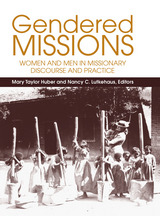 Gendered Missions: Women and Men in Missionary Discourse and Practice
Mary Taylor Huber and Nancy C. Lutkehaus, Editors
University of Michigan Press, 1999 Throughout the age of Western colonial expansion, Christian missionaries were important participants in the encounter between the West and peoples throughout the rest of the world. Mission schools, health services, and other cultural technologies helped secure Western colonialism, and in some cases transformed or even undermined colonialism's effect. The very breadth of missionaries's focus, however, made the involvement of women in missionary work both possible and necessary.
Missionary groups thus faced more immediately the destabilizing challenges that colonial experience posed to their own ways of organizing relations between women and men. Examining the changing prospects for professional women in the missions, the contributors to Gendered Missions ask how these shaped, and were shaped by, crucial practical, political, and religious developments at home and abroad. While the focus is on the tumultuous period that historian Eric Hobsbawm calls "The Age of Empire" (1875-1914), attention also is paid to how gender has been debated in later colonial and post-colonial missions.
Scholars from any field concerned with colonial and postcolonial societies or with gender and women's history should find this book of special interest. In addition, Gendered Missions should appeal to readers in church history, mission studies, and the sociology of religion.
Mary Taylor Huber is Senior Scholar, The Carnegie Foundation for the Advancement of Teaching. Nancy C. Lutkehaus is Associate Professor of Anthropology, University of Southern California.
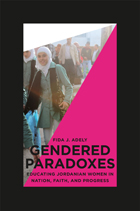 Gendered Paradoxes: Educating Jordanian Women in Nation, Faith, and Progress
Fida Adely
University of Chicago Press, 2012 In 2005 the World Bank released a gender assessment of the nation of Jordan, a country that, like many in the Middle East, has undergone dramatic social and gender transformations, in part by encouraging equal access to education for men and women. The resulting demographic picture there—highly educated women who still largely stay at home as mothers and caregivers— prompted the World Bank to label Jordan a “gender paradox.” In Gendered Paradoxes, Fida J. Adely shows that assessment to be a fallacy, taking readers into the rarely seen halls of a Jordanian public school—the al-Khatwa High School for Girls—and revealing the dynamic lives of its students, for whom such trends are far from paradoxical. Through the lives of these students, Adely explores the critical issues young people in Jordan grapple with today: nationalism and national identity, faith and the requisites of pious living, appropriate and respectable gender roles, and progress. In the process she shows the important place of education in Jordan, one less tied to the economic ends of labor and employment that are so emphasized by the rest of the developed world. In showcasing alternative values and the highly capable young women who hold them, Adely raises fundamental questions about what constitutes development, progress, and empowerment—not just for Jordanians, but for the whole world.
A Gendered Past: A Critical Bibliography of Gender in Archaeology
Foreword by Alison Wylie. Edited by Elisabeth A. Bacus, Alex W. Barker, Jeffrey D. Bonevich, Sandra L. Dunavan, J. Benjamin Fitzhugh, Debra L. Gold, Nurit S. Goldman-Finn, William Griffin, and Karen M. Mudar
University of Michigan Press, 1993 This annotated bibliography reviews contributions from a wide variety of theoretical orientations, many from geographical or temporal contexts.
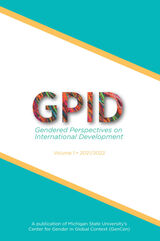 Gendered Perspectives on International Development, vol. 1
Wenda Bauchspies
Michigan State University Press Journals, 2022 In This Issue
Introduction to the 40th Anniversary of Gendered Perspectives on International Development
Chelsea Wentworth, Wenda Bauchspies, Rebecca Irvine, Ashley Strong, and Katie Paulot
Articles
The Influence of Gender in Refugee Camp Safety: A Case Study of Moria and Kara Tepe in Lesvos, Greece
Allison Pail
The Role of Water, Sanitation, Hygiene, and Gender Norms on Women’s Health: A Conceptual Framework
Rita Jalali
COVID-19 and MENA: Governance, Geopolitics, and Gender
Valentine M. Moghadam
A Comparison of Zika Incidence and Access to Reproductive Healthcare in El Salvador and Cuba During the Latin American Zika Epidemic
Georgia Artzberger
Impacts of AIDS on Women in Uganda
Valerie L. Durrant
Gendered Civic Epistemology: Knowledge Practices During an Ebola Outbreak in Guinea and Mali
Abou Traore, Wenda Bauchspies, and Wesley Shrum
Mapping Gender Roles in Family Farm Wheat Production in Central Afghanistan: Evaluating Roles, Constraints, and Opportunities
Aziz Ahmad Osmani, Gul Mohammad Ajir, Parisa Aqdas Karimi, Abdul Khalid Madadi, Noorullah Mayar, Margaret Orwig, and Carmen N. Benson
Book Reviews
Readings in Sexualities from Africa, edited by Rachel Spronk and Thomas Hendriks
Reviewed by Samantha Smith
Gender and Work in Global Value Chains: Capturing the Gains? by Stephanie Barrientos
Reviewed by Abou Traore
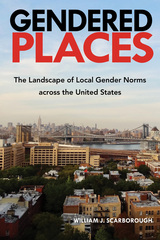 Gendered Places: The Landscape of Local Gender Norms across the United States
William J. Scarborough
Temple University Press, 2023 Every place has its quirky attributes, cultural reputation, and distinctive flair. But when we travel across America, do we also experience distinct gender norms and expectations? In his groundbreaking Gendered Places, William Scarborough examines metropolitan commuting zones to see how each region’s local culture reflects gender roles and gender equity. He uses surveys and social media data to measure multiple dimensions of gender norms, including expectations toward women in leadership, attitudes toward working mothers, as well as the division of household labor. Gendered Places reveals that different locations, even within the same region of the country, such as Milwaukee and Madison Wisconsin, have distinct gender norms and highly influential cultural environments. Scarboroughshows how these local norms shape the attitudes and behaviors of residents with implications on patterns of inequality such as the gender wage gap. His findings offer valuable insight for community leaders and organizers making efforts to promote equality in their region. Scarboroughrecognizes local culture as not value-neutral, but highly crucial to the gender structure that perpetuates, or challenges, gender inequality. Gendered Places questions how these gender norms are sustained and their social consequences.
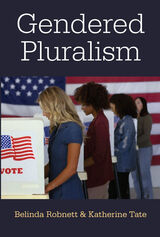 Gendered Pluralism
Belinda Robnett and Katherine Tate
University of Michigan Press, 2023 Focused on structural and political intersectionalities, Gendered Pluralism takes a broader approach to understanding the constellation of factors that drive gender and racial differences on an array of public policy issues. Belinda Robnett and Katherine Tate examine a broader set of actors absent the contextual factors that may drive them to compromise their opinions. Their study examines the ways in which (1) men and women differ on public policy issues and the factors that drive these differences; (2) whites and racial-ethnic minorities differ on public policy issues and the factors that drive these differences; (3) women differ on public policy issues and the factors that drive these differences; (4) African-American men and women differ on public policy issues and the factors that drive these differences; and (5) African-American women differ on public policy issues and the factors that drive these differences.
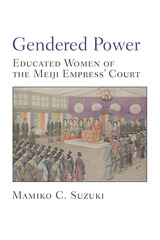 Gendered Power: Educated Women of the Meiji Empress' Court
Mamiko C. Suzuki
University of Michigan Press, 2019 Gendered Power sheds light on the sources of power for three prominent women of the Meiji period: Meiji Empress Haruko; public speaker, poet, and diarist Nakajima Shoen; and educator and prolific author Shimoda Utako. By focusing on the role Chinese classics (kanbun) played in the language employed by elite women, the chapters focus on how Empress Haruko, Shoen, and Shimoda Utako contributed new expectations for how women should participate in a modernizing Japan. By being in the public eye, all three women countered criticism of and commentary on their writings and activities, which they parried by navigating gender constraints. The success or failure as women ascribed to these three figures sheds light on the contradictions inhabited by them during a transformative period for Japanese women.
By proposing and interrogating the possibility of Meiji women’s power, the book examines contradictions that were symptomatic of their struggles within the vast social, cultural, and political transformations that took place during the period. The book demonstrates that an examination of that conflict within feminist history is crucial in order to understand what radical resistance meant in the face of women-centered authority.
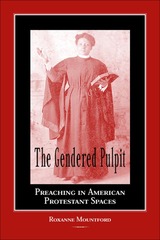 The Gendered Pulpit: Preaching in American Protestant Spaces
Roxanne Mountford
Southern Illinois University Press, 2005 In this feminist investigation into the art of preaching—one of the oldest and least studied rhetorical traditions—Roxanne Mountford explores the relationship between bodies, space, race, and gender in rhetorical performance and American Protestant culture. Refiguring delivery and physicality as significant components of the rhetorical situation, The Gendered Pulpit: Preaching in American Protestant Spaces examines the strategies of three contemporary women preachers who have transgressed traditions, rearranged rhetorical space, and conquered gender bias to establish greater intimacy with their congregations. Mountford’s examinations of the rhetoric inherent in preaching manuals from 1850 to the present provide insight into how “manliness” has remained a central concept in American preaching since the mid-nineteenth century. The manuals illustrate that the character, style, method of delivery, and theological purpose of preachers focused on white men and their cultural standing, leaving contemporary women preachers searching for ways to accommodate themselves to the physicality of preaching. Three case studies of women preachers who have succeeded or failed in rearranging rhetorical space provide the foundation for the volume. These contemporary examples have important implications for feminist theology and also reveal the importance of gender, space, and bodies to studies of rhetoric in general. Mountford explores the geographies of St. John’s Lutheran Church and the preaching of Rev. Patricia O’Connor who reformed rhetorical space through the delivery of her sermons. At Eastside United Church of Christ, Mountford shows, Rev. Barbara Hill employed narrative style and prophetic utterance in the tradition of black preaching to address gender bias and institute change in her congregation. The final case study details the experiences of Pastor Janet Moore and her struggles at Victory Hills United Methodist Church, where the fractured congregation could not be united even with Pastor Moore’s focus on theological purpose and invention strategies.
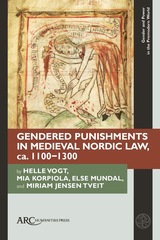 Gendered Punishments in Medieval Nordic Law, ca. 1100–1300
Helle Vogt
Arc Humanities Press, 2025 This book examines gendered punishments in medieval Nordic laws, ca. 1100–1300. By exploring legislation on violence, sorcery, sexual morality, and theft, it considers whether women were seen as independent legal subjects or as extensions of their families. It identifies various gendered punishments and discriminatory treatments, revealing regional differences and the influence of European legal ideologies. It also uncovers an emphasis on individual culpability for crimes, reflecting a shift from collective to individual responsibility and women’s increasing property rights. This comparative analysis offers a nuanced view of medieval Nordic law, highlighting the complex relationship between gender, law, and society during this transformative period. It explains how criminal law was influenced by canon law and German town law and offers new insights into the legal history of the Nordic region.
 Gendered Reputations and Aristocratic Partnership: Re-Presenting the Breton Civil War from the Fourteenth to Sixteenth Centuries
Erika Graham-Goering
Arc Humanities Press, 2025 Medieval rulership is increasingly understood as the exercise of shared power, and nowhere was this partnership more evident than between married couples. The study of reputation provides a new way of assessing how the expectations of martial lordship adapted to this joint authority. This book examines the messy legacies of Jeanne de Penthièvre and Charles de Blois, duchess and duke of Brittany, and their fight to claim the ducal title at the start of the Hundred Years’ War. Their story was retold across a prolonged period of political turbulence by successive generations of narrators, who justified legitimate leadership according to disparate standards of sanctity, chivalry, and dynasty. This process shows how the gendering of one reputation influenced the gendering of the other, and how aristocratic attitudes towards violent conflict worked through positive and negative models for both the women and the men in charge.
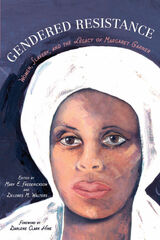 Gendered Resistance: Women, Slavery, and the Legacy of Margaret Garner
Edited by Mary E. Frederickson and Delores M. Walters
University of Illinois Press, 2013 Inspired by the searing story of Margaret Garner, the escaped slave who in 1856 slit her daughter's throat rather than have her forced back into slavery, the essays in this collection focus on historical and contemporary examples of slavery and women's resistance to oppression from the nineteenth century to the twenty-first. Each chapter uses Garner's example--the real-life narrative behind Toni Morrison's Beloved andthe opera Margaret Garner--as a thematic foundation for an interdisciplinary conversation about gendered resistance in locations including Brazil, Yemen, India, and the United States. Contributors are Nailah Randall Bellinger, Olivia Cousins, Mary E. Frederickson, Cheryl Janifer LaRoche, Carolyn Mazloomi, Cathy McDaniels-Wilson, Catherine Roma, Huda Seif, S. Pearl Sharp, Raquel Luciana de Souza, Jolene Smith, Veta Tucker, Delores M. Walters, Diana Williams, and Kristine Yohe.
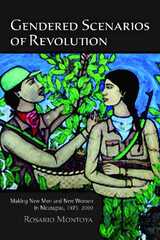 Gendered Scenarios of Revolution: Making New Men and New Women in Nicaragua, 1975–2000
Rosario Montoya
University of Arizona Press, 2012 In 1979, toward the end of the Cold War era, Nicaragua's Sandinista movement emerged on the world stage claiming to represent a new form of socialism. Gendered Scenarios of Revolution is a historical ethnography of Sandinista state formation from the perspective of El Tule-a peasant village that was itself thrust onto a national and international stage as a "model" Sandinista community. This book follows the villagers´ story as they joined the Sandinista movement, performed revolution before a world audience, and grappled with the lessons of this experience in the neoliberal aftermath. Employing an approach that combines political economy and cultural analysis, Montoya argues that the Sandinistas collapsed gender contradictions into class ones, and that as the Contra War exacerbated political and economic crises in the country, the Sandinistas increasingly ruled by mandate as vanguard party instead of creating the participatory democracy that they professed to work toward. In El Tule this meant that even though the Sandinistas created new roles and possibilities for women and men, over time they upheld pre-revolutionary patriarchal social structures. Yet in showing how the revolution created opportunities for Tuleños to assert their agency and advance their interests, even against the Sandinistas´ own interests, this book offers a reinterpretation of the revolution´s supposed failure. Examining this community’s experience in the Sandinista and post-Sandinista periods offers perspective on both processes of revolutionary transformation and their legacies in the neoliberal era. Gendered Scenarios of Revolution will engage graduate and undergraduate students and scholars in anthropology, sociology, history, and women’s and gender studies, and appeal to anyone interested in modern revolution and its aftermath.
Gendered Strife and Confusion: The Political Culture of Reconstruction
Laura F. Edwards
University of Illinois Press, 1997 Exploring the gendered dimension of political conflicts, Laura Edwards links transformations in private and public life in the era following the Civil War. Ideas about men's and women's roles within households shaped the ways groups of southerners—elite and poor, whites and blacks, Democrats and Republicans—envisioned the public arena and their own places in it. By using those on the margins to define the center, Edwards demonstrates that Reconstruction was a complicated process of conflict and negotiation that lasted long beyond 1877 and involved all southerners and every aspect of life.
Gendered Temporalities in the Early Modern World
Edited by Merry Wiesner-Hanks
Amsterdam University Press, 2018 Is time gendered? This international, interdisciplinary anthology studies the early modern era to analyse how material objects express, shape, complicate, and extend human concepts of time and how people commemorate time differently. It examines conceptual aspects of time, such as the categories women and men use to define it, and the somatic, lived experiences of time ranging between an instant and the course of family life. Drawing on a wide array of textual and material primary sources, this book assesses the ways that gender and other categories of difference affect understandings of time.
 Gendered Tradeoffs: Women, Family, and Workplace Inequality in Twenty-One Countries
Becky Pettit
Russell Sage Foundation, 2009 Gender inequality in the workplace persists, even in nations with some of the most progressive laws and generous family support policies. Yet the dimensions on which inequality is measured—levels of women's employment, number of hours worked, sex segregation by occupations and wages—tell very different stories across industrialized nations. By examining federally guaranteed parental leave, publicly provided child care, and part-time work, and looking across multiple dimensions of inequality, Becky Pettit and Jennifer Hook document the links between specific policies and aggregate outcomes. They disentangle the complex factors, from institutional policies to personal choices, that influence economic inequality. Gendered Tradeoffsdraws on data from twenty-one industrialized nations to compare women's and men's economic outcomes across nations, and over time, in search of a deeper understanding of the underpinnings of gender inequality in different labor markets. Pettit and Hook develop the idea that there are tradeoffs between different aspects of gender inequality in the economy and explain how those tradeoffs are shaped by individuals, markets, and states. They argue that each policy or condition should be considered along two axes—whether it promotes women's inclusion in or exclusion from the labor market and whether it promotes gender equality or inequality among women in the labor market. Some policies advance one objective while undercutting the other. The volume begins by reflecting on gender inequality in labor markets measured by different indicators. It goes on to develop the idea that there may be tradeoffs inherent among different aspects of inequality and in different policy solutions. These ideas are explored in four empirical chapters on employment, work hours, occupational sex segregation, and the gender wage gap. The penultimate chapter examines whether a similar framework is relevant for understanding inequality among women in the United States and Germany. The book concludes with a thorough discussion of the policies and conditions that underpin gender inequality in the workplace. The central thesis of Gendered Tradeoffs is that gender inequality in the workplace is generated and reinforced by national policies and conditions. The contours of inequality across and within countries are shaped by specific aspects of social policy that either relieve or concentrate the demands of care giving within households—usually in the hands of women—and at the same time shape workplace expectations. Pettit and Hook make a strong case that equality for women in the workplace depends not on whether women are included in the labor market but on how they are included.
Gendered Transformations: Theory and Practices on Gender and Media
Edited by Tonny Krijnen, Claudia Alvares, and Sofie Van Bauwel
Intellect Books, 2011 Comprising the most current scholarship from leading experts in the fields of gender and media studies, Gendered Transformations offers readers a new foundation from which to reexamine traditional perspectives on gender. Organized into sections concerning representational politics, embodied performance, and social constructions of reality, these essays explore a wide variety of concerns from a similarly wide variety of perspectives, from essentialist to anti-essentialist. A thought-provoking contribution to a number of disparate fields, Gendered Transformations offers a rare interdisciplinary approach to gender that reflects the most recent developments in media theory and methodology.
Gendered Vulnerability: How Women Work Harder to Stay in Office
Jeffrey Lazarus and Amy Steigerwalt
University of Michigan Press, 2018 Gendered Vulnerability examines the factors that make women politicians more electorally vulnerable than their male counterparts. These factors combine to convince women that they must work harder to win elections—a phenomenon that Jeffrey Lazarus and Amy Steigerwalt term “gendered vulnerability.” Since women feel constant pressure to make sure they can win reelection, they devote more of their time and energy to winning their constituents’ favor. Lazarus and Steigerwalt examine different facets of legislative behavior, finding that female members do a better job of representing their constituents than male members.
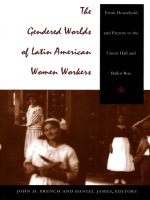 The Gendered Worlds of Latin American Women Workers: From Household and Factory to the Union Hall and Ballot Box
John D. French and Daniel James, eds.
Duke University Press, 1997 The Gendered Worlds of Latin American Women Workers examines the lives of Latin American women who entered factory labor in increasing numbers in the early part of the twentieth century. Emphasizing the integration of traditional labor history topics with historical accounts of gender, female subjectivity, and community, this volume focuses on the experience of working women at mid-century, especially those laboring in the urban industrial sector. In its exploration of working women’s agency and consciousness, this collection offers rich detail regarding women’s lives as daughters, housewives, mothers, factory workers, trade union leaders, and political activists. Widely seen as a hostile sexualized space, the modern factory was considered a threat, not only to the virtue of working women, but also to the survival of the family, and thus, the future of the nation. Yet working-class women continued to labor outside the home and remained highly visible in the expanding world of modern industry. In nine essays dealing with Argentina, Brazil, Chile, Colombia, and Guatemala, the contributors make extensive use of oral histories to describe the contradictory experiences of women whose work defied gender prescriptions but was deemed necessary by working-class families in a world of need and scarcity. The volume includes discussion of previously neglected topics such as single motherhood, women’s struggle against domestic violence, and the role of women as both desiring and desired subjects. Contributors. Ann Farnsworth-Alvear, Mary Lynn Pedersen Cluff, John D. French, Daniel James, Thomas Miller Klubock, Deborah Levenson-Estrada, Mirta Zaida Lobato, Heidi Tinsman, Theresa R. Veccia, Barbara Weinstein
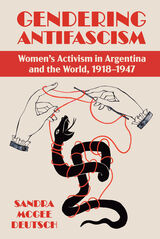 Gendering Anti-facism: Women Activism in Argentina and the World, 1918-1947
Sandra Deutsch
University of Pittsburgh Press, 2023 Winner of the 2024 Thomas McGann Award for Outstanding Monograph on Latin American History
A History of the Women’s Antifascism Movement in Argentina that Contains Lessons for Opposing Fascism Today
Argentine women’s long resistance to extreme rightists, tyranny, and militarism culminated in the Junta de la Victoria, or Victory Board, a group that organized in the aftermath of the German invasion of the Soviet Union in defiance of the neutralist and Axis-leaning government in Argentina. A sewing and knitting group that provided garments and supplies for the Allied armies in World War II, the Junta de la Victoria was a politically minded association that mobilized women in the fight against fascism. Without explicitly characterizing itself as feminist, the organization promoted women’s political rights and visibility and attracted forty-five thousand members. The Junta ushered diverse constituencies of Argentine women into political involvement in an unprecedented experiment in pluralism, coalition-building, and political struggle. Sandra McGee Deutsch uses this internationally minded but local group to examine larger questions surrounding the global conflict between democracy and fascism.
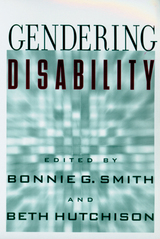 Gendering Disability
Smith, Bonnie G
Rutgers University Press, 2004 Disability and gender, terms that have previously seemed so clear-cut, are becoming increasingly complex in light of new politics and scholarship. These words now suggest complicated sets of practices and ways of being.
Contributors to this innovative collection explore the intersection of gender and disability in the arts, consumer culture, healing, the personal and private realms, and the appearance of disability in the public sphere—both in public fantasies and in public activism. Beginning as separate enterprises that followed activist and scholarly paths, gender and disability studies have reached a point where they can move beyond their boundaries for a common landscape to inspire new areas of inquiry. Whether from a perspective in the humanities, social sciences, sciences, or arts, the shared subject matter of gender and disability studies—the body, social and cultural hierarchy, identity, discrimination and inequality, representation, and political activism—insistently calls for deeper conversation. This volume provides fresh findings not only about the discrimination practiced against women and people with disabilities, but also about the productive parallelism between these two categories.
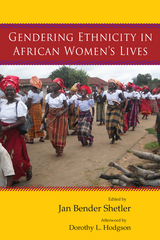 Gendering Ethnicity in African Women’s Lives
Edited by Jan Bender Shetler
University of Wisconsin Press, 2015 Do African men and women think about and act out their ethnicity in different ways? Most studies of ethnicity in Africa consider men’s experiences, but rarely have scholars examined whether women have the same idea of what it means to be, for example, Igbo or Tswana or Kikuyu. Or, studies have invoked the adage “women have no tribe” to indicate a woman’s loss of ethnicity as she marries into her husband’s community. This volume engages directly the issue of women’s ethnicity and makes stimulating contributions to debates about how and why women’s movements have a unifying role in African political organization and peace movements.
Drawing on extensive field research in many different regions of Africa, the contributors demonstrate in their essays that women do make choices about the forms of ethnicity they embrace, creating alternatives to male-centered definitions—in some cases rejecting a specific ethnic identity in favor of an interethnic alliance, in others reinterpreting the meaning of ethnicity within gendered domains, and in others performing ethnic power in gendered ways. Their analysis helps explain why African women may be more likely to champion interethnic political movements while men often promote an ethnicity based on martial masculinity. Bringing together anthropologists, historians, linguists, and political scientists, Gendering Ethnicity in African Women’s Lives offers a diverse and timely look at a neglected but important topic.
Gendering Historiography: Beyond National Canons
Edited by Angelika Epple and Angelika Schaser
Campus Verlag, 2009 Comparing various European and American historiographies from the past two hundred years, Gendering Historiography provides insights into the establishment and cultivation of gendered power relations in different societies and outlines the devastating effects that exclusionary practices can have on each national canon. This detailed and revealing book will change the face of history writing, bringing overlooked and previously excluded histories back into modern historiography.
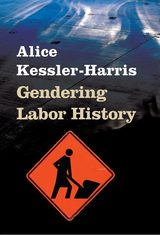 Gendering Labor History
Alice Kessler-Harris
University of Illinois Press, 2006 This collection represents the thirty-year intellectual trajectory of one of today’s leading historians of gender and labor in the United States. The seventeen essays are divided into four sections, narrating the evolution and refinement of Alice Kessler-Harris's central project: showing gender’s fundamental importance in the shaping of United States history and working class culture. The first section considers women and organized labor while the second pushes this analysis toward a gendered labor history as the essays consider the gendering of male as well as female workers and how gender operates with and within the social category of class. Subsequent sections broaden this framework to examine U.S. social policy as a whole, the question of economic citizenship, and wage labor from a global perspective. While each essay represents an important intervention in American historiography in itself, the collection taken as a whole shows Kessler-Harris continuing to push the field of American history to greater levels of inclusion and analysis.
 Gendering Modern Japanese History
Barbara Molony
Harvard University Press, 2005 In the past quarter-century, gender has emerged as a lively area of inquiry for historians and other scholars, and gender analysis has suggested important revisions of the “master narratives” of national histories—the dominant, often celebratory tales of the successes of a nation and its leaders. Although modern Japanese history has not yet been restructured by a foregrounding of gender, historians of Japan have begun to embrace gender as an analytic category.
The sixteen chapters in this volume treat men as well as women, theories of sexuality as well as gender prescriptions, and same-sex as well as heterosexual relations in the period from 1868 to the present. All of them take the position that history is gendered; that is, historians invariably, perhaps unconsciously, construct a gendered notion of past events, people, and ideas. Together, these essays construct a history informed by the idea that gender matters because it was part of the experience of people and because it often has been a central feature in the construction of modern ideologies, discourses, and institutions. Separately, each chapter examines how Japanese have (en)gendered their ideas, institutions, and society.
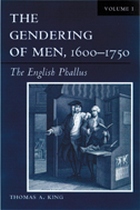 The Gendering of Men, 1600–1750: The English Phallus
Thomas A. King
University of Wisconsin Press, 2004 Taking on nothing less than the formation of modern genders and sexualities, Thomas A. King develops a history of the political and performative struggles that produced both normative and queer masculinities in the seventeenth and eighteenth centuries. The result is a major contribution to gender studies, gay studies, and theater and performance history.
The Gendering of Men, 1600–1750 traces the transition from a society based on alliance, which had subordinated all men, women, and boys to higher ranked males, to one founded in sexuality, through which men have embodied their claims to personal and political privacy. King proposes that the male body is a performative production marking men’s resistance to their subjection within patriarchy and sovereignty. Emphasizing that categories of gender must come under historical analysis, The Gendering of Men explores men’s particpation in an ongoing struggle for access to a universal manliness transcending other biological and social differentials.
This is volume one of two projected volumes.
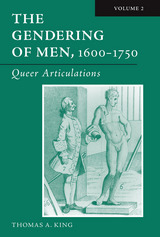 The Gendering of Men, 1600–1750: Volume 2, Queer Articulations
Thomas A. King
University of Wisconsin Press, 2008 The queer man’s mode of embodiment—his gestural and vocal style, his posture and gait, his occupation of space—remembers a political history. To gesture with the elbow held close to the body, to affect a courtly lisp, or to set an arm akimbo with the hand turned back on the hip is to cite a history in which the sovereign body became the effeminate and sodomitical and, finally, the homosexual body. In Queer Articulations, Thomas A. King argues that the Anglo-American queer body publicizes a history of resistance to the gendered terms whereby liberal subjectivities were secured in early modern England.
Arguing that queer agency preceded and enabled the formulation of queer subjectivities, Queer Articulations investigates theatricality and sodomy as performance practices foreclosed in the formation of gendered privacy and consequently available for resistant uses by male-bodied persons who have been positioned, or who have located themselves, outside the universalized public sphere of citizen-subjects. By defining queerness as the lack or failure of private pleasures, rather than an alternative pleasure or substance in its own right, eighteenth-century discourses reconfigured publicness as the mark of difference from the naturalized, private bodies of liberal subjects.
Inviting a performance-centered, interdisciplinary approach to queer/male identities, King develops a model of queerness as processual activity, situated in time and place but irreducible to the individual subject's identifications, desires, and motivations.
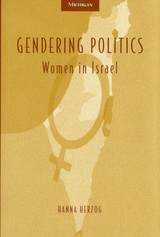 Gendering Politics: Women in Israel
Hanna Herzog
University of Michigan Press, 1999 What are the cultural and structural mechanisms that exclude women from politics in general and from local politics in particular? What meaning is ascribed to women's political activity?
Gendering Politics explores the place of women in democratic politics by means of a detailed study of women in Israeli politics who were elected to municipal councils from 1950 to 1989. Drawing from a variety of sources, including questionnaires, interviews, newspaper coverage, and existing statistical data, as well as examinations of studies of the role of women in politics in other democracies, Herzog analyzes the extent of success and failure of women in Israeli elections. She then explores reasons why female participation in Israeli politics has been relatively slight, despite historical precedents and social circumstances that would indicate otherwise.
The author examines the gendered bias of the power structure as it is shaped by basic cultural organizing principles. She exposes hidden assumptions--and notes the overt assumptions--which by definition exclude women from politics. The author also looks at the structure of opportunities within the prevailing political system, uncovering the relevant blocking and facilitating elements.
Gendering Politics will be of interest to students and scholars of women's studies, Israeli studies, political sociology, and political science.
Hanna Herzog is Associate Professor of Sociology, Tel Aviv University.
 Gendering the Fair: Histories of Women and Gender at World's Fairs
Edited by TJ Boisseau and Abigail M. Markwyn
University of Illinois Press, 2010 This field-defining work opens the study of world's fairs to women's and gender history, exploring the intersections of masculinity, femininity, exoticism, display, and performance at these influential events. As the first global gatherings of mass numbers of attendees, world's fairs and expositions introduced cross-class, multi-racial, and mixed-sex audiences to each other, as well as to cultural concepts and breakthroughs in science and technology. Gendering the Fair focuses on the manipulation of gender ideology as a crucial factor in the world's fairs' incredible power to shape public opinions of nations, government, and culture. Established and rising scholars working in a variety of disciplines and locales discuss how gender played a role in various countries' exhibits and how these nations capitalized on opportunities to revise national and international understandings of womanhood. Spanning several centuries and extending across the globe from Portugal to London and from Chicago to Paris, the essays cover topics including women's work at the fairs; the suffrage movement; the intersection of faith, gender, and patriotism; and the ability of fair organizers to manipulate fairgoers' experience of the fairgrounds as gendered space. The volume includes a foreword by preeminent world's fair historian Robert W. Rydell. Contributors are TJ Boisseau, Anne Clendinning, Lisa K. Langlois, Abigail M. Markwyn, Sarah J. Moore, Isabel Morais, Mary Pepchinski, Elisabeth Israels Perry, Andrea G. Radke-Moss, Alison Rowley, and Anne Wohlcke.
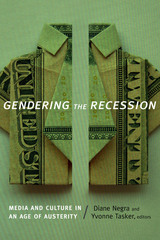 Gendering the Recession: Media and Culture in an Age of Austerity
Diane Negra and Yvonne Tasker, eds.
Duke University Press, 2014 This timely, necessary collection of essays provides feminist analyses of a recession-era media culture characterized by the reemergence and refashioning of familiar gender tropes, including crisis masculinity, coping women, and postfeminist self-renewal. Interpreting media forms as diverse as reality television, financial journalism, novels, lifestyle blogs, popular cinema, and advertising, the contributors reveal gendered narratives that recur across media forms too often considered in isolation from one another. They also show how, with a few notable exceptions, recession-era popular culture promotes affective normalcy and transformative individual enterprise under duress while avoiding meaningful critique of the privileged white male or the destructive aspects of Western capitalism. By acknowledging the contradictions between political rhetoric and popular culture, and between diverse screen fantasies and lived realities, Gendering the Recession helps to make sense of our postboom cultural moment.
Contributors. Sarah Banet-Weiser, Hamilton Carroll, Hannah Hamad, Anikó Imre, Suzanne Leonard, Isabel Molina-Guzmán, Sinéad Molony, Elizabeth Nathanson, Diane Negra, Tim Snelson, Yvonne Tasker, Pamela Thoma
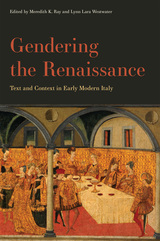 Gendering the Renaissance: Text and Context in Early Modern Italy
Meredith K. Ray
University of Delaware Press, 2023 The essays in this volume revisit the Italian Renaissance to rethink spaces thought to be defined and certain: from the social spaces of convent, court, or home, to the literary spaces of established genres such as religious plays or epic poetry. Repopulating these spaces with the women who occupied them but have often been elided in the historical record, the essays also remind us to ask what might obscure our view of texts and archives, what has remained marginal in the texts and contexts of early modern Italy and why. The contributors, suggesting new ways of interrogating gendered discourses of genre, identities, and sanctity, offer a complex picture of gender in early modern Italian literature and culture. Read in dialogue with one another, their pieces provide a fascinating survey of currents in gender studies and early modern Italian studies and point to exciting future directions in these fields.
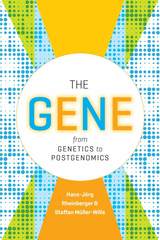 The Gene: From Genetics to Postgenomics
Hans-Jörg Rheinberger and Staffan Müller-Wille
University of Chicago Press, 2018 Few concepts played a more important role in twentieth-century life sciences than that of the gene. Yet at this moment, the field of genetics is undergoing radical conceptual transformation, and some scientists are questioning the very usefulness of the concept of the gene, arguing instead for more systemic perspectives.
The time could not be better, therefore, for Hans-Jörg Rheinberger and Staffan Müller-Wille's magisterial history of the concept of the gene. Though the gene has long been the central organizing theme of biology, both conceptually and as an object of study, Rheinberger and Müller-Wille conclude that we have never even had a universally accepted, stable definition of it. Rather, the concept has been in continual flux—a state that, they contend, is typical of historically important and productive scientific concepts. It is that very openness to change and manipulation, the authors argue, that made it so useful: its very mutability enabled it to be useful while the technologies and approaches used to study and theorize about it changed dramatically.
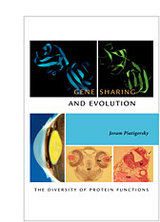 Gene Sharing and Evolution: The Diversity of Protein Functions
Joram Piatigorsky
Harvard University Press, 2007 "Gene sharing" means that the different functions of a protein may share the same gene--that is, a protein produced by a gene evolved to fulfill a specialized function for one biological role may also perform alternate functions for other biological roles.
In the 1980s and early 1990s, Joram Piatigorsky and colleagues coined the term "gene sharing" to describe the use of multifunctional proteins as crystallins in the eye lens. In Gene Sharing and Evolution Piatigorsky explores the generality and implications of gene sharing throughout evolution and argues that most if not all proteins perform a variety of functions in the same and in different species, and that this is a fundamental necessity for evolution.
How is a gene identified, by its structure or its function? Do the boundaries of a gene include its regulatory elements? What is the influence of gene expression on natural selection of protein functions, and how is variation in gene expression selected in evolution? These are neither new nor resolved questions. Piatigorsky shows us that the extensiveness of gene sharing and protein multifunctionality offers a way of responding to these questions that sheds light on the complex interrelationships among genes, proteins, and evolution.
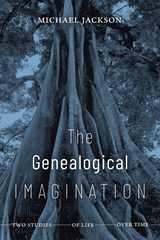 The Genealogical Imagination: Two Studies of Life over Time
Michael Jackson
Duke University Press, 2021 In The Genealogical Imagination Michael Jackson juxtaposes ethnographic and imaginative writing to explore intergenerational trauma and temporality. Drawing on over fifty years of fieldwork, Jackson recounts the 150-year history of a Sierra Leone family through its periods of prosperity and powerlessness, war and peace, jihad and migration. Jackson also offers a fictionalized narrative loosely based on his family history and fieldwork in northeastern Australia that traces how the trauma of wartime in one generation can reverberate into the next. In both stories Jackson reflects on different modes of being-in-time, demonstrating how genealogical time flows in stops and starts—linear at times, discontinuous at others—as current generations reckon with their relationships to their ancestors. Genealogy, Jackson demonstrates, becomes a powerful model for understanding our experience of being-in-the-world, as nobody can escape kinship and the pull of the past. Unconventional and evocative, The Genealogical Imagination offers a nuanced account of how lives are lived, while it pushes the bounds of the forms that scholarship can take.
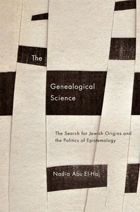 The Genealogical Science: The Search for Jewish Origins and the Politics of Epistemology
Nadia Abu El-Haj
University of Chicago Press, 2012 The Genealogical Science analyzes the scientific work and social implications of the flourishing field of genetic history. A biological discipline that relies on genetic data in order to reconstruct the geographic origins of contemporary populations—their histories of migration and genealogical connections to other present-day groups—this historical science is garnering ever more credibility and social reach, in large part due to a growing industry in ancestry testing. In this book, Nadia Abu El-Haj examines genetic history’s working assumptions about culture and nature, identity and biology, and the individual and the collective. Through the example of the study of Jewish origins, she explores novel cultural and political practices that are emerging as genetic history’s claims and “facts” circulate in the public domain and illustrates how this historical science is intrinsically entangled with cultural imaginations and political commitments. Chronicling late-nineteenth- to mid-twentieth-century understandings of race, nature, and culture, she identifies continuities and shifts in scientific claims, institutional contexts, and political worlds in order to show how the meanings of biological difference have changed over time. In so doing she gives an account of how and why it is that genetic history is so socially felicitous today and elucidates the range of understandings of the self, individual and collective, this scientific field is making possible. More specifically, through her focus on the history of projects of Jewish self-fashioning that have taken place on the terrain of the biological sciences, The Genealogical Science analyzes genetic history as the latest iteration of a cultural and political practice now over a century old.
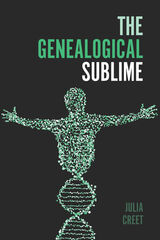 The Genealogical Sublime
Julia Creet
University of Massachusetts Press, 2020 Since the early 2000s, genealogy has become a lucrative business, an accelerating online industry, a massive data mining project, and fodder for reality television. But the fact remains that our contemporary fascination with family history cannot be understood independently of the powerful technological tools that aid and abet in the search for traces of blood, belonging, and difference.
In The Genealogical Sublime, Julia Creet traces the histories of the largest, longest-running, most lucrative, and most rapidly growing genealogical databases to delineate a broader history of the industry. As each unique case study reveals, new database and DNA technologies enable an obsessive completeness—the desire to gather all of the world's genealogical records in the interests of life beyond death. Archival research and firsthand interviews with Church of Jesus Christ of Latter-day Saints officials, key industry players (including Ancestry.com founders and Family Search executives), and professional and amateur family historians round out this timely and essential study.
 Genealogy and Literature
Lee Quinby, Editor
University of Minnesota Press, 1995
Genealogy and Literature was first published in 1995. Minnesota Archive Editions uses digital technology to make long-unavailable books once again accessible, and are published unaltered from the original University of Minnesota Press editions.
Traditionalists insist that literature transcends culture. Others counter that it is subversive by nature. By challenging both claims, Genealogy and Literature reveals the importance of literature for understanding dominant and often violent power/knowledge relations within a given society.
The authors explore the ways in which literature functions as a cultural practice, the links between death and literature as a field of discourse, and the possibilities of dismantling modes of bodily regulation. Through wide-ranging investigations of writing from England, France, Nigeria, Peru, Japan, and the United States, they reinvigorate the study of literature as a means of understanding the complexities of everyday experience.
Contributors: Claudette Kemper Columbus, Lennard J. Davis, Simon During, Michel Foucault, Ellen J. Goldner, Tom Hayes, Kate Mehuron, Donald Mengay, Imafedia Okhamafe, Lee Quinby, José David Saldivar, Malini Johar Schueller.
Lee Quinby is professor of English and American studies at Hobart and William Smith Colleges. She is the author of Anti-Apocalypse: Exercises in Genealogical Criticism (Minnesota, 1994).
 Genealogy and Status: Hereditary Office Holding and Kinship in North China under Mongol Rule
Tomoyasu Iiyama
Harvard University Press, 2023 By shedding light on a long-forgotten epigraphic genre that flourished in North China during the Mongol Empire, or Yuan Dynasty (1271–1368), Genealogy and Status explores the ways the conquered Chinese people understood and represented the alien Mongol ruling principles through their own cultural tradition. This epigraphic genre, which this book collectively calls “genealogical steles,” was quite unique in the history of Chinese epigraphy.
Northern Chinese officials commissioned these steles exclusively to record a family’s extensive genealogy, rather than the biography or achievements of an individual. Tomoyasu Iiyama shows how the rise of these steles demonstrates that Mongol rule fundamentally affected how northern Chinese families defined, organized, and commemorated their kinship. Because most of these inscriptions are in Classical Chinese, they appear to be part of Chinese tradition. In fact, they reflect a massive social change in Chinese society that occurred because of Mongol rule in China.
The evolution of genealogical steles delineates how local elites, while thinking of themselves as the heirs of traditional Chinese culture, fully accommodated to Mongol imperial rule and became instead one of its cornerstones in eastern Eurasia.
 The Genealogy of Genealogy: Nietzsche, Foucault, and the Coils of Critical History
Jason Ananda Josephson Storm
University of Chicago Press A daring reassessment of the critical method that reshaped the humanities—and an invitation to imagine new ways of doing history.
The genealogical method—a mode of historical analysis that shows that what looks timeless is in fact contingent, bound to shifting relations of meaning, knowledge, and power—has become the dominant paradigm of humanistic inquiry. In The Genealogy of Genealogy, Jason Ānanda Josephson Storm turns this influential practice back on itself, tracing its unlikely rise through Nietzsche and Foucault and uncovering its suppressed ties to eugenics and racism. He rethinks the very stakes of critical history and proposes new tools for thinking about historical continuity, change, and difference.
Provocative and timely, The Genealogy of Genealogy offers both a diagnosis and a vision, challenging scholars across the humanities and social sciences to rethink how we write history and whether our most trusted methods are fit for the futures we seek to build.
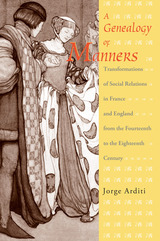 A Genealogy of Manners: Transformations of Social Relations in France and England from the Fourteenth to the Eighteenth Century
Jorge Arditi
University of Chicago Press, 1998 Remarkable for its scope and erudition, Jorge Arditi's new study offers a fascinating history of mores from the High Middle Ages to the Enlightenment. Drawing on the pioneering ideas of Norbert Elias, Michel Foucault, and Pierre Bourdieu, Arditi examines the relationship between power and social practices and traces how power changes over time.
Analyzing courtesy manuals and etiquette books from the thirteenth to the eighteenth century, Arditi shows how the dominant classes of a society were able to create a system of social relations and put it into operation. The result was an infrastructure in which these classes could successfully exert power. He explores how the ecclesiastical authorities of the Middle Ages, the monarchies from the fifteenth through the seventeenth century, and the aristocracies during the early stages of modernity all forged their own codes of manners within the confines of another, dominant order. Arditi goes on to describe how each of these different groups, through the sustained deployment of their own forms of relating with one another, gradually moved into a position of dominance.
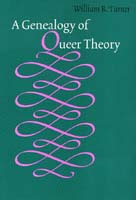 Genealogy Of Queer Theory
William Turner
Temple University Press, 2000 Who are queers and what do they want? Could it be that we are all queers? Beginning with such questions, William B. Turner's lucid and engaging book traces the roots of queer theory to the growing awareness that few of us precisely fit standard categories for sexual and gender identity.
Turner shows how Michal Foucault's work contributed to feminists' investigations into the ways that power relates to identity. In the last decades of the twentieth century, feminists were the first to challenge the assumption that a claim to universal identity -- the white male citizen -- should serve as the foundation of political thought and action. Difference matters. Race, ethnicity, class, gender, and sexuality interact, producing a wide array of identities that resist rigid definition and are mutable. By understanding the notion of transhistorical categories -- woman, man, homosexual, and so forth -- feminist and gay male scholars launched queer theoretical work as a new way to think about the politics of gender and sexuality.
A Geneology of Queer Theory probes the fierce debates among scholars and activists, weighing the charges that queer readings of texts and identity politics do not constitute and might inhibit radical social change. Written by a historian, it considers the implications of queer theory for historical inquiry and the distinction between philosophy and history. As such, the book will interest readers of gay/lesbian/bisexual/transgender studies, intellectual history, political theory, and the history of gender/sexuality.
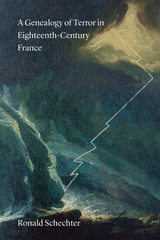 A Genealogy of Terror in Eighteenth-Century France
Ronald Schechter
University of Chicago Press, 2018 In contemporary political discourse, it is common to denounce violent acts as “terroristic.” But this reflexive denunciation is a surprisingly recent development. In A Genealogy of Terror in Eighteenth-Century France, Ronald Schechter tells the story of the term’s evolution in Western thought, examining a neglected yet crucial chapter of our complicated romance with terror.
For centuries prior to the French Revolution, the word “terror” had largely positive connotations. Subjects flattered monarchs with the label “terror of his enemies.” Lawyers invoked the “terror of the laws.” Theater critics praised tragedies that imparted terror and pity. By August 1794, however, terror had lost its positive valence. As revolutionaries sought to rid France of its enemies, terror became associated with surveillance committees, tribunals, and the guillotine. By unearthing the tradition that associated terror with justice, magnificence, and health, Schechter helps us understand how the revolutionary call to make terror the order of the day could inspire such fervent loyalty in the first place—even as the gratuitous violence of the revolution eventually transformed it into the dreadful term we would recognize today. Most important, perhaps, Schechter proposes that terror is not an import to Western civilization—as contemporary discourse often suggests—but rather a domestic product with a long and consequential tradition.
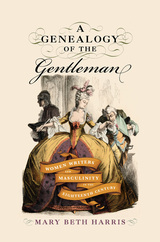 A Genealogy of the Gentleman: Women Writers and Masculinity in the Eighteenth Century
Mary Beth Harris
University of Delaware Press, 2024 A Genealogy of the Gentleman argues that eighteenth-century women writers made key interventions in modern ideals of masculinity and authorship through their narrative constructions of the gentleman. It challenges two latent critical assumptions: first, that the gentleman’s masculinity is normative, private, and therefore oppositional to concepts of performance; and second, that women writers, from their disadvantaged position within a patriarchal society, had no real means of influencing dominant structures of masculinity. By placing writers such as Mary Davys, Eliza Haywood, Charlotte Lennox, Elizabeth Inchbald, and Mary Robinson in dialogue with canonical representatives of the gentleman author—Joseph Addison and Richard Steele, David Hume, Samuel Johnson, and Samuel Richardson—Mary Beth Harris shows how these women carved out a space for their literary authority not by overtly opposing their male critics and society’s patriarchal structure, but by rewriting the persona of the gentleman as a figure whose very desirability and appeal were dependent on women’s influence. Ultimately, this project considers the import of these women writers’ legacy, both progressive and conservative, on hegemonic standards of masculinity that persist to this day.
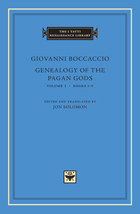 Genealogy of the Pagan Gods
Giovanni Boccaccio
Harvard University Press, 2011 Giovanni Boccaccio’s Genealogy of the Pagan Gods is an ambitious work of humanistic scholarship whose goal is to plunder ancient and medieval literary sources so as to create a massive synthesis of Greek and Roman mythology. The work also contains a famous defense of the value of studying ancient pagan poetry in a Christian world.
The complete work in fifteen books contains a meticulously organized genealogical tree identifying approximately 950 Greco-Roman mythological figures. The scope is enormous: 723 chapters include over a thousand citations from two hundred Greek, Roman, medieval, and Trecento authors. Throughout the Genealogy, Boccaccio deploys an array of allegorical, historical, and philological critiques of the ancient myths and their iconography.
Much more than a mere compilation of pagan myths, the Genealogy incorporates hundreds of excerpts from and comments on ancient poetry, illustrative of the new spirit of philological and cultural inquiry emerging in the early Renaissance. It is at once the most ambitious work of literary scholarship of the early Renaissance and a demonstration to contemporaries of the moral and cultural value of studying ancient poetry. This is the first volume of a projected three-volume set of Boccaccio’s complete Genealogy.
 Genealogy of the Pagan Gods
Giovanni Boccaccio
Harvard University Press, 2011 Genealogy of the Pagan Gods by Giovanni Boccaccio (1313–1375) is an ambitious work of humanistic scholarship whose goal is to plunder ancient and medieval literary sources so as to create a massive synthesis of Greek and Roman mythology. The work also contains a famous defense of the value of studying ancient pagan poetry in a Christian world.
The complete work in fifteen books contains a meticulously organized genealogical tree identifying approximately 950 Greco-Roman mythological figures. The scope is enormous: 723 chapters include over a thousand citations from 200 Greek, Roman, medieval, and Trecento authors. Throughout the Genealogy, Boccaccio deploys an array of allegorical, historical, and philological critiques of the ancient myths and their iconography.
Much more than a mere compilation of pagan myths, the Genealogy incorporates hundreds of excerpts from and comments on ancient poetry, illustrative of the new spirit of philological and cultural inquiry emerging in the early Renaissance. It is at once the most ambitious work of literary scholarship of the early Renaissance and a demonstration to contemporaries of the moral and cultural value of studying ancient poetry.
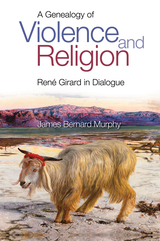 A Genealogy of Violence and Religion: Rene Girard in Dialogue
James Bernard Murphy
Sussex Academic Press, 2022 Why are religious rituals, symbols, and rhetoric so full of images of blood, sacrifice, and death? Why does religious fervor so often lead to Holy War, Crusade, and Jihad? No wonder many people assume that religion tends to give rise to violence. But what if it were the other way around? What if violence actually gave rise to religion? So argued the French literary theorist and anthropologist Rene Girard (1923-2015). Described as the Darwin of the human sciences, he was elected to the French Academy in 2005 for his seminal theories of sacred violence. Girard argued that religious practices function to sublimate, regulate, and discharge human violence in controlled rituals.Political philosopher James Bernard Murphy presents here a series of sharp and witty dialogues in which Girard attempts to defend his ideas against attacks by rival theorists, among them, Sigmund Freud, William James, Simone Weil, Elias Canetti, and Joseph de Maistre. Whatever we might think of his answers, Girard asks challenging, unsettling questions. In these illuminating and lively exchanges, Girard squares off with the titans of social theory.
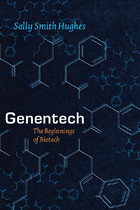 Genentech: The Beginnings of Biotech
Sally Smith Hughes
University of Chicago Press, 2011 In the fall of 1980, Genentech, Inc., a little-known California genetic engineering company, became the overnight darling of Wall Street, raising over $38 million in its initial public stock offering. Lacking marketed products or substantial profit, the firm nonetheless saw its share price escalate from $35 to $89 in the first few minutes of trading, at that point the largest gain in stock market history. Coming at a time of economic recession and declining technological competitiveness in the United States, the event provoked banner headlines and ignited a period of speculative frenzy over biotechnology as a revolutionary means for creating new and better kinds of pharmaceuticals, untold profit, and a possible solution to national economic malaise. Drawing from an unparalleled collection of interviews with early biotech players, Sally Smith Hughes offers the first book-length history of this pioneering company, depicting Genentech’s improbable creation, precarious youth, and ascent to immense prosperity. Hughes provides intimate portraits of the people significant to Genentech’s science and business, including cofounders Herbert Boyer and Robert Swanson, and in doing so sheds new light on how personality affects the growth of science. By placing Genentech’s founders, followers, opponents, victims, and beneficiaries in context, Hughes also demonstrates how science interacts with commercial and legal interests and university research, and with government regulation, venture capital, and commercial profits. Integrating the scientific, the corporate, the contextual, and the personal, Genentech tells the story of biotechnology as it is not often told, as a risky and improbable entrepreneurial venture that had to overcome a number of powerful forces working against it.
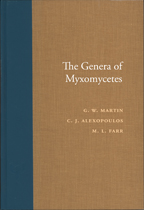 Genera Of The Myxomycetes
George W. Martin
University of Iowa Press, 1983 Social historians today are calling into question the persuasiveness of the master narratives that have dominated our stories about the past. Motivated now by personal and professional commitments to solving problems by telling stories, not by epistemological and ontological certitude, social historians are constructing alternative narratives relevant to an expanded, more inclusive audience. The essays in this thoughtful volume reflect an explicit self-consciousness about historians' choices of narrative strategies, a new skepticism of the rhetorical strategies embedded in all scholarly arguments, and a recognition that every historian has a point of view.
Critically examining past master narratives in light of emerging alternatives, these essayists ask us to reevaluate the stories we tell, the narrative traditions within which they are situated, and the audiences they are designed to persuade. The first essays explore the gendered character of social history rhetoric by exposing alternative, feminist traditions of social scientific and social historical writing. The second section focuses on alternative narrative traditions of historical writing in non-European contexts, specifically India, Japan, and China. And the third group spotlights the rhetorical uses of synthesis in the writings of social historians.
The essays feature the range of narrative possibilities available to historians who have become self-critical about the pervasive use of unexamined master narratives; they show how limited that tradition can be compared with the diverse alternatives derived from, for example, gendered traditions of Latin American travel writers of the nineteenth century, Victorian women's historical writing, or the lively subaltern tradition in Indian social history. Together they argue not for the abandonment of historical materialism or the elimination of all master narratives but for the reinvigoration of social history through the use of new and more persuasive arguments based on alternative narratives.
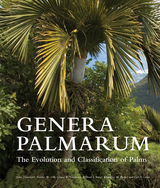 Genera Palmarum: The Evolution and Classification of Palms
John Dransfield, Natalie W. Uhl, Conny B. Asmussen, William J. Baker, Madeline Harley, and Carl Lewis
Royal Botanic Gardens, Kew, 2008 Palms are iconic in our culture, representing everything from victory to vacation. And for nearly three decades, Genera Palmarum has been the stand-out reference for anyone interested in this economically and horticulturally important plant family. Now, this award-winning book has been completely updated and revised, bringing it in line with new research and newly discovered genera.
In this new edition, genus treatments now include complete descriptions, nomenclature, and etymology, as well as discussions of diversity, distribution, phylogeny, morphology, uses and ecology. All genera are fully illustrated with full-color photographs alongside analytic illustrations, distribution maps, and even electron micrographs of pollen. An updated introduction provides readers with essential background information via authoratative essays on the structure of palms, their chemistry, their history, and much more.
Fully revised for a new generation of researchers and gardening enthusiasts, Genera Palmarum continues to be the gold-standard reference work on palms.
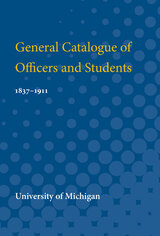 General Catalogue of Officers and Students, 1837-1911: 1837-1911
University of Michigan
University of Michigan Press, 1912 This edition of The General Catalogue of Officers and Students of the University of Michigan follows closely the plan of the edition of 1902. Part I presents the names of all Officers of the University from the organization of the first Board of Regents in 1837 to December 31, 1911; it has been divided into appropriate groups and arranged in chronological order according to date of original appointment. Part II presents the names of all graduates of the University down to the same date; it is arranged alphabetically by classes under each Department of the University. Part III presents the names of all students who matriculated before September 1907, and who have not taken a degree here as well as names of deceased students who matriculated after that date; it has been arranged under one alphabet rather than by departments and classes, for the obvious reason that no precise arrangement of that kind was possible.
General Characteristics of the Germanic Languages
Antoine Meillet
University of Alabama Press, 2005 Classics on Indo-European languages. Antoine Meillet (1866–1936) is one of the most important linguists of all time. A French linguist and Indo-Europeanist, he was the author of over two dozen books and reference works that are still widely consulted, including The Comparative Method in Historical Linguistics and General Characteristics of the Germanic Languages. Meillet was a student of Ferdinand de Saussure, intellectual father of structuralism, at the Sorbonne. He spent most of his career at the College of France, teaching a generation of students who would be influential in their own right.
General Cytology: A Textbook of Cellular Structure and Function for Students of Biology and Medicine
Edited by Edmund Vincent Cowdry
University of Chicago Press, 1924 This volume was, at the time of publication, the largest and most comprehensive book on the subject of cytology, a branch of zoology which had grown considerably in the years before 1924. It was written by the foremost cytologists in the United States, including Robert Chambers, Edwin G. Conklin, Edmund V. Cowdry, Merle H. Jacobs, Ernest E. Just, Margaret R. Lewis, Warren H. Lewis, Frank R. Lillie, Ralph S. Lillie, Clarence E. McClung, Albert P. Mathews, Thomas H. Morgan, and Edmund B. Wilson.
The General Data Protection Regulation in Plain Language
Bart van der Sloot
Amsterdam University Press, 2020 The General Data Protection Regulation in Plain Language is a guide for anyone interested in the much-discussed rules of the GDPR. In this legislation, which came into force in 2018, the European Union meticulously describes what you can and cannot do with data about other people. Violating these rules can lead to a fine of up to 20 million euros.
This book sets out the most important obligations of individuals and organisations that process data about others. These include taking technical security measures, carrying out an impact assessment and registering all data-processing procedures within an organisation. It also discusses the rights of citizens whose data are processed, such as the right to be forgotten, the right to information and the right to data portability.
The General Data Protection Regulation in Plain Language
Bart van der Sloot
Amsterdam University Press, 2020 The General Data Protection Regulation in Plain Language is a guide for anyone interested in the much-discussed rules of the GDPR. In this legislation, which came into force in 2018, the European Union meticulously describes what you can and cannot do with data about other people. Violating these rules can lead to a fine of up to 20 million euros.
This book sets out the most important obligations of individuals and organisations that process data about others. These include taking technical security measures, carrying out an impact assessment and registering all data-processing procedures within an organisation. It also discusses the rights of citizens whose data are processed, such as the right to be forgotten, the right to information and the right to data portability.
General Education in School and College: A Committee Report by Members of the Faculties of Andover, Exeter, Lawrenceville, Harvard, Princeton, and Yale
Alan R. Blackmer, Henry Wilkinson Bragdon, McGeorge Bundy, E. Harris Harbison, Charles Seymour, Jr., and Wendell H. Taylor
Harvard University Press
 General Education in the Social Sciences: Centennial Reflections on the College of the University of Chicago
Edited by John J. MacAloon
University of Chicago Press, 1992 Higher education's most vibrant and contentious issues—common and specialized learning in the curriculum, conceptions of general and liberal education, the design of common core sequences, the merits of classic texts and contemporary research, Western and non-Western course materials, the place of undergraduate teaching in scholarly careers—have for decades been debated by the faculty of the College of the University of Chicago. At the College, they have become embodied in educational programs of sufficient historical depth to reveal patterns of intellectual and pedagogical continuity amidst changing social and institutional circumstances.
Social Science 2 holds the place of honor among these educational projects. For more than half a century, Soc 2 has been one of the most influential courses in American undergraduate education. This unique, year-long course, the oldest and most distinguished of its kind at any American university, has served as an ongoing experiment in how the social sciences can be taught and learned in the general education context.
In this collection John MacAloon has gathered essays by fourteen eminent social scientists—such as David Riesman, Michael Schudson, and F. Champion Ward—who as either teachers or students were profoundly shaped by Soc 2. Their multifarious and selective memories—full of dissonances and harmonies of recollection, judgment, and voice—create a compelling biography of a course and a college that have survived tumultous change through sustained and committed argument.
This book will be of great interest to anyone interested not only in the theory but the practice of higher education.
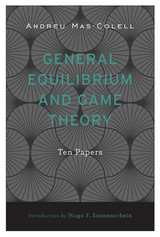 General Equilibrium and Game Theory: Ten Papers
Andreu Mas-Colell
Harvard University Press, 2016 Andreu Mas-Colell revolutionized our understanding of competitive markets, price formation, and the behavior of market participants. General Equilibrium and Game Theory offers readers a compendium of his most important scholarly contributions, gathering in a single volume the groundbreaking papers that have solidified his standing as one of the preeminent economic theorists of our time.
Built upon the foundations of neoclassical economics, Mas-Colell’s work is distinguished by a mathematical and analytical elegance that brings theory closer to real-world situations. He overturns the standard assumption of general equilibrium theory—that markets are perfectly competitive and their participants are perfectly rational—and concludes that neither the law of supply and demand nor the existence of equilibrium prices depends on the rationality of agents. Similarly, Mas-Colell (working with Sergiu Hart) challenges classical game theory’s reliance on rational behavior, demonstrating that adaptation and learning shape the dynamics of repeated games.
Addressing central questions of finance, trade, industrial organization, and welfare economics, Mas-Colell shows the surprising power and versatility of differentiability and linear-space mathematical techniques, and he emphasizes the fruitfulness of cooperative game-theory approaches, such as Shapley value theory and the Bargaining Set, for understanding competition and distribution. General Equilibrium and Game Theory is a signal contribution to economic theory and an invaluable resource for anyone wishing to study the craft of a master of economic modeling.
A General Equilibrium Model for Tax Policy Evaluation
Charles L. Ballard, Don Fullerton, John B. Shoven, and John Whalley
University of Chicago Press, 1985 This book reports the authors' research on one of the most sophisticated general equilibrium models designed for tax policy analysis. Significantly disaggregated and incorporating the complete array of federal, state, and local taxes, the model represents the U.S. economy and tax system in a large computer package. The authors consider modifications of the tax system, including those being raised in current policy debates, such as consumption-based taxes and integration of the corporate and personal income tax systems. A counterfactual economy associated with each of these alternatives is generated, and the possible outcomes are compared.
 General Equilibrium of International Discrimination: The Case of Customs Unions
Jaroslav Vanek
Harvard University Press Perhaps the most important economic development of recent years has been the integration process engaged in by European countries. Today other groups of countries throughout the world either contemplate or have already undertaken similar courses of action. Although professional economists have already devoted much attention to the subject, considerable work remains to be done. The present study represents an attempt to advance our scientific knowledge in this direction.
This work is entirely theoretical and fully deductive. Its contribution lies both in the method used and in the conclusions reached. In contrast to most previous studies of customs unions and economic integration, exclusive use is made of general-equilibrium analysis. Because interpretation of mathematical results bearing on comparative statistics of suboptimal situations was found impossible, the author has depended wholly upon geometry. While the geometrical method does not allow inclusion of large numbers of variables, it often leads to, or at least intuitively suggests, important generalizations.
The findings, summarized in 107 points at the end of the study, can be classified in two distinct categories. On the one hand, a number of results are derived concerning the trade effects of international discrimination and customs unions—that is, the effects on the volumes of exports and imports and on relative international values. On the other hand, the more important portions of this work study the effects of customs unions on the welfare of the union, the welfare of the rest of the world, and the global efficiency of resource allocation in the world as a whole. Inter-country welfare comparisons and the use of cardinal utility indexes are entirely avoided. Rather, the author uses the concept of ordinal utility, and makes extensive use of utility-possibility analysis. With respect to the latter, the study of customs unions actually suggests a new method applicable to a wide range of other suboptimal situations in general equilibrium.
General Equilibrium, Overlapping Generations Models, and Optimal Growth Theory
Truman F. Bewley
Harvard University Press, 2007 This book presents an original exposition of general equilibrium theory for advanced undergraduate and graduate-level students of economics. It contains detailed discussions of economic efficiency, competitive equilibrium, the first and second welfare theorems, the Kuhn-Tucker approach to general equilibrium, the Arrow-Debreu model, and rational expectations equilibrium and the permanent income hypothesis. Truman Bewley also treats optimal growth and overlapping generations models as special cases of the general equilibrium model. He uses the model and the first and second welfare theorems to explain the main ideas of insurance, capital theory, growth theory, and social security. It enables him to present a unified approach to portions of macro- as well as microeconomic theory. The book contains problems sets for most chapters.
 General Firebrand and His Red Atlas
Tathagata Bhattacharya
Seagull Books, 2024 A fast-paced and action-packed dystopian novel, addressing the nature of power, the limits of rationality, and the dominance of fear.
In a world on the brink of totalitarian rule, one man rises from the shadows to ignite a revolution and becomes the unlikely leader of a war of resistance that will shake the very foundations of power. General Firebrand, an unsocial and recovered alcoholic, considered a pariah by society, rises up against the country’s fascist regime. In this guerrilla war, Firebrand garners support from the unlikeliest allies. Beasts and birds of the jungle join the struggle. Spirits of historical figures from past wars and fictional characters with supernatural abilities lend their strength to the cause. As a devastating secret is revealed that moves Firebrand to the core, the battle for liberation takes on new dimensions, exposing the fragility of rationality and the weight of historical wrongs committed in the name of a supposedly humane ideology.
With zany, irreverent prose and a breakneck pace, General Firebrand and His Red Atlas is an explosive debut novel that challenges conventional wisdom and explores the complexities of courage, doubt, and the pursuit of justice in a world dominated by fear.
 The General History of Peru: Book 1
Martín de Murúa
University Press of Colorado, 2024 Mercedarian friar Martín de Murúa’s General History of Peru (Historia General del Piru, 1616) is one of the most significant Spanish chronicles of Inca history and Peru’s early colonial period yet to be published in English. Written over several decades and approved by King Philip III for publication, Murúa’s magnificent manuscript disappeared from public view for nearly 350 years until its publication in 1964. Here, translators Brian S. Bauer, Eliana Gamarra C., and Andrea Gonzales Lombardi present the first English translation of Book 1 of Murúa’s comprehensive three-part work.
Book 1 covers both the history of the Inca Empire and the first forty years of the Spanish occupation, up to and including the fall of Vilcabamba in 1572. While the J. Paul Getty Museum produced a digital facsimile of Murúa’s full Historia in 2008, it remained underused and, until now, untranslated. This translation revitalizes the momentous early volume with an introduction offering a window into Murúa’s life and the writing of his Historia, and extensive footnotes that provide the scholarly context of Murúa’s work.
This edition of The General History of Peru: Book 1 provides long-awaited access to Murúa’s contribution to Indigenous Andean history and early colonial Peru. The book is valuable for English-speaking students and scholars of pre-Hispanic Andean history, especially those interested in the ancient Andean world and colonial Peru’s literary production.
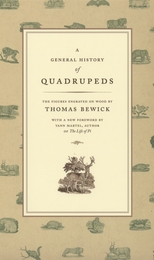 A General History of Quadrupeds: The Figures Engraved on Wood
Thomas Bewick
University of Chicago Press, 2009 In the late eighteenth century, the British took greater interest than ever before in observing and recording all aspects of the natural world. Travelers and colonists returning from far-flung lands provided dazzling accounts of such exotic creatures as elephants, baboons, and kangaroos. The engraver Thomas Bewick (1753–1828) harnessed this newfound interest by assembling the most comprehensive illustrated guide to nature of his day. A General History of Quadrupeds, first published in 1790, showcases Bewick’s groundbreaking engraving techniques that allowed text and images to be published on the same page. From anteaters to zebras, armadillos to wolverines, this delightful volume features engravings of over four hundred animals alongside descriptions of their characteristics as scientifically understood at the time. Quadrupeds reaffirms Bewick’s place in history as an incomparable illustrator, one whose influence on natural history and book printing still endures today.
 General Hylan B. Lyon: A Kentucky Confederate and the War in the West
Dan Lee
University of Tennessee Press, 2019 Born to an affluent family in 1836, Hylan B. Lyon claimed ancestors among Irish rebels, patriots of the American Revolution, and slaveowners in his native Kentucky. Biographer Dan Lee chronicles Lyon’s military career, which began with service in the Third US Artillery after his graduation from West Point in 1856. Lyon first saw action in the Third Seminole War. Later stationed at Fort Yuma in California, he went on to fight in the Coeur d’Alene War. Witnessing the execution of Yakima chief Qualchan during this last conflict nearly made Lyon leave the army. Yet the young lieutenant persevered. After serving with troops building the Mullan Road between Washington and Montana, Lyon returned to Kentucky just as Lincoln won the 1860 presidential election. Though his home state never seceded from the Union, Lyon cast his lot with the Confederacy. He served with the Third Kentucky Infantry Regiment (CSA), led the Eighth Kentucky Infantry, and later commanded the Kentucky Brigade under Gen. Nathan Bedford Forrest. Lyon saw action in Kentucky, Tennessee, Alabama, and Mississippi, spending several months as a prisoner of war and winning special commendation for his performances at the Battles of Coffeeville and Brice’s Crossroads. He ultimately earned the rank of brigadier general.
After the Civil War, Lyon sought refuge with other ex-Confederates in Mexico, working as a railroad surveyor. He requested and received a presidential pardon and returned to Kentucky by mid-1866. Lyon remained there until his death in 1907, devoting himself to farming and prison reform, as well as serving in the state house of representatives. He was the mayor of Eddyville, Kentucky, when he died in 1907.
General Index to Swedenborg's Scripture Quotations
Arthur Hodson Searle
Swedenborg Foundation Publishers, 2006 The General Index to Swedenborg’s Scripture Quotations contains a list of all citations and references to Scripture in the theological works of the eighteenth-century Swedish philosopher and mystic Emanuel Swedenborg, including allusions to passages where Swedenborg failed to name the book, chapter, or verse in question. The book is divided into three main sections: Old Testament, New Testament, and Non-Canonical Books.
This reference work is an important resource for anyone looking into Swedenborg’s biblical commentaries, including scholars and students from clergy and laity alike. Popularly known as “Searle’s Index” after Arthur Hodson Searle, the editor of the first English edition, this third edition has been completely revised, expanded, and typeset with a more accessible page design, a preface by G. P. Dawson, and helpful tables of abbreviations.
 General John Pope: A LIFE FOR THE NATION
Peter Cozzens
University of Illinois Press, 2000 Ambitious and outspoken, John Pope was one of the most controversial figures to hold high command during the Civil War, Reconstruction, and in the American West. General John Pope: A Life for the Nation is the first full biography of this much maligned figure who played crucial roles in both the Eastern and the Western Theaters of the Civil War.
Renowned Civil War scholar Peter Cozzens has mined Pope's own memoirs and a wealth of other primary sources to provide a complete picture of this gifted strategist. Uncovering new information about Pope's pre- and postwar career and his path to power, Cozzens delineates the political environment that surrounded Pope and provided the context for his actions.
Cozzens examines Pope's early career first as commander of the Army of the Mississippi and then as leader of a hastily formed Army of Virginia against Robert E. Lee. After his famous defeat at the Second Battle of Bull Run, Pope was sent to the frontier. There he held important commands on the western plains over the next twenty-four years, all the while struggling to clear his reputation of the events at Second Bull Run. A principal architect of the Red River War, which broke the resistance of the Southern Plains Indians, Pope espoused humanitarian treatment of subjugated tribes and was recognized as one of the army's leading authorities on Indian affairs.
In place of the simplistic caricature that has satisfied most historians, Cozzens has crafted an accurate, humane, balanced portrait of a complex man involved with the most complex issues of his day. A monumental work on a long-neglected figure, General John Pope offers a fresh look at a key nineteenth-century military leader as well as the most detailed analysis available of Federal leadership during the Second Bull Run campaign.
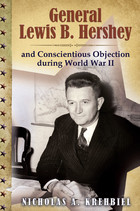 General Lewis B. Hershey and Conscientious Objection during World War II
Nicholas A. Krehbiel
University of Missouri Press, 2012 During World War II, the United States drafted 10.1 million men to serve in the military. Of that number, 52,000 were conscientious objectors, and 12,000 objected to noncombatant military service. Those 12,000 men served the country in Civilian Public Service, the program initiated by General Lewis Blaine Hershey, the director of Selective Service from 1941 to1970. Despite his success with this program, much of Hershey’s work on behalf of conscientious objectors has been overlooked due to his later role in the draft during the Vietnam War.
Seeking to correct these omissions in history, Nicholas A. Krehbiel provides the most comprehensive and well-rounded examination to date of General Hershey’s work as the developer and protector of alternative service programs for conscientious objectors. Hershey, whose Selective Service career spanned three major wars and six presidential administrations, came from a background with a tolerance for pacifism. He served in the National Guard and later served in both World War I and the interwar army. A lifelong military professional, he believed in the concept of the citizen soldier—the civilian who responded to the duty of service when called upon. Yet embedded in that idea was his intrinsic belief in the American right to religious freedom and his notion that religious minorities must be protected.
What to do with conscientious objectors has puzzled the United States throughout its history, and prior to World War II, there was no unified system for conscientious objectors. The Selective Service Act of 1917 only allowed conscientious objection from specific peace sects, and it had no provisions for public service. In action, this translated to poor treatment of conscientious objectors in military prisons and camps during World War I. In response to demands by the Historic Peace Churches (the Brethren, Mennonites, and the Society of Friends) and other pacifist groups, the government altered language in the Selective Service Act of 1940, stating that conscientious objectors should be assigned to noncombatant service in the military but, if opposed to that, would be assigned to “work of national importance under civilian direction.”
Under the direction of President Franklin D. Roosevelt and with the cooperation of the Historic Peace Churches, Hershey helped to develop Civilian Public Service in 1941, a program that placed conscientious objectors in soil conservation and forestry work camps, with the option of moving into detached services as farm laborers, scientific test subjects, and caregivers, janitors, and cooks at mental hospitals. Although the Civilian Public Service program only lasted until 1947, alternative service was required for all conscientious objectors until the end of the draft in 1973.
Krehbiel delves into the issues of minority rights versus mandatory military service and presents General Hershey’s pivotal role in the history of conscientious objection and conscription in American history. Archival research from both Historic Peace Churches and the Selective Service makes General Lewis B. Hershey and Conscientious Objection during World War II the definitive book on this subject.
 General Linguistics
Francis P. Dinneen, SJ
Georgetown University Press, 1995 A comprehensive overview of the development of language studies from the ancient Greeks through modern theorists, this book focuses on determining what the enduring issues in linguistics are, what concepts have changed, and why. Francis P. Dinneen, SJ, defines the basic terminology of the discipline as well as different linguistic theories, and he frequently compares underlying assumptions in contemporaneous science and linguistics. General Linguistics traces the history of linguistics from ancient Greek works on grammar and rhetoric through the medieval roots of traditional grammar and its assumption that there is a norm for correct speech. Dinneen marks the beginning of modern linguistics with Saussure's concept of an autonomous linguistic structure independent of socially imposed norms, and he details the theoretical contributions of Sapir, Bloomfield, Hjelmslev, Chomsky, Pike, and others. Dinneen considers the relative merits of the different theories and models, evaluating their claims and shortcomings. A thorough introduction to linguistics for newcomers to the field, this book will also be valuable to linguists, psychologists, philosophers, and historians of science for its evaluations of major theoretical concepts in light of enduring issues and problems in language studies.
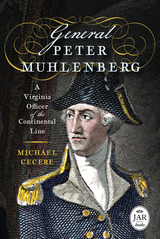 General Peter Muhlenberg: A Virginia Officer of the Continental Line
Michael Cecere
Westholme Publishing, 2020 The Story of the Legendary Clergyman-Turned-Soldier for the American Cause
Standing at the pulpit in his church in the Shenandoah Valley, the preacher borrowed from Ecclesiastes, declaring in a firm voice that “To every thing there is a season . . . .” He then announced, “that there is a time to fight, and that time had now come,” and abruptly removed his clerical robe to reveal his colonel’s uniform. There is little doubt that this clergyman-turned-soldier uttered words to this effect, but whether he threw off his robe to reveal a gleaming uniform may be embellishment. In General Peter Muhlenberg: A Virginia Officer of the Continental Line, historian Michael Cecere cuts away the romanticism surrounding this fascinating character to present him as a highly capable and dedicated officer who served for seven long years in America’s War for Independence; a man of faith who held the high ideals of that office in his conduct with fellow officers and regular soldiers alike.
First appointed to lead the 8th Virginia Regiment of the Continental Army, Muhlenberg and his troops served under General Charles Lee in the defense of Charleston in 1776. Sent north and promoted to brigadier-general, Muhlenberg participated in the ensuing battles of Brandywine, Germantown, the winter at Valley Forge, and the major clash at Monmouth Courthouse. In 1780, he returned to Virginia and stood at the forefront of Virginia’s defense when the British invaded in 1781. At Yorktown, Muhlenberg commanded the continental light infantry troops that stormed Redoubt No. 10, sealing Cornwallis’s fate. Focusing on the military career of Muhlenberg, and relying on a judicious amount of primary source material, the author follows Muhlenberg and his troops as they battled some of the most storied adversaries of the war, including John Graves Simcoe’s Queen’s Rangers, Captain Johann Ewald’s German Jaegers, and Banastre Tarleton’s British Legion.
Admired by George Washington and his fellow officers and men, Muhlenberg was an American patriot who sacrificed much for his country’s cause, and truly “lived respected and died regretted by all good men.”
General Principles of Sacramental Theology
Roger W. Nutt
Catholic University of America Press, 2017 General Principles of Sacramental Theology addresses a current lacuna in English language theological literature. Bernard Leeming’s highly respected book Principles of Sacramental Theology was published more than sixty years ago. Since that time, there has been a noted decrease, especially in English language sacramental theology, in treatments of the basic topics and principles – such as the nature of the sacraments of signs, sacramental grace, sacramental character, sacramental causality, sacramental intention, the necessity and number of the sacraments, sacramental matter and form, inter alia – which apply to all of the sacraments. This book will be of use in seminary, graduate, and undergraduate courses. The sacraments play an irreplaceable role in pursuing a Universal Call to Holiness that is so central to Vatican II’s teaching.
General Relativity
Robert. M. Wald
University of Chicago Press, 1984 A classic textbook designed to help students understand general relativity
Robert M. Wald's book has been a staple of physics teaching for decades. It offers straightforward, rigorous analyses of current understandings of all the central questions and problems of the field, giving each the complexity it requires while making every effort to keep the whole accessible to a student who is embarking on the study of this subject for the first time.
General Relativity from A to B
Robert Geroch
University of Chicago Press, 1981 "This beautiful little book is certainly suitable for anyone who has had an introductory course in physics and even for some who have not."—Joshua N. Goldberg, Physics Today
"An imaginative and convincing new presentation of Einstein's theory of general relativity. . . . The treatment is masterful, continual emphasis being placed on careful discussion and motivation, with the aim of showing how physicists think and develop their ideas."—Choice
General Smuts: South Africa
Antony Lentin
Haus Publishing, 2009 Jan Smuts was one of the key figures behind the creation of the League of Nations; Wilson was inspired by his ideas, including the mandates scheme. He pleaded for a magnanimous peace, warning that the treaty of Versailles would lead to another war.
 The General Textile Strike of 1934: From Maine to Alabama
John A. Salmond
University of Missouri Press, 2002
In January 1933, the United Textile Workers of America was in danger of collapse. Its membership was no larger than 15,000; its attempts to organize southern workers had failed disastrously; and it was constantly under attack from rival organizations. Yet, barely eighteen months later, with 300,000 dues-paying members, with newly established or revived branches covering southern cotton textile workers, as well as northern woolen and worsted workers, silk and jacquard weavers, dyers and finishers, even rayon workers, and with locals in 208 cities, towns, and mill villages, the UTW was about to embark on what one historian has termed “the greatest single industrial conflict in the history of American labor.” The General Textile Strike of 1934 is the story of that conflict.
The few historians who have concerned themselves at all with the 1934 textile strike have all concentrated on its southern aspect, presenting it as a southern event, a cotton textile event. No one argues that the South and cotton were not crucial to the strike’s story. It was cotton mill workers’ anger over the broken promises of the National Industrial Recovery Act that had forced a reluctant UTW leadership into supporting a strike vote. No industry leader was more devious in his dealings with the UTW leaders than George Sloan, the chair of the Cotton Code Authority and head of the Cotton Textile Institute. Nevertheless, the 1934 strike was a nationwide one, involving hundreds of thousands of silk, woolen, and rayon workers, all represented by the UTW and mostly living in states outside the South. Moreover, Peter Van Horn and Arthur Besse, head of the Silk and Woolen Code Authorities, respectively, lost little to Sloan in their intransigence toward labor’s demands. And, though the great transfer of the cotton industry from New England to the South was almost complete, there were still little pockets left in Massachusetts, Rhode Island, and Maine.
In The General Textile Strike of 1934, John Salmond tells everyone’s story. Looking at the strike from a national and an industrywide perspective, Salmond explains why workers were willing to risk protesting and describes the differences and similarities between southern and northern workers. Setting the strike within a New Deal context and focusing on its impact on the future of labor relations in the industry and on the lives of those who participated in it, The General Textile Strike of 1934 fills an important gap in American labor history.
A General Theory of Authority
Yves R. Simon
University of Notre Dame Press, 1973 A General Theory of Authority was first printed in 1962 and is a classic treatment of authority and its relation to justice, life, truth, and order. In recent years, authority has been seen as an enemy of freedom, autonomy, and development. In this book, the renowned philosopher Yves R. Simon, himself a passionate proponent of liberty, analyzes the idea of authority and definds it as an essential concomitant of liberty. Simon sees authority as the catalyst necessary to bring together the seemingly disparate demands of liberty on one hand and order on the other.
Simon’s perceptive discussion of how authority differs from law enables him to highlight the effective and personal role that authority can play in the life of the individual and for the good of the community.
 A General Theory of Exploitation and Class
John E. Roemer
Harvard University Press, 1982 How can exploitation and even class division occur in socialist societies? The question is not merely embarrassing for Marxists and socialists. It is also a deep puzzle for economic theorists. In this original and powerful work, John Roemer proposes a general theory of exploitation which provides a game theoretic framework for expressing any conception of exploitation—feudal, capitalist, or socialist—in a standardized and explicit way, thus permitting a clear comparison of different ethical conceptions. As well as applying the general theory to an analysis of socialist society, Roemer uses it to contrast Marxian and neoclassical conceptions of exploitation. By placing the Marxian conception of exploitation in the context of a more general theory, Roemer provides fresh insights into classical questions, and resolves several old problems in Marxian economics.
The book also contains a formal theory of class formation. Once the behavior and institutional specifications of an economy are given, classes emerge endogenously in the model. In a major theorem Roemer relates the two key characteristics of a person in a given economy: his class position and his status as exploiter or exploited. Finally, he shows that the general theory of exploitation can be viewed as the formal translation into economic language of the theory of historical materialism. In its mathematical power and precision, its skillful use of general equilibrium and game theory, the book will become an important bridge between Marxist and neoclassical economics.
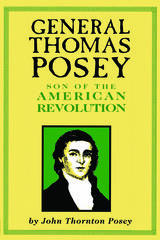 General Thomas Posey: Son of the American Revolution
John Thornton Posey
Michigan State University Press, 1992 Revolutionary War general Thomas Posey (1750-1818) lived his life against the backdrop of one of the most dramatic periods in American history. Posey, who played a minor role in the actual War for Independence, went on to participate in the development and foundation of several states in the transappalachian West. His experiences on the late 18th- and early 19th-century American frontier were varied and in a certain sense extraordinary; he served as Indian agent in Illinois Territory; as Lieutenant Governor of Kentucky, as U.S. Senator from Louisiana, and as Governor of Indiana during its transition from territorial status to statehood.
His biographer speculates on the contrasting influences of Thomas's ne'er-do-well father, Captain John Posey, and the family's close friend, General George Washington. Posey's progress is then followed as he raises his own family in the newly formed nation. Of particular interest is an appendix containing a detailed analysis of evidence available to support popular 29th-century speculation that Thomas Posey was, in fact, George Washington's illicit son.
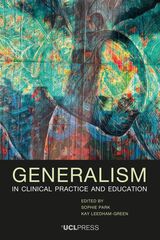 Generalism in Clinical Practice and Education
Edited by Sophie Park and Kay Leedham-Green
University College London, 2024 Advocates for adaptable, person-centered healthcare, offering theoretical insights and practical examples from a diverse global perspective.
Generalism is a key approach to healthcare organization and delivery that enables person-centered, dynamic, and cost-effective patient care. With its emphasis on adaptability, generalism requires expansive, nurturing, and personalized approaches to clinical education in which a generalist attends to and explores patient priorities.
Generalism in Clinical Practice and Education outlines a generalist philosophy of practice, which is brought to life through interleaved examples. Written by a range of international clinicians, patients, and academics this book does not prescribe a single way to do generalism properly. Rather, it seeks to inspire readers’ future engagement with generalism in practice and education through sharing underpinning concepts, values, and principles. This ‘big picture’ attention to generalism across public health, social determinants of health, and clinical care is at the heart of sustainable and efficient use of resources to prioritize those in need. The book explores four key principles that aim to achieve creative, inclusive, and agile approaches to clinical care. Its goal is to support generalism in clinical practice and education and to produce clinical practitioners and learners who enjoy, embrace, and enhance future clinical care.
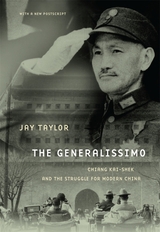 The Generalissimo: Chiang Kai-shek and the Struggle for Modern China, With a New Postscript
Jay Taylor
Harvard University Press, 2009 One of the most momentous stories of the last century is China’s rise from a self-satisfied, anti-modern, decaying society into a global power that promises to one day rival the United States. Chiang Kai-shek, an autocratic, larger-than-life figure, dominates this story. A modernist as well as a neo-Confucianist, Chiang was a man of war who led the most ancient and populous country in the world through a quarter century of bloody revolutions, civil conflict, and wars of resistance against Japanese aggression.
In 1949, when he was defeated by Mao Zedong—his archrival for leadership of China—he fled to Taiwan, where he ruled for another twenty-five years. Playing a key role in the cold war with China, Chiang suppressed opposition with his “white terror,” controlled inflation and corruption, carried out land reform, and raised personal income, health, and educational levels on the island. Consciously or not, he set the stage for Taiwan’s evolution of a Chinese model of democratic modernization.
Drawing heavily on Chinese sources including Chiang’s diaries, The Generalissimo provides the most lively, sweeping, and objective biography yet of a man whose length of uninterrupted, active engagement at the highest levels in the march of history is excelled by few, if any, in modern history. Jay Taylor shows a man who was exceedingly ruthless and temperamental but who was also courageous and conscientious in matters of state. Revealing fascinating aspects of Chiang’s life, Taylor provides penetrating insight into the dynamics of the past that lie behind the struggle for modernity of mainland China and its relationship with Taiwan.
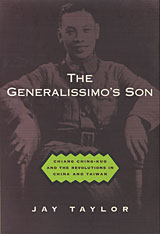 The Generalissimo's Son: Chiang Ching-kuo and the Revolutions in China and Taiwan
Jay Taylor
Harvard University Press, 2000 Chiang Ching-kuo, son and political heir of Generalissimo Chiang Kai-shek, was born in 1910, when Chinese women, nearly all illiterate, hobbled about on bound feet and men wore pigtails as symbols of subservience to the Manchu Dynasty. In his youth Ching-kuo was a Communist and a Trotskyite, and he lived twelve years in Russia. He died in 1988 as the leader of Taiwan, a Chinese society with a flourishing consumer economy and a budding but already wild, woolly, and open democracy. He was an actor in many of the events of the last century that shaped the history of China's struggles and achievements in the modern era: the surge of nationalism among Chinese youth, the grand appeal of Marxism-Leninism, the terrible battle against fascist Japan, and the long, destructive civil war between the Nationalists and the Communists. In 1949, he fled to Taiwan with his father and two million Nationalists. He led the brutal suppression of dissent on the island and was a major player in the cold, sometimes hot war between Communist China and America. By reacting to changing economic, social, and political dynamics on Taiwan, Sino-American rapprochement, Deng Xiaoping's sweeping reforms on the mainland, and other international events, he led Taiwan on a zigzag but ultimately successful transition from dictatorship to democracy.
Jay Taylor underscores the interaction of political developments on the mainland and in Taiwan and concludes that if China ever makes a similar transition, it will owe much to the Taiwan example and the Generalissimo's son.
Generalized Galois Logics: Relational Semantics of Nonclassical Logical Calculi
Katlin Bimbó and J. Michael Dunn
CSLI, 2008 Nonclassical logics have played an increasing role in recent years in disciplines ranging from mathematics and computer science to linguistics and philosophy. Generalized Galois Logics develops a uniform framework of relational semantics to mediate between logical calculi and their semantics through algebra. This volume addresses normal modal logics such as K and S5, and substructural logics, including relevance logics, linear logic, and Lambek calculi. The authors also treat less-familiar and new logical systems with equal deftness.
Generalized Microeconomics
Jirí Hlavácek and Michal Hlavácek
Karolinum Press, 2013 The generalization of microeconomics enables model descriptions of economic rationality, even in fields that standard microeconomics more or less avoids, like nonprofit sectors of market economies, altruism, or externalities. Here, the authors broaden the scope of microeconomics while treating standard profit maximization as a special case. They argue, ultimately, that the generalizing criterion is a Darwinian maximization of the probability of survival.
 Generalized Phrase Structure Grammar
Gerald Gazdar, Ewan Klein, Geoffrey K. Pullum, and Ivan A. Sag
Harvard University Press, 1985 Generalized Phrase Structure Grammar provides the definitive exposition of the theory of grammar originally proposed by Gerald Gazdar and developed during half a dozen years' work with his colleagues Ewan Klein, Geoffrey Pullum, and Ivan Sag. This long-awaited book contains both detailed specifications of the theory and extensive illustrations of its power to describe large parts of English grammar. Experts who wish to evaluate the theory and students learning GPSP for the first time will find this book an invaluable guide.
The initial chapters lay out the theoretical machinery of GPSP in a readily intelligible way. Combining informal discussion with precise formalization, the authors describe all major aspects of their grammatical system, including a complete theory of syntactic features, phrase structure rules, meta rules, and feature instantiation principles. The book then shows just what a GPSP analysis of English syntax can accomplish. Topics include the internal structure of phrases, unbounded dependency constructions of many varieties, and coordinate conjunction—a construction long considered the sticking point for phrase structure approaches to syntax.
The book concludes with a well developed proposal for a model theoretic semantic system to go along with GPSP syntax. Throughout, the authors maintain the highest standards of explicitness and rigor in developing and assessing their grammatical system. Their aim is to provide the best possible test of the hypothesis that syntactic description can be accomplished in a single-level system. And more generally, it is their intention to formulate a grammatical framework in which linguistic universals follow directly from the form of the system and therefore require no explicit statement. Their book sets new methodological standards for work in generative grammar while presenting a grammatical system of extraordinary scope.
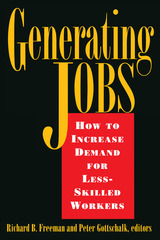 Generating Jobs: How to Increase Demand for Less-Skilled Workers
Richard B. Freeman
Russell Sage Foundation, 1998 The American economy is in danger of leaving its low-skilled workers behind. In the last two decades, the wages and employment levels of the least educated and experienced workers have fallen disastrously. Where willing workers once found ready employment at reasonable wages, our computerized, service-oriented economy demands workers who can read and write, master technology, deal with customers, and much else. Improved education and training will alleviate this problem in the long run, but educating the new workforce will take a substantial national investment over many years. In the meantime, we face increasingly acute questions about how to include low-skill workers in today's economy. Generating Jobs takes a hard look at these questions, and asks whether anything can be done to improve the lot of low-skilled workers by intervening in the labor market on their behalf. These micro demand-side policies seek to improve wages and employment levels—either by lowering the costs of hiring low-skilled workers through employer subsidies, or by raising wage levels, benefit levels, or hours of employment, or by providing employment via government jobs. Although these policies are not currently popular in the U.S., they have long been used in many countries. Generating Jobs provides a clear-eyed assessment of this history, and asks if any of these policies might be applicable to the current problems of low-skilled workers in the United States. The results are surprising. Several recently touted panaceas turn out to be costly and ineffective in the American labor market. Enterprise zones, for instance, are an expensive way of moving jobs into areas of high unemployment, costing as much as $60,000 per job. Similarly, job-sharing, which has had uneven success in Europe, turns out to be ill-suited to conditions in the U.S., where wages are relatively low and workers need to work long hours to maintain income. On the other hand, a number of older, less flashy policies turn out to have real, if modest, benefits. Wage subsidies have increased employment among qualifying workers, and public employment policies can increase the number of workers from targeted groups working during the program. While acknowledging that many solutions are counterproductive, this definitive review of active labor market policies shows that many programs can offer real help. More than any rhetoric, Generating Jobs is the best guide to future action and a serious response to those who claim that nothing can be done.
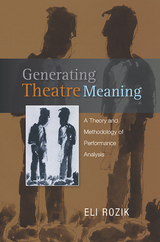 Generating Theatre Meaning: A Theory and Methodology of Performance Analysis
Eli Rozik
Sussex Academic Press, 2022 Generating Theatre Meaning offers a theory and methodology of performance analysis as an alternative to traditional play analysis. The underlying theme is that theatre performance is a descriptive text generated by the theatre medium, and that the process of generating meaning takes place in the actual encounter between a theatre performance and the spectator. Many new understandings result, including how the theatre medium is iconic in the new sense of operating images of real or mental models, and how this impacts on the verbal text and stage metaphor; how poetic principles structure fictional worlds and bestow unity and wholeness on performance-texts; how a dialogue between the implied director and the implied spectator is inscribed in the performance-text; and how the implied spectator is characterized by functions of framing, reading, interpreting, and experiencing a performance-text. It follows that actors' bodies on stage fulfill functions of textuality, metatheatricality, personification, characterization, and aesthetic effect. The introduction of the book surveys major contributions made to a methodology of performance analysis, particularly throughout the 20th century. Part I is devoted to the semiotic substratum of the performance text, i.e. to the theatre medium and its basic means of generating theatre texts and meaning. The innovation of this approach lies in seeing theatre first and foremost as a nonverbal medium. Part II deals with the poetic structure of fictional worlds described by the theatre medium and the metaphoric and rhetoric structures that operate on the level of relationship between the description of such a world and the world of a spectator. Part III contains analyses of actual performance texts that illustrate the application of principles previously presented. This is the first comprehensive book to address the necessity of a methodology of performance analysis and take issue with criticism of traditional theatre semiotics.
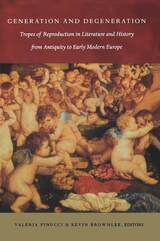 Generation and Degeneration: Tropes of Reproduction in Literature and History from Antiquity through Early Modern Europe
Valeria Finucci and Kevin Brownlee, eds.
Duke University Press, 2001 This distinctive collection explores the construction of genealogies—in both the biological sense of procreation and the metaphorical sense of heritage and cultural patrimony. Focusing specifically on the discourses that inform such genealogies, Generation and Degeneration moves from Greco-Roman times to the recent past to retrace generational fantasies and discords in a variety of related contexts, from the medical to the theological, and from the literary to the historical. The discourses on reproduction, biology, degeneration, legacy, and lineage that this book broaches not only bring to the forefront concepts of sexual identity and gender politics but also show how they were culturally constructed and reconstructed through the centuries by medicine, philosophy, the visual arts, law, religion, and literature. The contributors reflect on a wide range of topics—from what makes men “manly” to the identity of Christ’s father, from what kinds of erotic practices went on among women in sixteenth-century seraglios to how men’s hemorrhoids can be variously labeled. Essays scrutinize stories of menstruating males and early writings on the presumed inferiority of female bodily functions. Others investigate a psychomorphology of the clitoris that challenges Freud’s account of lesbianism as an infantile stage of sexual development and such topics as the geographical origins of medicine and the materialization of genealogy in the presence of Renaissance theatrical ghosts. This collection will engage those in English, comparative, Italian, Spanish, and French studies, as well as in history, history of medicine, and ancient and early modern religious studies. Contributors. Kevin Brownlee, Marina Scordilis Brownlee, Elizabeth Clark, Valeria Finucci, Dale Martin, Gianna Pomata, Maureen Quilligan, Nancy Siraisi, Peter Stallybrass,Valerie Traub
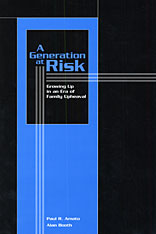 A Generation at Risk: Growing Up in an Era of Family Upheaval
Paul R. Amato and Alan Booth
Harvard University Press, 1997 Just what do we know about the current generation of young Americans? So little it seems that we have dubbed them Generation X. Coming of age in the 1980s and '90s, they hail from families in flux, from an intimate landscape changing faster and more profoundly than ever before. This book is the first to give us a clear, close-up picture of these young Americans and to show how they have been affected and formed by the tremendous domestic changes of the last three decades.
How have members of this generation fared at school and at work, as they have moved into the world and formed families of their own? Do their struggles or successes reflect the turbulence of their time? These are the questions A Generation at Risk answers in comprehensive detail. Based on a unique fifteen-year study begun in 1980, the book considers parents' socioeconomic resources, their gender roles and relations, and the quality and stability of their marriages. It then examines children's relations with their parents, their intimate and broader social affiliations, and their psychological well-being. The authors provide rare insight into how both familial and historical contexts affect young people as they make the transition to adulthood.
Perhaps surprising is the authors' finding that, in this era of shifting gender roles, children who grow up in traditional father-breadwinner, mother-homemaker families and those in more egalitarian, role-sharing families apparently turn out the same. Also striking are the beneficial influence of parental education on children and the troubling long-term impact of marital conflict and divorce--an outcome that prompts the authors to suggest policy measures that encourage marital quality and stability.
 Generation at the Crossroads: Apathy and Action on the American Campus
Loeb, Paul R
Rutgers University Press, 1994 Challenging prevailing media stereotypes, Generation at the Crossroads explores the beliefs and choices of the students who came of age in the 1980s and 1990s. For seven years, at over a hundred campuses in thirty states, Paul Loeb asked students about the values they held. He examines their concepts of responsibility, the links they draw between present and future, and how they view themselves in relation to the larger human community in which they live. He brings us a range of voices, from "I'm not that kind of person," to "I had to take a stand." Loeb looks at how the rest of us can serve young people as better role models, and give them courage and vision to help build a better world. This insightful book explores the culture of withdrawal that dominated American campuses through most of the eighties. He locates its roots in historical ignorance, relentless individualism, mistrust of social movements, and a general isolation from urgent realities. He examines why a steadily increasing minority has begun to take on critical public issues, whether environmental activism, apartheid, hunger and homelessness, affordable education, or racial and sexual equity. Loeb looks at individuals who have overcome precisely the barriers he has described, and how their journeys can become models. The generational choices he explores will shape our common future.
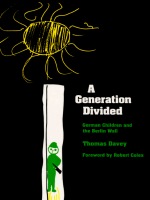 A Generation Divided: German Children and the Berlin Wall
Thomas A. Davey
Duke University Press, 1987 An inquiry into the lives of children of similar, if not identical, historical an cultural heritage who today find themselves in radically opposed ideological worlds, regarding one another across the concrete manifestation of their considerable differences, the Berlin Wall. Under these circumstances, what are the significant factors that contribute to the development in children of feelings of loyalty to or alienation from their nation? How do they view not only themselves, but the "other" Germans as well? How do they come to terms, emotionally and cognitively, with a unique, frequently painful, and frustrating reality? What are the lessons intended for them by their societies, and what lessons do they in fact learn? How do these children persist as Germans while at the same time becoming something else -- "communists? or "capitalists"? Thomas Davey conducted interviews with children both sides of the Wall, participated in their daily lives, collected their drawings, talked with their teachers and families and grew aware of just how attentive children can be to moral and political subtleties of national life. The result is a revealing and dramatic portrait of a young generation coming to terms with complex national and historical circumstances of the two cites of East and West Berlin.
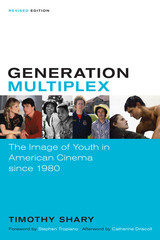 Generation Multiplex: The Image of Youth in American Cinema since 1980
By Timothy Shary
University of Texas Press, 2014 Generation Multiplex (2002) was the first comprehensive study of the representation of teenagers in American cinema since David Considine’s Cinema of Adolescence in 1985. This updated and expanded edition reaffirms the idea that films about youth constitute a legitimate genre worthy of study on its own terms. Identifying four distinct subgenres—school, delinquency, horror, and romance—Timothy Shary explores hundreds of representative films while offering in-depth discussion of movies that constitute key moments in the genre, including Fast Times at Ridgemont High, A Nightmare on Elm Street, The Breakfast Club, Say Anything . . . , Boyz N the Hood, Scream, American Pie, Napoleon Dynamite, Superbad, The Twilight Saga, and The Hunger Games. Analyzing developments in teen films since 2002, Shary covers such topics as the increasing availability of movies on demand, which has given teens greater access to both popular and lesser-seen films; the recent dominance of supernatural and fantasy films as a category within the genre; and how the ongoing commodification of teen images in media affects real-life issues such as school bullying, athletic development, sexual identity, and teenage pregnancy.
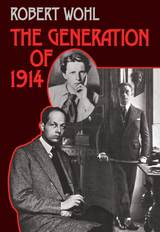 The Generation of 1914
Robert Wohl
Harvard University Press, 1979 The generation of 1914 holds a special place in memory, affection, and myth. In this irresistible and moving book, Robert Wohl rescues it from the shadows of legend and brings it fully into the realm of understanding. He tells the story of the young men--the middle class elite of five European countries, France, Germany, England, Spain, and Italy, to recreate the generational consciousness that united them as well as the unique national experience that made them different.
These were men born at the end of the nineteenth century when the world of reason was disintegrating into a world of irrationality. They were destined to rule but their lives were interrupted by the greatest of wars, leaving them searching for identity and historical continuity. Wohl recaptures this search through novels, poems, autobiographies, memoirs, sociological treatises, philosophical essays, university lectures, political speeches, conversations when recorded, letters, personal notebooks, and newspaper articles. His book is a brilliant study of European mentalities, both collective and individual.
Probing behind ideas to find the experience that inspired them, Wohl illuminates in unexpected ways the origins of World War I and its impact on its participants. His exploration of the consciousness of generational unity and the power of the generational bond enables him to place in a novel context the spread of pessimism and despair, the waning of liberal and humanitarian values, the rise of Communist and Fascist movements, and the sudden eruption of violence in Europe's progressive countries between the two world wars.
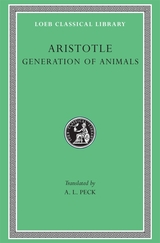 Generation of Animals
Aristotle
Harvard University Press Efficient causes of life.
Aristotle, great Greek philosopher, researcher, reasoner, and writer, born at Stagirus in 384 BC, was the son of a physician. He studied under Plato at Athens and taught there (367–347); subsequently he spent three years at the court of a former pupil in Asia Minor. After some time at Mitylene, in 343–342 he was appointed by King Philip of Macedon to be tutor of his teen-aged son Alexander. After Philip’s death in 336, Aristotle became head of his own school (of “Peripatetics”), the Lyceum at Athens. Because of anti-Macedonian feeling there after Alexander’s death in 323, he withdrew to Chalcis in Euboea, where he died in 322.
Nearly all the works Aristotle prepared for publication are lost; the priceless ones extant are lecture-materials, notes, and memoranda (some are spurious). They can be categorized as follows:
I Practical: Nicomachean Ethics; Great Ethics (Magna Moralia); Eudemian Ethics; Politics; Economics (on the good of the family); On Virtues and Vices.
II Logical: Categories; Analytics (Prior and Posterior); Interpretation; Refutations used by Sophists; Topica.
III Physical: Twenty-six works (some suspect) including astronomy, generation and destruction, the senses, memory, sleep, dreams, life, facts about animals, etc.
IV Metaphysics: on being as being.
V Art: Rhetoric and Poetics.
VI Other works including the Constitution of Athens; more works also of doubtful authorship.
VII Fragments of various works such as dialogues on philosophy and literature; and of treatises on rhetoric, politics, and metaphysics.
The Loeb Classical Library edition of Aristotle is in twenty-three volumes.
 GENERATION OF BOOMERS
Shelton Stromquist
University of Illinois Press, 2000 "'Boomer' railroad men have a cherished place in the popular imagination. Although the romance of their vocations and the itinerancy of their lives have been exaggerated, the term ‘Boomer' fittingly characterizes a significant portion of the generation of workers that built and operated the railroads during the expansive years of the late nineteenth century. There are numerous excellent accounts of the major railroad strikes for this period. There is also a rich literature of local studies that focus primarily on changes in working class culture and community in a variety of industrial settings. But we lack a framework for integrating the local analysis of social and cultural patterns with changes in the political economy of nineteenth-century American capitalism, and we lack an analysis of strikes that locates episodes within broader patterns of emerging class conflict. This volume is an attempt to build such a larger framework."
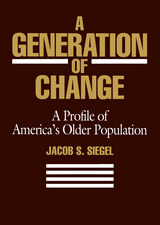 A Generation of Change: A Profile of America's Older Population
Jacob S. Siegel
Russell Sage Foundation, 1993 A Generation of Change is an exceptional study of the nation's elderly, a population that has undergone profound changes in the years since World War II. As modern medicine extends the average life span and the baby boom generation begins to approach middle age, the number of older Americans is expected to more than double in the next century. Currently, 75 percent of U.S. health care expenditures go toward the elderly. But as national trends toward early retirement and low birthrate continue, an aging American population could face crises in meeting their financial and physical needs. According to Jacob S. Siegel in A Generation of Change, astute public planning must be informed by an understanding of the demographic, social, and economic characteristics of the older population, as it is today and as it will be in the coming years. Siegel employs census and survey data from 1950 through the mid-1980s to describe a population constantly shifting in its ethnic and gender composition, geographic distribution, marital and living arrangements, health, employment, and economic status. Surprisingly, there is tremendous disparity in the quality of life among the elderly. Although their average poverty rate is below that of the general population, there are dramatic levels of poverty among older women, who are far more likely than men to live alone or in institutions. As the elderly progress from the "young old" to the "aged old"—those over 85—sharp differences emerge as income and employment decrease and degrees of chronic illness increase. In addition, residential location influences the quality of health care and public assistance available to the elderly, an effect that may account for the marked migration of older people to Florida and Arizona. Siegel analyzes the full range of characteristics for this heterogenous population and, through comparisons with other age groups as well as with the elderly of the previous decades, portrays the crucial influence of social and economic conditions over the life course on the quality of later life. With our elderly population growing more numerous and long lived, accurate information about them is increasingly essential. A Generation of Change will serve as a valuable resource for policymakers seeking more effective solutions in critical areas such as housing, long-term health care, and the funding of Social Security and retirement programs. A Volume in the Russell Sage Foundation Census Series
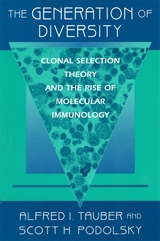 The Generation of Diversity: Clonal Selection Theory and the Rise of Molecular Immunology
Scott H. Podolsky and Alfred I. Tauber
Harvard University Press, 1997 In recent decades immunology has been one of the most exciting--and successful--fields of biomedical research. Over the past thirty years immunologists have acquired a detailed understanding of the immune system's unique recognition mechanism and of the cellular and chemical means used to destroy or neutralize invading organisms. This understanding has been formulated in terms of the clonal selection theory, the dominant explanation of immune behavior. That story is the subject of The Generation of Diversity.
A major problem for immunologists had long been to determine how cells of the immune system could produce millions of distinct antibodies--and produce them on demand. The clonal selection theory explains that cells with genetic instructions to produce each antibody exist in the body in small numbers until exposure to the right molecule--the antigen--triggers the selective cloning that will reproduce exactly the cell needed. But how can so many different antibody-producing cells be generated from such limited genetic material? The solution to this question came from new applications of molecular biology, and, as the authors argue, the impact of the new techniques changed both the methods and the concepts of immunology.
The Generation of Diversity is an intellectual history of the major theoretical problem in immunology and its resolution in the post-World War II period. It will provide for immunologists essential background for understanding the conceptual conflicts occurring in the field today.
 A Generation of Women: Education in the Lives of Progressive Reformers
Ellen Condliffe Lagemann
Harvard University Press, 1979 This is a thorough evaluation of the experience shared by a crucial generation of American women, widely known but never fully understood: the progressive social reformers of the early twentieth century. Lagemann portrays five such reformers, Grace Dodge, Maud Nathan, Lillian Wald, Leonora O'Reilly, and Rose Schneiderman, all of New York. Her work breaks new ground with its analysis of the forces that shaped the development of these women, their personalities, their careers, and their consciousness.
Lagemann's concern is education--not in the limited sense of going to college, but education as a lifelong "process of interaction that changes the self." She deals with the combined influences of pedagogy--especially that of parents, vocational mentors, and colleagues--work, and feminism. Lagemann skillfully demonstrates the effects of social, cultural, economic, and intellectual currents on the education of women in the late nineteenth and early twentieth centuries.
The relationships Lagemann shows between education and individual achievement and between education and social change create a new understanding of feminism and progressivism in the early twentieth century.
 A Generation of Writers and Bulgarian Cultural Politics: From Independence to Communism
Irina Gigova
Central European University Press, 2026 In the aftermath of Bulgaria’s liberation from Ottoman rule, a cohort of young men and women found a home in the European arts. This book follows the lives and works of the post-1878 generation of cultural producers who defined Bulgarian identity. A sweeping narrative of social and political change and personal adaptation, the book explores the country’s evolving literary and artistic scene from the 1890s to the 1950s. It traces the impact of wars and coups, ideological shifts and state policies. The book highlights the contributions of key figures and professional associations, their struggles for artistic autonomy, and their efforts to bridge the gaps between high culture and mass entertainment, national and universal art. A portrait of a generation that transformed Bulgarian culture as it navigated the tumult of the early twentieth century, this book offers insights into the broader patterns of transformation, disruption, and cultural negotiation in modern Europe.
 Generation Palestine: Voices from the Boycott, Divestment and Sanctions Movement
Edited by Rich Wiles
Pluto Press, 2013 The unique model of apartheid, colonisation and military occupation that Israel imposes on the Palestinians, along with myriad violations of international law, have made Palestine the moral cause of a generation. Yet many people continue to ask, ‘what can we do?’
Generation Palestine helps to answer this question by bringing together Palestinian and international activists in the Boycott, Divestment and Sanctions (BDS) movement. The movement aims to pressure Israel until it complies with International Law, mirroring the model that was successfully utilised against South African apartheid.
With essays written by a wide selection of contributors, Generation Palestine follows the BDS movement’s model of inclusivity and collaboration. Contributors include Archbishop Desmond Tutu, Ken Loach, Iain Banks, Ronnie Kasrils, Professor Richard Falk, Ilan Pappe, Omar Barghouti, Ramzy Baroud and Archbishop Attallah Hannah, alongside other internationally acclaimed artists, writers, academics and grassroots activists.
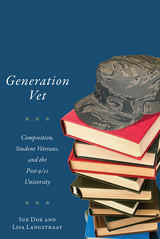 Generation Vet: Composition, Student Veterans, and the Post-9/11 University
Sue Doe
Utah State University Press, 2014 Institutions of higher education are experiencing the largest influx of enrolled veterans since World War II, and these student veterans are transforming post-secondary classroom dynamics. While many campus divisions like admissions and student services are actively moving to accommodate the rise in this demographic, little research about this population and their educational needs is available, and academic departments have been slower to adjust. In Generation Vet, fifteen chapters offer well-researched, pedagogically savvy recommendations for curricular and programmatic responses to student veterans for English and writing studies departments. In work with veterans in writing-intensive courses and community contexts, questions of citizenship, disability, activism, community-campus relationships, and retention come to the fore. Moreover, writing-intensive courses can be sites of significant cultural exchanges—even clashes—as veterans bring military values, rhetorical traditions, and communication styles that may challenge the values, beliefs, and assumptions of traditional college students and faculty. This classroom-oriented text addresses a wide range of issues concerning veterans, pedagogy, rhetoric, and writing program administration. Written by diverse scholar-teachers and written in diverse genres, the essays in this collection promise to enhance our understanding of student veterans, composition pedagogy and administration, and the post-9/11 university.
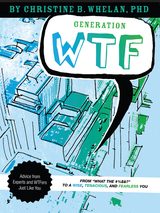 Generation WTF: From What the #$%&! to a Wise, Tenacious, and Fearless You: Advice on How to Get There from Experts and WTFers Just Like You
Christine B. Whelan
Templeton Press, 2011 We all know what “WTF” usually means: it’s an exclamation of frustration, anger, and an understandable reaction to the brutal new economic realities that have hit young adults harder than any other group. WTF happened to promises of a bright future? What happened to the jobs? And what do we do now that the rules have changed? Recent college grads were raised in a time of affluence and entitlement, lulled into thinking that a golden future would happen. Young adults with few role models to teach values like thrift, perseverance, and self-control are ill-equipped to cope with sacrifice and failure. Their dismal employment prospects are merely the most visible symptom of more significant challenges. Fortunately, it’s not too late to change course. This optimistic, reflective, and technologically savvy generation already possesses the tools to thrive—if only they learn to harness the necessary skills for success. In Generation WTF, Christine Whelan does just that. Dr. Whelan, one of the foremost authorities on the history of the self-help genre, worked with more than one hundred young people to test and tweak the best old-school advice and personalize it for the modern twenty-something. After a decade of researching the industry—and years advising “WTFers” as they struggle to make their way in the “real world”—Dr. Whelan knows firsthand what advice works and what Generation WTF has to offer. Rather than focusing on the frustration that “WTF” usually stands for, Dr. Whelan leads the charge to reclaim the acronym as a battle cry for a positive future: Generation WTF will be a wise, tenacious, and fearless generation, strengthened by purpose and hope. This practical new guide will show these WTFers the way to success and instill lasting habits that will serve them well in both good times and bad.
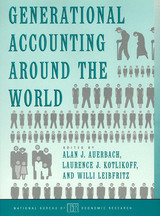 Generational Accounting around the World
Edited by Alan J. Auerbach, Laurence J. Kotlikoff, and Willi Leibfritz
University of Chicago Press, 1999 The realities of mounting government debt, tax burdens, and an aging population raise serious concerns about the financial legacy confronting future generations. How great a fiscal burden will current policies leave to subsequent generations, and how might changes in those policies alter the intergenerational distribution of public welfare? Generational accounting has recently emerged as a robust new method of fiscal analysis and planning designed to assess the long-term sustainability of fiscal policy and to measure the extent of the financial load ultimately borne by present and future generations. A seminal contribution to public economics, generational accounting has already been adopted by 23 nations around the world.
Combining the latest and most extensive country-by-country generational analyses with a comprehensive review of generational accounting's innovative methodology, these papers are a consummate resource for economists, political scientists, and policy makers concerned with fiscal health and responsibility.
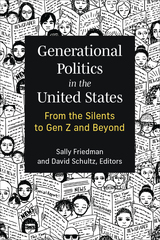 Generational Politics in the United States: From the Silents to Gen Z and Beyond
Sally Friedman and David Schultz, Editors
University of Michigan Press, 2024 The role of generations is an important, yet often overlooked, variable in the study of American politics. A topic of research in sociology, business, and marketing, the focus on generations frequently occurs in American pop culture and journalism. The general public often assumes that different generations have different political leanings and beliefs—that the Silent Generation is all Republican, white, and conservative, or that Millennials are liberal and diverse—but are these assumptions true?
Generational Politics in the United States is the first comprehensive book that examines the concept of generations from a political science perspective. It defines what a generation is and how to sort out the differences between life cycle, cohort, and aging effect. The book then brings together chapters from an array of political science scholars that examine the role of generations in American politics and how it relates to other variables such as age, race, gender, and socioeconomic status. It discusses how politics in the United States are impacted by changes in generations, including how the passing of the Baby Boom generation and rise of the Millennials and Gen Z will change American politics. By examining the differences in political attitudes, engagement, and impact of recent generations, Generational Politics in the United States suggests how generational change will impact American politics in the future.
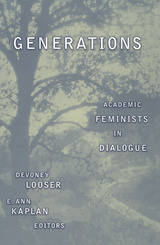 Generations: Academic Feminists In Dialogue
Devoney Looser
University of Minnesota Press, 1997 Explores the conflicts and challenges facing older and younger feminist scholars. In universities and colleges across the country, feminists are debating their histories and future legacies, often expressing these controversies in generational terms. Some older, second wave feminists accuse younger ones of being careerist, overly theoretical, insufficiently political, and not grateful enough to previous generations. Some third wave feminists consider their foremothers naive, universalizing, or elitist, resentful of deviations from their established plans and improperly wielding their power. Generations addresses these divisions and impasses through sophisticated analyses of the challenges of “passing the torch.” Generations is composed of essays from academic women at various professional stages-from established scholars to junior professors to graduate students. Some are concerned with telling intergenerational feminist histories based on both research and experience. Others describe difficulties faced by feminists of all ages in the academy today. A final cluster considers issues in the highly charged convergence of feminist theory and postmodernism. The promise of feminisms yet to come can be found in these pages, alongside some of the most resonant and important feminist voices of the last two decades. Generations both complicates and enlivens the transmission and rebirth of feminist knowledges from one generation to another. Contributors: Diane Elam, U of Wales; Elizabeth Francis, Brown U; Linda Frost, U of Alabama; Jane Gallop, U of Wisconsin; Dana Heller, Old Dominion U; Jane Kalbfleisch; Jeanne Marecek, Swarthmore College; Nancy K. Miller, CUNY; Mona Narain, Otterbein College; Angela M. S. Nelson, Bowling Green State U; Judith Newton, U of California, Davis; Rebecca Dakin Quinn; Gita Rajan, Fairfield U; Judith Roof, Indiana U; Theresa Ann Sears, U of Missouri at St. Louis; Ruthe Thompson; Michele Wallace, CUNY; Barbara A. White, U of New Hampshire; Lynda Zwinger, U of Arizona.
 Generations and Collective Memory
Amy Corning and Howard Schuman
University of Chicago Press, 2015 When discussing large social trends or experiences, we tend to group people into generations. But what does it mean to be part of a generation, and what gives that group meaning and coherence? It's collective memory, say Amy Corning and Howard Schuman, and in Generations and Collective Memory, they draw on an impressive range of research to show how generations share memories of formative experiences, and how understanding the way those memories form and change can help us understand society and history.
Their key finding—built on historical research and interviews in the United States and seven other countries (including China, Japan, Germany, Lithuania, Russia, Israel, and Ukraine)—is that our most powerful generational memories are of shared experiences in adolescence and early adulthood, like the 1963 Kennedy assassination for those born in the 1950s or the fall of the Berlin Wall for young people in 1989. But there are exceptions to that rule, and they're significant: Corning and Schuman find that epochal events in a country, like revolutions, override the expected effects of age, affecting citizens of all ages with a similar power and lasting intensity.
The picture Corning and Schuman paint of collective memory and its formation is fascinating on its face, but it also offers intriguing new ways to think about the rise and fall of historical reputations and attitudes toward political issues.
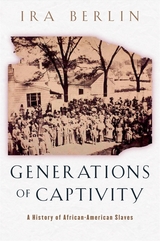 Generations of Captivity: A History of African-American Slaves
Ira Berlin
Harvard University Press, 2003 Ira Berlin traces the history of African-American slavery in the United States from its beginnings in the seventeenth century to its fiery demise nearly three hundred years later.
Most Americans, black and white, have a singular vision of slavery, one fixed in the mid-nineteenth century when most American slaves grew cotton, resided in the deep South, and subscribed to Christianity. Here, however, Berlin offers a dynamic vision, a major reinterpretation in which slaves and their owners continually renegotiated the terms of captivity. Slavery was thus made and remade by successive generations of Africans and African Americans who lived through settlement and adaptation, plantation life, economic transformations, revolution, forced migration, war, and ultimately, emancipation.
Berlin's understanding of the processes that continually transformed the lives of slaves makes Generations of Captivity essential reading for anyone interested in the evolution of antebellum America. Connecting the "Charter Generation" to the development of Atlantic society in the seventeenth century, the "Plantation Generation" to the reconstruction of colonial society in the eighteenth century, the "Revolutionary Generation" to the Age of Revolutions, and the "Migration Generation" to American expansionism in the nineteenth century, Berlin integrates the history of slavery into the larger story of American life. He demonstrates how enslaved black people, by adapting to changing circumstances, prepared for the moment when they could seize liberty and declare themselves the "Freedom Generation."
This epic story, told by a master historian, provides a rich understanding of the experience of African-American slaves, an experience that continues to mobilize American thought and passions today.
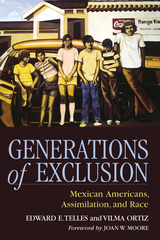 Generations of Exclusion: Mexican-Americans, Assimilation, and Race
Edward E. Telles
Russell Sage Foundation, 2008 Foreword by Joan W. Moore When boxes of original files from a 1965 survey of Mexican Americans were discovered behind a dusty bookshelf at UCLA, sociologists Edward Telles and Vilma Ortiz recognized a unique opportunity to examine how the Mexican American experience has evolved over the past four decades. Telles and Ortiz located and re-interviewed most of the original respondents and many of their children. Then, they combined the findings of both studies to construct a thirty-five year analysis of Mexican American integration into American society. Generations of Exclusion is the result of this extraordinary project. Generations of Exclusion measures Mexican American integration across a wide number of dimensions: education, English and Spanish language use, socioeconomic status, intermarriage, residential segregation, ethnic identity, and political participation. The study contains some encouraging findings, but many more that are troubling. Linguistically, Mexican Americans assimilate into mainstream America quite well—by the second generation, nearly all Mexican Americans achieve English proficiency. In many domains, however, the Mexican American story doesn't fit with traditional models of assimilation. The majority of fourth generation Mexican Americans continue to live in Hispanic neighborhoods, marry other Hispanics, and think of themselves as Mexican. And while Mexican Americans make financial strides from the first to the second generation, economic progress halts at the second generation, and poverty rates remain high for later generations. Similarly, educational attainment peaks among second generation children of immigrants, but declines for the third and fourth generations. Telles and Ortiz identify institutional barriers as a major source of Mexican American disadvantage. Chronic under-funding in school systems predominately serving Mexican Americans severely restrains progress. Persistent discrimination, punitive immigration policies, and reliance on cheap Mexican labor in the southwestern states all make integration more difficult. The authors call for providing Mexican American children with the educational opportunities that European immigrants in previous generations enjoyed. The Mexican American trajectory is distinct—but so is the extent to which this group has been excluded from the American mainstream. Most immigration literature today focuses either on the immediate impact of immigration or what is happening to the children of newcomers to this country. Generations of Exclusion shows what has happened to Mexican Americans over four decades. In opening this window onto the past and linking it to recent outcomes, Telles and Ortiz provide a troubling glimpse of what other new immigrant groups may experience in the future.
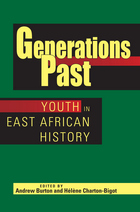 Generations Past: Youth in East African History
Andrew Burton
Ohio University Press, 2010 Contemporary Africa is demographically characterized above all else by its youthfulness. In East Africa the median age of the population is now a striking 17.5 years, and more than 65 percent of the population is age 24 or under. This situation has attracted growing scholarly attention, resulting in an important and rapidly expanding literature on the position of youth in African societies. While the scholarship examining the contemporary role of youth in African societies is rich and growing, the historical dimension has been largely neglected in the literature thus far. Generations Past seeks to address this gap through a wide-ranging selection of essays that covers an array of youth-related themes in historical perspective. Thirteen chapters explore the historical dimensions of youth in nineteenth-, twentieth-, and twenty-first–century Ugandan, Tanzanian, and Kenyan societies. Key themes running through the book include the analytical utility of youth as a social category; intergenerational relations and the passage of time; youth as a social and political problem; sex and gender roles among East African youth; and youth as historical agents of change. The strong list of contributors includes prominent scholars of the region, and the collection encompasses a good geographical spread of all three East African countries.
Generative AI for Sign Language Recognition and Translation
Elakkiya Rajasekar
The Institution of Engineering and Technology, 2026 Sign languages differ fundamentally from spoken and written languages, with their own grammar, syntax, and three-dimensional expression involving hand gestures, facial expressions, body movements, and spatial relationships. These non-manual elements are crucial in conveying grammatical structures, nuances, and emotional tones, making sign languages uniquely complex communication systems.
Generative AI Unleashed: Advancements, transformative applications and future frontiers
Karthik Ramamurthy
The Institution of Engineering and Technology, 2025 Today's generative AI has been marked by the advent of neural networks, inspired by the human brain, which are trained to recognize patterns in a dataset. Once the network is trained, it can make decisions or predictions without being programmed to perform tasks. Generative AI learns from a set of data without explicit instructions and can create and generate new digital content such as text, audio and art. Recent models are beginning to overcome challenges such as computational power, data quality and training stability.
The Generic Book: The Semantics of Generics
Edited by Gregory N. Carlson and Francis Jeffry Pelletier
University of Chicago Press, 1995 In an attempt to address the theoretical gap between linguistics and philosophy, a group of semanticists, calling itself the Generic Group, has worked to develop a common view of genericity. Their research has resulted in this book, which consists of a substantive introduction and eleven original articles on important aspects of the interpretation of generic expressions. The introduction provides a clear overview of the issues and synthesizes the major analytical approaches to them. Taken together, the papers that follow reflect the current state of the art in the semantics of generics, and afford insight into various generic phenomena.
Generic Tree Flora of Madagascar
George E. Schatz
Royal Botanic Gardens, Kew, 2001 This is a practical field manual for the identification of the 500 genera of native and naturalized Malagasy trees. Identification keys emphasise vegetative and gross morphological features. All genera are provided with full descriptions, distribution information, key characteristics, up-to-date taxonomic references and over 3,000 Malagasy vernacular names, and almost all are illustrated.
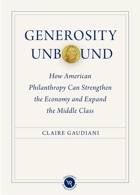 Generosity Unbound: How American Philanthropy Can Strengthen the Economy and Expand the Middle Class
Claire Gaudiani
American Philanthropic, 2010
In Generosity Unbound, Claire Gaudiani mounts a spirited defense of philanthropic freedom addressed to conservatives, liberals and centrists. She acknowledges the good intentions of those who favor greater regulation of private philanthropy, but powerfully demonstrates the dangers of this approach.
But this book is more than a warning. Gaudiani also uncovers the fascinating history of philanthropy in America, showing how this nation’s distinctive tradition of citizen-to-citizen generosity has been a powerful engine of economic growth, social justice, and upward mobility.
Finally, Gaudiani calls on foundation leaders, legislators, and concerned citizens to take up anew the great challenge set forth by our nation’s Founders in the Declaration of Independence. She proposes an all-out citizen-led effort to deliver on the Declaration’s promise of life, liberty and the pursuit of happiness for all of us, particularly our poorest citizens. The success of such a ‘Declaration Initiative’ would enable us to justly celebrate the nation’s 250th birthday on July 4th, 2026.
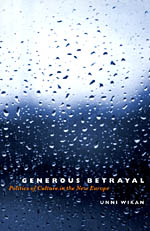 Generous Betrayal: Politics of Culture in the New Europe
Unni Wikan
University of Chicago Press, 2002 All over Western Europe, the lot of many non-Western immigrants is one of marginalization, discrimination, and increasing segregation. In this bold and controversial book, Unni Wikan shows how an excessive respect for "their culture" has been part of the problem. Culture has become a new concept of race, sustaining ethnic identity politics that subvert human rights—especially for women and children. Fearful of being considered racist, state agencies have sacrificed freedom and equality in the name of culture.
Comparing her native Norway to Western Europe and the United States, Wikan focuses on people caught in turmoil, how institutions function, and the ways in which public opinion is shaped and state policies determined. Contradictions arise between policies of respect for minority cultures, welfare, and freedom, but the goal is the same: to create a society committed to both social justice and respect for human rights.
Writing with power and grace, Wikan makes a plea for a renewed moral vitality and human empathy that can pave the way for more effective social policies and create change.
 A Generous Nature: Lives Transformed by Oregon
Marcy Cottrell Houle
Oregon State University Press, 2019 A Generous Nature: Lives Transformed by Oregon offers profiles of twenty-one conservationists and activists who have made enduring contributions to the preservation of Oregon’s wild and natural places and high quality of life. These stories speak to their courage, foresight, and actions—at times against great odds— to enact legislation and motivate others to cherish and protect the places that make Oregon unique. Taken from personal interviews conducted by the author over a decade, these stories will help readers understand the histories of Oregon’s exceptional places, innovative planning efforts, and laws. They provide insight into the principles and values that motivated individuals to preserve the beauty and natural resources of Oregon, craft legislation to further protect them, and educate others about their value. Houle features locations as diverse as the Columbia River Gorge Natural Scenic Area, the wild and scenic Sandy River, and Tryon Creek State Park, along with background on critical laws and organizations such as the Beach Bill, Diack Act, Senate Bill 100, SOLVE, and the High Desert Partnership. These stories do more than educate. They will inspire readers and demonstrate that individually we can make a difference. A Generous Nature is a crucial reminder of our responsibility to stand for and defend the places, ideals, and laws that make Oregon a progressive model for the rest of the nation.
 Genes And Human Self-Knowledge: Reflections On Modern Genetics
Robert F. Weir
University of Iowa Press, 1994 Contemporary developments in human genetics are profoundly meaningful, both for the rapidity of scientific discoveries and for their personal and social implications. The Human Genome Project, a worldwide effort to map the 50,000 to 100,000 genes making up the human blueprint, is creating new ways of understanding ourselves as individuals, as parents, as members of a family, an ethnic group, a species. Almost every day yet another medical detective finds a genetic clue to the long-running mystery of human identity. In 1992, the University of Iowa Humanities Symposium provided a public forum to examine the issues—moral, conceptual, legal, and practical—in modern genetics that are crucial to all of us. This strong, challenging volume is a collection of the major essays presented by historians, philosophers, and other academic humanists to a multidisciplinary audience of molecular and clinical geneticists, genetic counselors, humanists, and members of the public. The essays explore the historical background, philosophical implications, and ethical issues related to the Human Genome Project as well as other developments in modern genetics. The questions raised in these essays are dramatic and troubling. What kind of knowledge is being produced by molecular geneticists? Do individual human genomes differ significantly from each other? How much do females and males differ from each other at the molecular level? Is there any genetic basis for distinguishing among racial or ethical groups? Can current practices in genetics counseling be compared to the earlier eugenics movement? Will current research lead to updated views on genetic “normalcy” or even “superiority”?
 Genes, Blood, and Courage: A Boy Called Immortal Sword
David Nathan
Harvard University Press, 1995 David Nathan was stunned when he first saw Dayem Saif at Children's Hospital in Boston in September 1968. Dayem was then a six-year-old with the stature of an average-sized boy of two. He wore baby shoes on his tiny feet and was unable to walk without holding his mother's hand. His color was dark yet pasty and his face horribly misshapen. The child was being ravaged by thalassemia, a life-threatening inherited disease of the blood, and one of the leading causes of disfigurement, disability, and death in children worldwide. Without effective treatment, Dayem would almost certainly die before his twentieth birthday.
Genes, Blood, and Courage is David Nathan's absorbing story of the thirty-year struggle to keep Dayem alive. "Immortal Sword" is the English translation of Dayem's Arabic name, and under Nathan's care Dayem, indeed, seems immortal. Despite his continual reluctance to follow his doctor's orders and the repeated hospitalizations that result, Dayem--the misshapen, stunted boy--survives to become a handsome, successful businessman.
In Genes, Blood, and Courage Nathan goes beyond his struggles with this seemingly immortal patient to describe in detail the emergence, over the past twenty-five years, of an entirely new force in medical care called molecular medicine. As Dayem's case illustrates, this new area of human genetic research--in which Nathan is a leading clinical investigator--promises tremendous advances in the rational diagnosis, prevention, and treatment of inherited disorders, such as thalassemia and sickle cell anemia, and even of acquired illnesses such as cancer and infectious disease.
Genes, Blood, and Courage is a celebration not just of Dayem's triumphs but also of the tremendous accomplishments and potential of the American biomedical research enterprise in the late twentieth century.
 Genes in Conflict: The Biology of Selfish Genetic Elements
Austin Burt and Robert Trivers
Harvard University Press, 2008 In evolution, most genes survive and spread within populations because they increase the ability of their hosts (or their close relatives) to survive and reproduce. But some genes spread in spite of being harmful to the host organism—by distorting their own transmission to the next generation, or by changing how the host behaves toward relatives. As a consequence, different genes in a single organism can have diametrically opposed interests and adaptations.Covering all species from yeast to humans, Genes in Conflict is the first book to tell the story of selfish genetic elements, those continually appearing stretches of DNA that act narrowly to advance their own replication at the expense of the larger organism. As Austin Burt and Robert Trivers show, these selfish genes are a universal feature of life with pervasive effects, including numerous counter-adaptations. Their spread has created a whole world of socio-genetic interactions within individuals, usually completely hidden from sight.Genes in Conflict introduces the subject of selfish genetic elements in all its aspects, from molecular and genetic to behavioral and evolutionary. Burt and Trivers give us access for the first time to a crucial area of research—now developing at an explosive rate—that is cohering as a unitary whole, with its own logic and interconnected questions, a subject certain to be of enduring importance to our understanding of genetics and evolution.
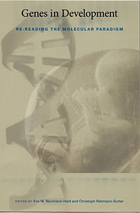 Genes in Development: Re-reading the Molecular Paradigm
Eva M. Neumann-Held and Christoph Rehmann-Sutter, eds.
Duke University Press, 2006 In light of scientific advances such as genomics, predictive diagnostics, genetically engineered agriculture, nuclear transfer cloning, and the manipulation of stem cells, the idea that genes carry predetermined molecular programs or blueprints is pervasive. Yet new scientific discoveries—such as rna transcripts of single genes that can lead to the production of different compounds from the same pieces of dna—challenge the concept of the gene alone as the dominant factor in biological development. Increasingly aware of the tension between certain empirical results and interpretations of those results based on the orthodox view of genetic determinism, a growing number of scientists urge a rethinking of what a gene is and how it works. In this collection, a group of internationally renowned scientists present some prominent alternative approaches to understanding the role of dna in the construction and function of biological organisms. Contributors discuss alternatives to the programmatic view of dna, including the developmental systems approach, methodical culturalism, the molecular process concept of the gene, the hermeneutic theory of description, and process structuralist biology. None of the approaches cast doubt on the notion that dna is tremendously important to biological life on earth; rather, contributors examine different ideas of how dna should be represented, evaluated, and explained. Just as ideas about genetic codes have reached far beyond the realm of science, the reconceptualizations of genetic theory in this volume have broad implications for ethics, philosophy, and the social sciences. Contributors. Thomas Bürglin, Brian C. Goodwin, James Griesemer, Paul Griffiths, Jesper Hoffmeyer, Evelyn Fox Keller, Gerd B. Müller, Eva M. Neumann-Held, Stuart A. Newman, Susan Oyama, Christoph Rehmann-Sutter, Sahotra Sarkar, Jackie Leach Scully, Gerry Webster, Ulrich Wolf
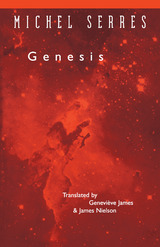 Genesis
Michel Serres
University of Michigan Press, 1997 This English translation of Michel Serres' 1982 book Genèse captures in lucid prose the startling breadth and depth of his thinking, as he probes the relations between order, disorder, knowledge, anxiety, and violence. Written in a unique blend of scientific discourse and lyrical outburst, classical philosophical idiom and conversational intimacy, by turns angry, playful, refined or discordant, Genesis is an attempt to think outside of metaphysical categories of unity or rational order and to make us hear--through both its content and form--the "noise," the "sound and the fury," that are the background of life and thought.
Serres draws on a vast knowledge of such diverse disciplines as anthropology, classical history, music, theology, art history, information theory, physics, biology, dance and athletics, and Western metaphysics, and a range of cultural material that includes the writings of Plato, Kant, August Comte, Balzac, and Shakespeare, to name a few. He argues that although philosophy has been instrumental in the past in establishing laws of logic and rationality that have been crucial to our understanding of ourselves and our universe, one of the most pressing tasks of thought today is to recognize that such pockets of unity are islands of order in a sea of multiplicity--a sea which cannot really be conceived, but which perhaps can still be sensed, felt, and heard raging in chaos beneath the momentary crests of order imposed by human civilization.
Philosophy of science or prose poetry, a classical meditation on metaphysics or a stream-of-consciousness polemic and veiled invective, Serres mounts a quirky, at times rhapsodical, but above all a "noisy" critique of traditional and current models in social theory, historiography, and aesthetics. The result is a work that is at once provocative, poetic, deeply personal, and ultimately religious--an apocalyptic call for the rebirth of philosophy as the art of thinking the unthinkable.
About the Book:
"An intensely beautiful and rigourous meditation on the birth of forms amid chaos and multiplicity from a major philosopher who is also an exquisite craftsman of the written word." --William Paulson, University of Michigan
"Serres exhibits a rare, raw tendentiousness refreshing in its vitriol . . . it's the sort of light-hearted, perverse, and basically liberal tirade one hears too infrequently of late." --Word
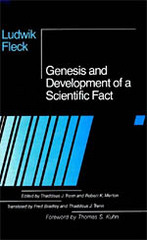 Genesis and Development of a Scientific Fact
Ludwik Fleck
University of Chicago Press, 1981 Originally published in German in 1935, this monograph anticipated solutions to problems of scientific progress, the truth of scientific fact and the role of error in science now associated with the work of Thomas Kuhn and others. Arguing that every scientific concept and theory—including his own—is culturally conditioned, Fleck was appreciably ahead of his time. And as Kuhn observes in his foreword, "Though much has occurred since its publication, it remains a brilliant and largely unexploited resource."
"To many scientists just as to many historians and philosophers of science facts are things that simply are the case: they are discovered through properly passive observation of natural reality. To such views Fleck replies that facts are invented, not discovered. Moreover, the appearance of scientific facts as discovered things is itself a social construction, a made thing. A work of transparent brilliance, one of the most significant contributions toward a thoroughly sociological account of scientific knowledge."—Steven Shapin, Science
Genesis and Geology: A Study of the Relations of Scientific Thought, Natural Theology, and Social Opinion in Great Britain, 1790-1850
Charles Gillispie
Harvard University Press, 1951 First published in 1951, Genesis and Geology describes the background of social and theological ideas and the progress of scientific researches which, between them, produced the religious difficulties that afflicted the development of science in early industrial England. The book makes clear that the furor over On the Origin of Species was nothing new: earlier discoveries in science (particularly geology) had presented major challenges, not only to the literal interpretation of the Book of Genesis, but even more seriously to the traditional idea that Providence controls the order of nature with an eye to fulfilling divine purpose. A new Foreword by Nicolaas A. Rupke places this book in the context of the last forty-five years of scholarship in the social history of evolutionary thought.
 Genesis and Geology: A Study of the Relations of Scientific Thought, Natural Theology, and Social Opinion in Great Britain, 1790–1850, With a Foreword by Nicolaas A. Rupke and a New Preface by the Author
Charles Gillispie
Harvard University Press, 1996 First published in 1951, Genesis and Geology describes the background of social and theological ideas and the progress of scientific researches that, between them, produced the religious difficulties that afflicted the development of science in early industrial England. The book makes clear that the furor over On the Origin of Species was nothing new: earlier discoveries in science, particularly geology, had presented major challenges, not only to the literal interpretation of the Book of Genesis, but even more seriously to the traditional idea that Providence controls the order of nature with an eye to fulfilling divine purpose.
A new Foreword by Nicolaas Rupke places this book in the context of the last forty-five years of scholarship in the social history of evolutionary thought. Everyone interested in the history of modern science, in ideas, and in nineteenth-century England will want to read this book.
Genesis and Structure of Hegel's "Phenomenology of Spirit"
Jean Hyppolite
Northwestern University Press, 1979 Jean Hyppolite produced the first French translation of Hegel's Phenomenology of Spirit. His major works—the translation, his commentary, and Logique et existence (1953)—coincided with an upsurge of interest in Hegel following World War II. Yet Hyppolite's influence was as much due to his role as a teacher as it was to his translation or commentary: Foucault and Deleuze were introduced to Hegel in Hyppolite's classes, and Derrida studied under him. More than fifty years after its original publication, Hyppolite's analysis of Hegel continues to offer fresh insights to the reader.
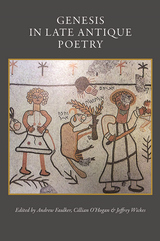 Genesis in Late Antique Poetry
Andrew Faulkner
Catholic University of America Press, 2022 The biblical book of Genesis stands nearly without parallel in the shared history of Judaism, Christianity, and Islam. Because of its abiding importance to late antique theology and practical life across religious boundaries, it gave rise to a wide range of literary responses. The essays in this book study an array of Jewish and Christian responses to Genesis as they took shape in specific literary forms—the unique genres of late antique poetry. While late antique and early medieval Jews and Christians did not always agree in their interpretations of Genesis, they participated broadly in a shared culture of poetic production. Some of these poetic genres paralleled one another simply as distinct examples of metered speech, while others emerged in conversation and through mutual influence. Though late antique poems developed in a variety of languages and across religious boundaries, scholarly study of late antique poetry has tended to isolate the phenomenon according to language. As a corrective to this linguistic isolation, this book initiates a comparative conversation around the Jewish and Christian poetry that emerged in late antique Aramaic, Greek, Hebrew, Latin, and Syriac. Tending equally to exegetical content and literary form, the essays in this book sit at the intersection of a variety of scholarly conversations—around the history of biblical exegesis, the formation of late antique and early medieval literature and literary culture, and the comparative study of Judaism and Christianity.
 The Genesis of Desire
Jean-Michel Oughourlian
Michigan State University Press, 2010 We seem to be abandoning the codes that told previous generations who they should love. But now that many of us are free to choose whoever we want, nothing is less certain. The proliferation of divorces and separations reveal a dynamic we would rather not see: others sometimes reject us as passionately as we are attracted to them.
Our desire makes us sick. The throes of rivalry are at the heart of our attraction to one another. This is the central thesis of Jean-Michel Oughourlian's The Genesis of Desire, where the war of the sexes is finally given a scientific explanation. The discovery of mirror neurons corroborates his ideas, clarifying the phenomena of empathy and the mechanisms of violent reciprocity.
How can a couple be saved when they have declared war on one another? By helping them realize that desire originates not in the self but in the other. There are strategies that can help, which Dr. Oughourlian has prescribed successfully to his patients. This work, alternating between case studies and more theoretical statements, convincingly defends the possibility that breakups need not be permanent.
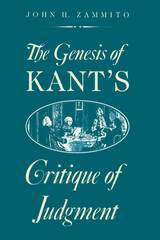 The Genesis of Kant's Critique of Judgment
John H. Zammito
University of Chicago Press, 1992 In this philosophically sophisticated and historically significant work, John H. Zammito reconstructs Kant's composition of The Critique of Judgment and reveals that it underwent three major transformations before publication. He shows that Kant not only made his "cognitive" turn, expanding the project from a "Critique of Taste" to a Critique of Judgment but he also made an "ethical" turn. This "ethical" turn was provoked by controversies in German philosophical and religious culture, in particular the writings of Johann Herder and the Sturm und Drang movement in art and science, as well as the related pantheism controversy. Such topicality made the Third Critique pivotal in creating a "Kantian" movement in the 1790s, leading directly to German Idealism and Romanticism.
The austerity and grandeur of Kant's philosophical writings sometimes make it hard to recognize them as the products of a historical individual situated in the particular constellation of his time and society. Here Kant emerges as a concrete historical figure struggling to preserve the achievements of cosmopolitan Aufkl-rung against challenges in natural science, religion, and politics in the late 1780s. More specifically Zammito suggests that Kant's Third Critique was animated throughout by a fierce personal rivalry with Herder and by a strong commitment to traditional Christian ideas of God and human moral freedom.
"A work of extraordinary erudition. Zammito's study is both comprehensive and novel, connecting Kant's work with the aesthetic and religious controversies of the late eighteenth century. He seems to have read everything. I know of no comparable historical study of Kant's Third Critique."-Arnulf Zweig, translator and editor of Kant's ;IPhilosophical Correspondence, 1759-1799;X
"An intricate, subtle, and exciting explanation of how Kant's thinking developed and adjusted to new challenges over the decade from the first edition of the Critique of Pure Reason to the appearance of the Critique of Judgment."—John W. Burbidge, Review of Metaphysics
"There has been for a long time a serious gap in English commentary on Kant's Critique of Judgment; Zammito's book finally fills it. All students and scholars of Kant will want to consult it."—Frederick Beiser, Times Literary Supplement
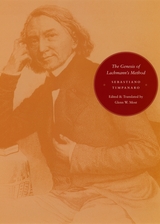 The Genesis of Lachmann's Method
Sebastiano Timpanaro
University of Chicago Press, 2005 Until the modern period, the reproduction of written texts required manual transcription from earlier versions. This cumbersome process inevitably created errors and made it increasingly difficult to identify the original readings among multiple copies. Lachmann's method—associated with German classicist Karl Lachmann (1793-1851)—aimed to provide scholars with a scientific, systematic procedure to standardize the transmission of ancient texts. Although these guidelines for analysis were frequently challenged, they retained a paradigmatic value in philology for many years. In 1963, Italian philologist Sebastiano Timpanaro became the first to analyze in depth the history and limits of Lachmann's widely established theory with his publication, La genesi del metodo del Lachmann.
This important work, which brought Timpanaro international repute, now appears in its first English translation. The Genesis of Lachmann's Method examines the origin, development, and validity of Lachmann's model as well as its association with Lachmann himself. It remains a fundamental work on the history and methods of philology, and Glenn W. Most's translation makes this seminal study available to an English-speaking audience. Revealing Timpanaro's extraordinary talent as a textual critic and world-class scholar, this book will be indispensable to classicists, textual critics, biblical scholars, historians of science, and literary theorists.
The Genesis of Missouri: From Wilderness Outpost to Statehood
William E. Foley
University of Missouri Press, 1989 The story of the blending of diverse cultures in a land rich in resources and beauty is an extraordinary one. In this account, the pioneer hunters, trappers, and traders who roamed the Ozark hills and the boatmen who traded on the Missouri and Mississippi Rivers take their place beside the small coterie of St. Louisans whose wealth and influence enabled them to dominate the region politically and economically. Especially appealing for many readers will be the attention Foley gives to common Missourians, to the status of women and blacks, and to Indian-white relations.
The Genesis of Napoleonic Imperialism
Harold Charles Deutsch
Harvard University Press Of the periods into which one may divide the Napoleonic era, the most unified is the reconstruction which followed the restoration of peace after the War of the Second Coalition. In these four years after the Treaty of Luneville, Napoleon found himself in a situation vastly more favorable to the realization of traditional French claims than that of any of his predecessors. His policy underwent an evolution, motivated by his deliberate plan for the conquest of England by invasion and leading up to his dynastic ambitions. Professor Deutsch’s work, the first intensive study in English of the foreign policy of the early Napoleonic period, is based upon a thorough study of hitherto neglected material in the French and Austrian archives.
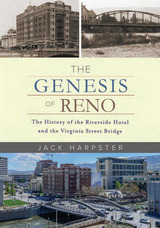 The Genesis of Reno: The History of the Riverside Hotel and the Virginia Street Bridge
Jack Harpster
University of Nevada Press, 2016 Over 157 years ago—before there was a Reno, Nevada; before there was a state of Nevada; and even before there was a Nevada Territory—there was a bridge over the Truckee River at a narrow, deeply rutted cattle and wagon trail that would one day become Virginia Street. There was also a small rustic inn and tavern occupying a plot of ground at the southern end of the log-and-timber bridge, catering to thirsty cowboys, drovers, and miners. The inn and the bridge were the first two structures in what would one day be a bustling metropolitan area, and to this day they still form the nucleus of the city. The Genesis of Reno traces their history up to the present day. The 111 year-old concrete bridge that was replaced in 2016 by a magnificent new structure was honored for its longevity and unique character with placement on the National Register of Historic Places in 1980.
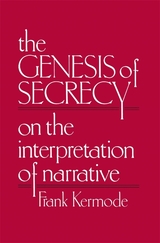 The Genesis of Secrecy: On the Interpretation of Narrative
Frank Kermode
Harvard University Press, 1979 “Brilliant…this book should encourage more literary critics to pick up their Bibles.”—Howard Eiland, Partisan Review
The celebrated critic deciphers the cryptic passages and concealed meanings in literature sacred and profane.
In a passage from the Gospel of Mark that has spawned more exegetical disputes than perhaps any other, the disciples question Jesus about why he so often speaks in parables. “To you has been given the secret of the kingdom of God,” he replies, “but for those outside everything is in parables; so that they may indeed see but not perceive, and may indeed hear but not understand.” The ostensible meaning of this passage seems shockingly unchristian: the true sense of Jesus’s stories—their secret—is reserved for the elect, for the insiders. Outsiders be damned.
In The Genesis of Secrecy, the prolific Frank Kermode draws upon this and other enigmatic passages in the Gospels to interrogate the fraught relationship between proclaimed meaning and concealed mystery, both in the New Testament and in modern secular literature. A resolute outsider to the rules and canons of Biblical exegesis, he asks how it is that textual dislocations or contradictory narrative elements are imbued with the grandeur of secret meaning. Departing from the Bible, he also asks what the art of interpretation looks like in a secular world, when the lines separating heresy from orthodoxy have become increasingly blurred.
Moving effortlessly between Scripture, philosophical hermeneutics, narrative theory, and twentieth-century literature from Joyce to Pynchon, Kermode concludes, pessimistically, that esoteric truths of the text are glimpsed but never finally revealed. Divination begets further divination. Secrecy remains “the source of the interpreter’s pleasures, but also of his necessary disappointment.”
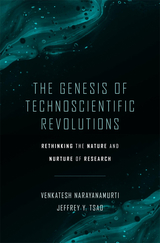 The Genesis of Technoscientific Revolutions: Rethinking the Nature and Nurture of Research
Venkatesh Narayanamurti and Jeffrey Y. Tsao
Harvard University Press, 2021 Research powers innovation and technoscientific advance, but it is due for a rethink, one consistent with its deeply holistic nature, requiring deeply human nurturing.
Research is a deeply human endeavor that must be nurtured to achieve its full potential. As with tending a garden, care must be taken to organize, plant, feed, and weed—and the manner in which this nurturing is done must be consistent with the nature of what is being nurtured.
In The Genesis of Technoscientific Revolutions, Venkatesh Narayanamurti and Jeffrey Tsao propose a new and holistic system, a rethinking of the nature and nurturing of research. They share lessons from their vast research experience in the physical sciences and engineering, as well as from perspectives drawn from the history and philosophy of science and technology, research policy and management, and the evolutionary biological, complexity, physical, and economic sciences.
Narayanamurti and Tsao argue that research is a recursive, reciprocal process at many levels: between science and technology; between questions and answer finding; and between the consolidation and challenging of conventional wisdom. These fundamental aspects of the nature of research should be reflected in how it is nurtured. To that end, Narayanamurti and Tsao propose aligning organization, funding, and governance with research; embracing a culture of holistic technoscientific exploration; and instructing people with care and accountability.
Genesis of The Brothers Karamazov: The Aesthetics, Ideology, and Psychology of Making a Text
Robert L. Belknap
Northwestern University Press, 1990 Robert L. Belknap is the author of The Structure of "The Brothers Karamazov," which is generally regarded as one of the best studies on Dostoevsky produced by the present generation of scholars. The Genesis of "The Brothers Karamazov" continues and complements Belknap's earlier work, tracing Dostoevsky's last, great novel to its sources and exploring the works Dostoevsky read and consciously employed in constructing it.
The Genesis of Values
Hans Joas
University of Chicago Press, 2001 Public and intellectual debates have long struggled with the concept of values and the difficulties of defining them. With The Genesis of Values, renowned theorist Hans Joas explores the nature of these difficulties in relation to some of the leading figures of twentieth-century philosophy and social theory: Friedrich Nietzsche, William James, Max Scheler, John Dewey, Georg Simmel, Charles Taylor, and Jürgen Habermas. Joas traces how these thinkers came to terms with the idea of values, and then extends beyond them with his own comprehensive theory. Values, Joas suggests, arise in experiences in self-formation and self-transcendence. Only by appreciating the creative nature of human action can we understand how our values arise.
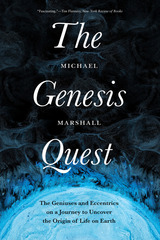 The Genesis Quest: The Geniuses and Eccentrics on a Journey to Uncover the Origin of Life on Earth
Michael Marshall
University of Chicago Press, 2020 From the primordial soup to meteorite impact zones, the Manhattan Project to the latest research, this book is the first full history of the scientists who strive to explain the genesis of life.
How did life begin? Why are we here? These are some of the most profound questions we can ask.
For almost a century, a small band of eccentric scientists has struggled to answer these questions and explain one of the greatest mysteries of all: how and why life began on Earth. There are many different proposals, and each idea has attracted passionate believers who promote it with an almost religious fervor, as well as detractors who reject it with equal passion.
But the quest to unravel life’s genesis is not just a story of big ideas. It is also a compelling human story, rich in personalities, conflicts, and surprising twists and turns. Along the way, the journey takes in some of the greatest discoveries in modern biology, from evolution and cells to DNA and life’s family tree. It is also a search whose end may finally be in sight.
In The Genesis Quest, Michael Marshall shows how the quest to understand life’s beginning is also a journey to discover the true nature of life, and by extension our place in the universe.
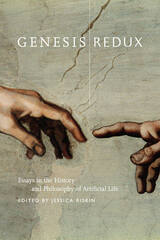 Genesis Redux: Essays in the History and Philosophy of Artificial Life
Edited by Jessica Riskin
University of Chicago Press, 2007 Since antiquity, philosophers and engineers have tried to take life’s measure by reproducing it. Aiming to reenact Creation, at least in part, these experimenters have hoped to understand the links between body and spirit, matter and mind, mechanism and consciousness. Genesis Redux examines moments from this centuries-long experimental tradition: efforts to simulate life in machinery, to synthesize life out of material parts, and to understand living beings by comparison with inanimate mechanisms.
Jessica Riskin collects seventeen essays from distinguished scholars in several fields. These studies offer an unexpected and far-reaching result: attempts to create artificial life have rarely been driven by an impulse to reduce life and mind to machinery. On the contrary, designers of synthetic creatures have generally assumed a role for something nonmechanical. The history of artificial life is thus also a history of theories of soul and intellect.
Taking a historical approach to a modern quandary, Genesis Redux is essential reading for historians and philosophers of science and technology, scientists and engineers working in artificial life and intelligence, and anyone engaged in evaluating these world-changing projects.
 Genesis, Structure, and Meaning in Gary Snyder's Mountains and Rivers Without End
Anthony Hunt
University of Nevada Press, 2016 When Gary Snyder’s long poem Mountains and Rivers Without End was published in 1996, it was hailed as a masterpiece of American poetry. Anthony Hunt offers a detailed historical and explicative analysis of this complex work using, among his many sources, Snyder’s personal papers, letters, and interviews. Hunt traces the work’s origins, as well as some of the sources of its themes and structure, including Nō drama; East Asian landscape painting; the rhythms of storytelling, chant, and song; Jungian archetypal psychology; world mythology; Buddhist philosophy and ritual; Native American traditions; and planetary geology, hydrology, and ecology. His analysis addresses the poem not merely by its content, but through the structure of individual lines and the arrangement of the parts, examining the personal and cultural influences on Snyder’s work. Hunt’s benchmark study will be rewarding reading for anyone who enjoys the contemplation of Snyder’s artistry and ideas and, more generally, for those who are intrigued by the cultural and intellectual workings of artistic composition.
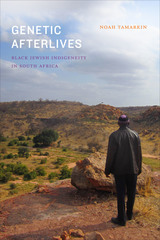 Genetic Afterlives: Black Jewish Indigeneity in South Africa
Noah Tamarkin
Duke University Press, 2020 In 1997, M. E. R. Mathivha, an elder of the black Jewish Lemba people of South Africa, announced to the Lemba Cultural Association that a recent DNA study substantiated their ancestral connections to Jews. Lemba people subsequently leveraged their genetic test results to seek recognition from the post-apartheid government as indigenous Africans with rights to traditional leadership and land, retheorizing genetic ancestry in the process. In Genetic Afterlives, Noah Tamarkin illustrates how Lemba people give their own meanings to the results of DNA tests and employ them to manage competing claims of Jewish ethnic and religious identity, African indigeneity, and South African citizenship. Tamarkin turns away from genetics researchers' results that defined a single story of Lemba peoples' “true” origins and toward Lemba understandings of their own genealogy as multivalent. Guided by Lemba people’s negotiations of their belonging as diasporic Jews, South African citizens, and indigenous Africans, Tamarkin considers new ways to think about belonging that can acknowledge the importance of historical and sacred ties to land without valorizing autochthony, borders, or other technologies of exclusion.
Genetic Algorithms in Engineering Systems
A.M.S. Zalzala
The Institution of Engineering and Technology, 1997 This book comprises ten invited expert contributions on the theory and applications of genetic algorithms in a variety of engineering systems. In addition to addressing the simple formulation of GAs, the chapters include original material on the design of evolutionary algorithms for particular engineering applications. Chosen for their experience in the field, the authors are drawn from both academia and industry worldwide, and provide extensive insight into their respective fields. The volume is suitable for researchers and postgraduates who need to be up-to-date with developments in this important subject, as well as practitioners in industry who are eager to find out how to solve their particular real-life problems.
A Genetic Approach to Structures in the Work of Jean Genet
Camille Naish
Harvard University Press, 1978 Camille Naish has written the first formalist study of the provocative French writer Jean Genet. She treats his major texts, from the erotic homosexual elegy Le Condamne a mort (1942) to the highly controversial epic Les Parvents (1966), and links the characteristic structure of his later plays with his relatively obscure first poems and early novels. Dr. Naish’s study insightfully discusses previous critical responses to Genet, examines Genet’s relationship with Cocteau and the Surrealists, and finally takes an original look at humor and parody in this unusual writer.
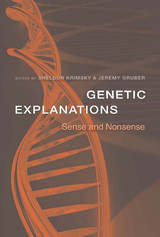 Genetic Explanations: Sense and Nonsense
Sheldon Krimsky
Harvard University Press, 2012 Can genes determine which fifty-year-old will succumb to Alzheimer’s, which citizen will turn out on voting day, and which child will be marked for a life of crime? Yes, according to the Internet, a few scientific studies, and some in the biotechnology industry who should know better. Sheldon Krimsky and Jeremy Gruber gather a team of genetic experts to argue that treating genes as the holy grail of our physical being is a patently unscientific endeavor. Genetic Explanations urges us to replace our faith in genetic determinism with scientific knowledge about how DNA actually contributes to human development.
The concept of the gene has been steadily revised since Watson and Crick discovered the structure of the DNA molecule in 1953. No longer viewed by scientists as the cell’s fixed set of master molecules, genes and DNA are seen as a dynamic script that is ad-libbed at each stage of development. Rather than an autonomous predictor of disease, the DNA we inherit interacts continuously with the environment and functions differently as we age. What our parents hand down to us is just the beginning. Emphasizing relatively new understandings of genetic plasticity and epigenetic inheritance, the authors put into a broad developmental context the role genes are known to play in disease, behavior, evolution, and cognition.
Rather than dismissing genetic reductionism out of hand, Krimsky and Gruber ask why it persists despite opposing scientific evidence, how it influences attitudes about human behavior, and how it figures in the politics of research funding.
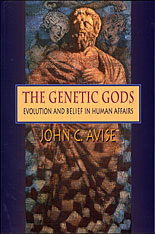 The Genetic Gods: Evolution and Belief in Human Affairs
John C. Avise
Harvard University Press, 1998 They mastermind our lives, shaping our features, our health, and our behavior, even in the sacrosanct realms of love and sex, religion, aging, and death. Yet we are the ones who house, perpetuate, and give the promise of immortality to these biological agents, our genetic gods. The link between genes and gods is hardly arbitrary, as the distinguished evolutionary geneticist John Avise reveals in this compelling book. In clear, straightforward terms, Avise reviews recent discoveries in molecular biology, evolutionary genetics, and human genetic engineering, and discusses the relevance of these findings to issues of ultimate concern traditionally reserved for mythology, theology, and religious faith.
The book explains how the genetic gods figure in our development--not just our metabolism and physiology, but even our emotional disposition, personality, ethical leanings, and, indeed, religiosity. Yet genes are physical rather than metaphysical entities. Having arisen via an amoral evolutionary process--natural selection--genes have no consciousness, no sentient code of conduct, no reflective concern about the consequences of their actions. It is Avise's contention that current genetic knowledge can inform our attempts to answer typically religious questions--about origins, fate, and meaning. The Genetic Gods challenges us to make the necessary connection between what we know, what we believe, and what we embody.
 Genetic Improvement of Crops: Emergent Techniques
Irwin Rubenstein
University of Minnesota Press, 1980
Genetic Improvement of Crops was first published in 1980. Minnesota Archive Editions uses digital technology to make long-unavailable books once again accessible, and are published unaltered from the original University of Minnesota Press editions.Recent years have seen the emergence of a number of in vitro techniques that hold promise for the genetic alteration of higher organisms by non-traditional means. These new techniques may eventually modify the genetic structure of cash crop plants and, in practical terms, may lead to substantial improvement of crop production and to disease resistance in plants.This volume brings together 10 research reports by scientists actively engaged in developing genetic techniques in plants and other organisms. The first section explores both the potential for application of these techniques and the genetic needs of plant breeders. Other sections deal with genome organization and function; recombinant DNA technology and application; gene transfer; organelle transfer; and plant tissue culture.
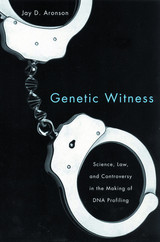 Genetic Witness: Science, Law, and Controversy in the Making of DNA Profiling
Jay D. Aronson
Rutgers University Press, 2007 When DNA profiling was first introduced into the American legal system in 1987, it was heralded as a technology that would revolutionize law enforcement. As an investigative tool, it has lived up to much of this hype—it is regularly used to track down unknown criminals, put murderers and rapists behind bars, and exonerate the innocent.
Yet, this promise took ten turbulent years to be fulfilled. In Genetic Witness, Jay D. Aronson uncovers the dramatic early history of DNA profiling that has been obscured by the technique’s recent success. He demonstrates that robust quality control and quality assurance measures were initially nonexistent, interpretation of test results was based more on assumption than empirical evidence, and the technique was susceptible to error at every stage. Most of these issues came to light only through defense challenges to what prosecutors claimed to be an infallible technology. Although this process was fraught with controversy, inefficiency, and personal antagonism, the quality of DNA evidence improved dramatically as a result. Aronson argues, however, that the dream of a perfect identification technology remains unrealized.
Genetically Modified Food: A Short Guide For the Confused
Andy Rees
Pluto Press, 2006 Genetically modified food has been headline news for years, but it's difficult to know how far the genetic revolution has affected our lives. Is the food on our shelves free of genetically engineered ingredients? How much power to food corporations wield? Andy Rees provides the answers. He shows that, while corporations that produce genetically modified food have met with resistance in Europe, their hold on the U.S. market is strong. They're also expanding operations in less-regulated countries in Africa, Asia, and the former Soviet bloc. The United States has launched a legal suit to attempt to force the European market open to genetically modified food. What does the future hold? Written by a leading campaigner for GM Watch, one of the world's leading lobbying groups, this brilliantly readable book tells us all we need to know.
Genetics and Eugenics: Fourth Edition
William E. Castle
Harvard University Press In this fourth edition of his standard work on Genetics, William Castle has given a more extended account of human heredity, of which our knowledge has considerably increased in recent years. The chapter on the unit-characters of rodents has been completely rewritten, as what we know of heredity in mammals depends very largely on this group. Polyploidy, parthenogenesis, and the artificial production of mutations are also topics requiring new discussion. The views of biologists have reached substantial unity on the formerly controversial subject of selection, so that the treatment of this topic has been simplified.
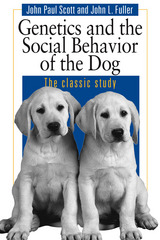 Genetics and the Social Behaviour of the Dog
John Paul Scott and John L. Fuller
University of Chicago Press, 1974 A classic study of dog behavior gathered into one volume, this is the single most important and comprehensive reference work on the behavior of dogs ever complied.
Scott and Fuller’s classic study of dog behavior gathers into one volume the authoritative information that came from their twenty years of research at the Jackson Laboratory. Central to their book is the role heredity plays in the development of behavior. Giving puppies an environment designed on the principles of a well-run school, Scott and Fuller tested five breeds representing the major dog groups and carried out a Mendelian experiment with two of the most different breeds: the basenji and the cocker spaniel.
They found that heredity affects almost every trait tested; that sex affects aggressiveness and the dominance order, but not trainability and problem-solving; that emotional traits profoundly influence performance; that, although breeds differ widely in emotional and motivational characteristics, none shows distinct superiority in problem solving; and that detailed statistical analyses indicate a highly complex pathway between primary gene action and its final effect on behavior.
Included is important information on:
• rearing methods
• the origin and history of dog breeds
• basic behavior patterns
• the physiological and behavioral development of puppies
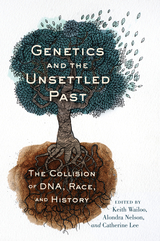 Genetics and the Unsettled Past: The Collision of DNA, Race, and History
Wailoo, Keith
Rutgers University Press, 2012 Our genetic markers have come to be regarded as portals to the past. Analysis of these markers is increasingly used to tell the story of human migration; to investigate and judge issues of social membership and kinship; to rewrite history and collective memory; to right past wrongs and to arbitrate legal claims and human rights controversies; and to open new thinking about health and well-being. At the same time, in many societies genetic evidence is being called upon to perform a kind of racially charged cultural work: to repair the racial past and to transform scholarly and popular opinion about the “nature” of identity in the present. Genetics and the Unsettled Past considers the alignment of genetic science with commercial genealogy, with legal and forensic developments, and with pharmaceutical innovation to examine how these trends lend renewed authority to biological understandings of race and history. This unique collection brings together scholars from a wide range of disciplines—biology, history, cultural studies, law, medicine, anthropology, ethnic studies, sociology—to explore the emerging and often contested connections among race, DNA, and history. Written for a general audience, the book’s essays touch upon a variety of topics, including the rise and implications of DNA in genealogy, law, and other fields; the cultural and political uses and misuses of genetic information; the way in which DNA testing is reshaping understandings of group identity for French Canadians, Native Americans, South Africans, and many others within and across cultural and national boundaries; and the sweeping implications of genetics for society today.
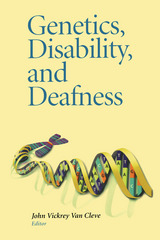 Genetics, Disability, and Deafness
John Vickrey Van Cleve
Gallaudet University Press, 2004 Pulitzer Prize-winning author Louis Menand begins this wide-ranging volume with an essay that extols diversity and warns of the dangers of modifying the human genome. Nora Groce reviews the ways that societies have defined disability and creates an interpretive framework for discussing the relationship between culture and disability.
In essays devoted to historical perspective, Brian H. Greenwald comments upon the real “toll” taken by A. G. Bell’s insistence upon oralism, while Joseph J. Murray weighs the nineteenth-century debate over whether deaf-deaf marriages should be encouraged. John S. Schuchman’s chilling account of deafness and eugenics in the Nazi era adds wrenching reinforcement to the impetus to include disabled people in genetics debates.
Mark Willis offers an intensely personal reflection on the complexities of genetic alteration, addressing both his heart condition and his blindness in surprisingly different ways. Anna Middleton extends Willis’s concepts in her discussion of couples currently considering the use of genetic knowledge and technology to select for or against a gene that causes deafness.
In the part on the science of genetics, Orit Dagan, Karen B. Avraham, Kathleen S. Arnos, and Arti Pandya clarify the choices presented by genetic engineering, and geneticist Walter E. Nance emphasizes the importance of science in offering individuals knowledge from which they can fashion their own decisions. In the concluding section, Christopher Krentz raises moral questions about the ever-continuing search for human perfection, and Michael Bérubé argues that disability should be considered democratically to ensure full participation of disabled people in all decisions that might affect them.
The Genetics of Domestic Rabbits: A Manual for Students of Mammalian Genetics, and an Aid to Rabbit Breeders and Fur Farmers
William E. Castle
Harvard University Press For a study of the evolution of breeds, the rabbit is passed, since the parent species still exists wild and hybridization has not occurred with any second species to complicate the process. This discussion of the rabbit will therefore help the rabbit breeder better to understand the genetic constitution of his animals and so to be able to alter that constitution to suit his purposes. At the same time, students of genetics will find the information useful in enabling them to understand what rabbit breeders of this and previous centuries have accomplished and how they have been able to accomplish it.
 The Geneva Conventions Under Assault
Edited by Sarah Perrigo and Jim Whitman
Pluto Press, 2010 Outrages committed during violent conflict and as part of the 'war on terror' are not only an affront to human dignity -- they also violate the Geneva Conventions.
This book examines recent high-profile cases of repeated and open abuse of the Conventions. The contributors explore why these and related violations of international humanitarian law cannot be viewed as anomalies, but must be regarded as part of a pattern which is set to undermine the Geneva Conventions as a whole.
The contributors argue that an international system in which there is diminishing legal restraint on the use of force means that the world will become less secure and more volatile, even for those in the most powerful countries. Individuals everywhere face the prospect of a horrifying vulnerability.
This is the first scholarly yet accessible work to consider the meanings of outrages such as the normalisation of torture, as well as the worrying new normative, technical and tactical developments that challenge the purpose and standing of the Geneva Conventions.
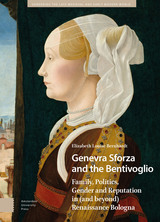 Genevra Sforza and the Bentivoglio: Family, Politics, Gender and Reputation in (and beyond) Renaissance Bologna
Elizabeth Bernhardt
Amsterdam University Press, 2023 Genevra Sforza (ca. 1441–1507) lived her long life near the apex of Italian Renaissance society as wife of two successive de facto rulers of Bologna: Sante then Giovanni II Bentivoglio. Placed twice there without a dowry by Duke Francesco Sforza as part of a larger Milanese plan, Genevra served her family by fulfilling the gendered role demanded of her by society, most notably by contributing eighteen children, accepting many illegitimates born to Giovanni II, and helping arrange their future alliances for the success of the family at large. Based on contemporary archival research conducted across Italy, this biography presents Genevra as the object of academic study for the first time. The book explores how Genevra’s life-story, filled with a multitude of successes appropriate for an elite fifteenth-century female, was transformed into a concordant body of misogynistic legends about how she destroyed the Bentivoglio and the city of Bologna.
 Genghis Chan on Drums
John Yau
Omnidawn, 2021 A diverse and cacophonous poetry collection tackling subjects from identity to current events.
At once comic and cantankerous, tender and discomfiting, piercing and irreverent, Genghis Chan on Drums is a shape-shifting book of percussive poems dealing with aging, identity, PC culture, and stereotypes about being Chinese. Employing various forms, John Yau’s poems traverse a range of subjects, including the 1930s Hollywood actress Carole Lombard, the Latin poet Catullus, the fantastical Renaissance painter Piero di Cosimo’s imaginary sister, and a nameless gumshoe. Yau moves effortlessly from using the rhyme scheme of a sixteenth-century Edmund Spenser sonnet to riffing on a well-known poem-rant by the English poet Sean Bonney, and to immersing himself in the words of condolence sent by a former president to the survivors of a school massacre. Yau’s poems are conduits through which many different, conflicting, and unsavory voices strive to be heard.
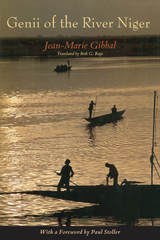 Genii of the River Niger
Jean-Marie Gibbal
University of Chicago Press, 1993 The river Niger, a source of life and danger for the people in impoverished eastern Mali, is also the origin of elaborate mythology. From his travels through Mali and down the Niger in a dugout canoe, Jean-Marie Gibbal has created a personal documentary of the cultures of the region. The result is at once an ethnography of cultures in crisis and a poetic evocation of the environment and people he encountered.
Gibbal portrays the river as the dominant, cohesive force among people in the face of social and environmental strife. He focuses on the Ghimbala healing cult, which centers on the river, and how the cult structures social relations in the region. Gibbal vividly recreations the Ghimbala rites, nocturnal ceremonies of spirit possession and seance which animate the water spirits, or genii, that inhabit the river. The genii, he finds, provide the strength of social identity in a world where famine and competing versions of Islam threaten to overpower traditional culture.
In its original French publication, The Genii of the River Niger was honored with an Alexandra David-Neel literary prize in 1989. Its powerful lyricism, combined with fascinating ethnographic depth, will delight general readers and specialists alike and will stir debates among specialists in African studies, the anthropology of religion, and literature.
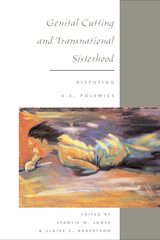 Genital Cutting and Transnational Sisterhood: DISPUTING U.S. POLEMICS
Edited by Stanlie M. James and Claire C. Robertson
University of Illinois Press, 2002 Genital Cutting and Transnational Sisterhood is a much-needed response to the ethnocentric and arrogant Western perceptions surrounding female genital cutting (FGC), often referred to as either female genital mutilation or female circumcision, but including a variety of practices of varying history, severity, geographical distribution, and consequences.
In five provocative essays, the contributors to this timely volume challenge representations of FGC through a range of perspectives: history, human rights, law, missionary feminism, cultural relativism, anthropology, and the intersex movement. Balancing feminist ideals with culturally conscious approaches, they dispel sensationalized and widely accepted concepts that influence Western media, law, and feminist thought on FGC, including the ignorance and oversimplification of African history, cultures, and religions, and an exaggeration of the extent and geographical distribution of the various procedures performed. The assumption that FGC does not occur presently in the United States is also considered. From Alice Walker and Pratibha Parmar's documentary film Warrior Marks to mainstream media and prime time television, Genital Cutting and Transnational Sisterhood critiques the sources that perpetuate the harmful myths that all African women have been mutilated and promote doing so to their children, that those who perform it are barbaric, and that families who allow it are abusive.
With sensitivity and clarity, the contributors to Genital Cutting and Transnational Sisterhood provide necessary and alternative suggestions for the eradication of the most harmful procedures--which they feel can only occur when the leadership of African women in the ongoing campaigns is acknowledged and supported, and when income generation for African women and education of the U.S. public, rather than criminalization, become primary strategies.
Genius: A Novel
Thomas Rayfiel
Northwestern University Press, 2016 Kara Bell spent her youth plotting escape from Witch’s Falls, Arkansas. Relentless focus and the spurning of all emotional attachment led to the doctoral program in philosophy at Columbia University. But Kara’s careful plans are upended by cancer, and suddenly she is home again, where she finds herself subject to her mother’s suffocating care, her brother’s puzzling love life, the local doctor’s meddling, and the strong gravitational pull of her old friend and obsession, Christy Lee. Will Kara find health and sanity? Will she learn what really happened to her father? Can she escape Witch’s Falls a second time, or will she succumb to the slow poison of local kindness and Snickers Salad? In Genius, Thomas Rayfiel finds both poignancy and dark humor in deathly illness, family secrets, organized religion, parenting, abortion, gossip, senility, and the mysterious rhythms of small-town life.
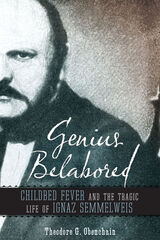 Genius Belabored: Childbed Fever and the Tragic Life of Ignaz Semmelweis
Theodore G. Obenchain
University of Alabama Press, 2016 The fascinating story of Ignaz Semmelweis, a nineteenth-century obstetrician ostracized for his strident advocacy of disinfection as a way to prevent childbed fever
In Genius Belabored: Childbed Fever and the Tragic Life of Ignaz Semmelweis, Theodore G. Obenchain traces the life story of a nineteenth-century Hungarian obstetrician who was shunned and marginalized by the medical establishment for advancing a far-sighted but unorthodox solution to the appalling mortality rates that plagued new mothers of the day.
In engrossing detail, Obenchain recreates for readers the sights, smells, and activities within a hospital of that day. In an era before the acceptance of modern germ science, physicians saw little need for cleanliness or hygiene. As a consequence, antiseptic measures were lax and rudimentary. Especially vulnerable to contamination were new mothers, who frequently contracted and died from childbed fever (puerperal fever). Genius Belabored follows Semmelweis’s awakening to the insight that many of these deaths could be avoided with basic antiseptic measures like hand washing.
The medical establishment, intellectually unprepared for Semmelweis’s prescient hypothesis, rejected it for a number of reasons. It was unorthodox and went against the lingering Christian tradition that the dangers of childbirth were inherent to the lives of women. Complicating matters, colleagues did not consider Semmelweis an easy physician to work with. His peers described him as strange and eccentric. Obenchain offers an empathetic and insightful argument that Semmelweis suffered from bipolar disorder and illuminates how his colleagues, however dedicated to empirical science they might have been, misjudged Semmelweis’s methods based upon ignorance and their emotional discomfort with him.
In Genius Belabored, Obenchain identifies Semmelweis’s rightful place in the pantheon of scientists and physicians whose discoveries have saved the lives of millions. Obenchain’s biography of Semmelweis offers unique insights into the practice of medicine and the mindsets of physicians working in the premodern era. This fascinating study offers much of interest to general readers as well as those interested in germ theory, the history of medicine and obstetrics, or anyone wishing to better understand the trajectory of modern medicine.
The Genius of American Politics
Daniel J. Boorstin
University of Chicago Press, 1958 How much of our political tradition can be absorbed and used by other peoples? Daniel Boorstin's answer to this question has been chosen by the Carnegie Corporation of New York for representation in American Panorama as one of the 350 books, old and new, most descriptive of life in the United States. He describes the uniqueness of American thought and explains, after a close look at the American past, why we have not produced and are not likely to produce grand political theories or successful propaganda. He also suggests what our attitudes must be toward ourselves and other countries if we are to preserve our institutions and help others to improve theirs.
". . . a fresh and, on the whole, valid interpretation of American political life."—Reinhold Niebuhr, New Leader
 The Genius of Place: The Geographic Imagination in the Early Republic
Christopher C. Apap
University of New Hampshire Press, 2019 The Genius of Place examines how, after the War of 1812, concerns about the scale of the nation resulted in a fundamental reorientation of American identity away from the Atlantic or global ties that held sway in the early republic and toward more localized forms of identification. Instead of addressing the sweep of the nation, American authors, artists, geographers, and politicians shifted from the larger reach of the globe to the more manageable scope of the local and sectional. Paradoxically, that local representation became the primary mode through which early Americans construed their emerging national identity. This newfound cultural obsession with locality impacted the literary consolidation and representation of key American imagined places—New England, the plantation, the West—in the decades between 1816 and 1836.
Apap’s examination of the intersections between local and national representations and exploration of the myths of space and place that shaped U.S. identity through the nineteenth century will appeal to a broad, interdisciplinary readership.
Hardcover is un-jacketed.
 Genius To Improve An Invention
Piero Boitani
University of Notre Dame Press, 2002
The Genius to Improve an Invention derives its title from John Dryden’s phrase for the British tendency to take up literary masterpieces from the past and “perfect” them. Distinguished literary scholar Piero Boitani adopts Dryden’s notion as a framework for exploring ways in which classical and medieval texts, scenes, and themes have been rewritten by modern authors. Boitani focuses on a concept of literary transition that takes into account both T.S. Eliot’s idea of “tradition and individual talent” and Harold Bloom’s “anxiety of influence.” In five elegant essays he examines a wide range of authors and texts, including Aeschylus, Sophocles, Euripides, Shakespeare, Chaucer, Voltaire, Goethe, Sartre, Dante, and Keats. Appearing for the first time in an English translation, The Genius to Improve an Invention will appeal to anyone interested in the Western literary tradition.
“ The Genius to Improve an Invention is both substantial and graceful–a fascinating journey through some of the greatest works of Western literature, with a guide who is at once learned and entertaining, impassioned and moving.” —Jill Mann, University of Notre Dame
“This book deserves the attention of all who are interested in the processes of literary continuity and change.” —Frank Kermode, King’s College, Cambridge University
“The Genius to Improve an Invention is supported with a thorough theoretical awareness and a flexible intelligence enabling Boitani to move comfortably within a vast array of texts and thus take the reader on a fascinating literary journey. Through his pressing and detailed argumentations, the author suggests original approaches to some of the great works of European literature—each of them is considered as a solution to a specific problem and, at the same time, as a probative argument in favor of applied rationality. Reading these essays calls to mind what Henry James once said, ‘all the pieces of the game [are] on the table together and each unconfusedly and contributively placed, as triumphantly scientific.’” —Mario Lavagetto, University of Bologna
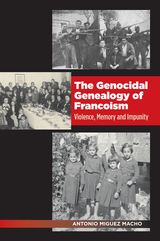 The Genocidal Genealogy of Francoism: Violence, Memory and Impunity
Antonio Miguez Macho
Sussex Academic Press, 2022 The Francoist command in the Spanish Civil War carried out a programme of mass violence from the start of the conflict. Through a combination of death squads and the use of military trials, around 150,000 Spaniards met their deaths. Others perished in concentration camps and prisons. The terror took other forms, such as mass rape, extortion, "appropriation" of children, and forced exile. The planned nature of this violence meant that the Francoists decided when the violence would begin, the way it would be carried out, and when it would come to an end. This is the primary reason why the judicial concept of genocidal practice, alongside the use of comparative history, can furnish insights. The July 1936 uprising was not only aimed at ending the Republican regime, but had ideological goals: preventing the supposed Bolshevik Revolution, defending the 'unity of Spain,' and reversing centre-left social and cultural reforms. An over-arching objective was the elimination of a social group identified as 'an enemy of Spain'-a group defined as not Catholic, not Spanish, and not traditional. With their access to state resources, their monopoly of force in some territories, and their subsequent victory, the coup's practice of genocide could be realised in the whole Spanish territory, permitting the hegemonic nature of the denialist discourse surrounding these crimes. Public debate over Francosim brings with it substantive disagreements. The book engages with the root causes of these disagreements. Violence and the memory of violence are viewed as part of a single phenomenon that has continued to the present, a process that is located within a comparative framework that analyzes the Spanish case beyond the debate between Francoism and anti-Francoism. The author explains the political and judicial proceedings in recent Spanish history with regard to its violent past and the implications for international justice initiatives. This book is published in association with the Canada Blanch Centre for Contemporary Spanish Studies, LSE. [Subject: Spanish Civil War, History, Military Studies]
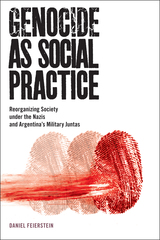 Genocide as Social Practice: Reorganizing Society under the Nazis and Argentina's Military Juntas
by Daniel Feierstein, Translated by Douglas Andrew Town
Rutgers University Press, 2014 Genocide not only annihilates people but also destroys and reorganizes social relations, using terror as a method. In Genocide as Social Practice, social scientist Daniel Feierstein looks at the policies of state-sponsored repression pursued by the Argentine military dictatorship against political opponents between 1976 and 1983 and those pursued by the Third Reich between 1933 and 1945. He finds similarities, not in the extent of the horror but in terms of the goals of the perpetrators. The Nazis resorted to ruthless methods in part to stifle dissent but even more importantly to reorganize German society into a Volksgemeinschaft, or people’s community, in which racial solidarity would supposedly replace class struggle. The situation in Argentina echoes this. After seizing power in 1976, the Argentine military described its own program of forced disappearances, torture, and murder as a “process of national reorganization” aimed at remodeling society on “Western and Christian” lines. For Feierstein, genocide can be considered a technology of power—a form of social engineering—that creates, destroys, or reorganizes relationships within a given society. It influences the ways in which different social groups construct their identity and the identity of others, thus shaping the way that groups interrelate. Feierstein establishes continuity between the “reorganizing genocide” first practiced by the Nazis in concentration camps and the more complex version—complex in terms of the symbolic and material closure of social relationships —later applied in Argentina. In conclusion, he speculates on how to construct a political culture capable of confronting and resisting these trends. First published in Argentina, in Spanish, Genocide as Social Practice has since been translated into many languages, now including this English edition. The book provides a distinctive and valuable look at genocide through the lens of Latin America as well as Europe. Download open access ebook here.
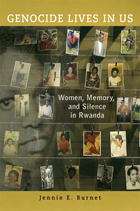 Genocide Lives in Us: Women, Memory, and Silence in Rwanda
Jennie E. Burnet
University of Wisconsin Press, 2012 In the aftermath of the 1994 genocide, Rwandan women faced the impossible—resurrecting their lives amidst unthinkable devastation. Haunted by memories of lost loved ones and of their own experiences of violence, women rebuilt their lives from “less than nothing.” Neither passive victims nor innate peacemakers, they traversed dangerous emotional and political terrain to emerge as leaders in Rwanda today. This clear and engaging ethnography of survival tackles three interrelated phenomena—memory, silence, and justice—and probes the contradictory roles women played in postgenocide reconciliation.
Based on more than a decade of intensive fieldwork, Genocide Lives in Us provides a unique grassroots perspective on a postconflict society. Anthropologist Jennie E. Burnet relates with sensitivity the heart-wrenching survival stories of ordinary Rwandan women and uncovers political and historical themes in their personal narratives. She shows that women’s leading role in Rwanda’s renaissance resulted from several factors: the dire postgenocide situation that forced women into new roles; advocacy by the Rwandan women’s movement; and the inclusion of women in the postgenocide government.
Honorable Mention, Aidoo-Snyder Book Prize, Women’s Caucus of the African Studies Association
Genocide: New Perspectives on its Causes, Courses and Consequences
Edited by Ügür Ümit Üngör
Amsterdam University Press, 2016 The twentieth century has been called, not inaccurately, a century of genocide. And the beginning of the twenty-first century has seen little change, with genocidal violence in Darfur, Congo, Sri Lanka, and Syria. Why is genocide so widespread, and so difficult to stop, across societies that differ so much culturally, technologically, and politically?
That's the question that this collection addresses, gathering a stellar roster of contributors to offer a range of perspectives from different disciplines to attempt to understand the pervasiveness of genocidal violence. Challenging outdated beliefs and conventions that continue to influence our understanding, Genocide constitutes a major contribution to the scholarship on mass violence.
Genocide Studies: Pathways Ahead
Jeffrey S. Bachman
Rutgers University Press, 2025 In recent years, the world has been shaken by numerous events that have caused and continue to cause massive human suffering, from the COVID-19 pandemic to intrastate and interstate armed conflicts. Moreover, climate change continues to plow ahead, contributing to growing tensions, population movements, and resource scarcity. Meanwhile, the methods by which groups and group life are threatened, and the means by which violence is incited and perpetrated, continue to evolve. Such divergent crises, even when they overlap or intersect, confound definition and label. This book seeks not to answer the question "What is genocide?" but rather "What is genocide studies?" When Raphael Lemkin coined the term "genocide" in 1944, he could not have foreseen what the world would look like today. Now is the time to think about current manifestations of genocide and those likely to emerge in the future.
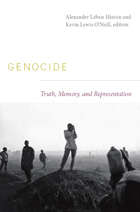 Genocide: Truth, Memory, and Representation
Alexander Laban Hinton and Kevin Lewis O Neill, eds.
Duke University Press, 2009 What happens to people and the societies in which they live after genocide? How are the devastating events remembered on the individual and collective levels, and how do these memories intersect and diverge as the rulers of postgenocidal states attempt to produce a monolithic “truth” about the past? In this important volume, leading anthropologists consider such questions about the relationship of genocide, truth, memory, and representation in the Balkans, East Timor, Germany, Guatemala, Indonesia, Nigeria, Rwanda, Sudan, and other locales. Specialists on the societies about which they write, these anthropologists draw on ethnographic research to provide on-the-ground analyses of communities in the wake of mass brutality. They investigate how mass violence is described or remembered, and how those representations are altered by the attempts of others, from NGOs to governments, to assert “the truth” about outbreaks of violence. One contributor questions the neutrality of an international group monitoring violence in Sudan and the assumption that such groups are, at worst, benign. Another examines the consequences of how events, victims, and perpetrators are portrayed by the Rwandan government during the annual commemoration of that country’s genocide in 1994. Still another explores the silence around the deaths of between eighty and one hundred thousand people on Bali during Indonesia’s state-sponsored anticommunist violence of 1965–1966, a genocidal period that until recently was rarely referenced in tourist guidebooks, anthropological studies on Bali, or even among the Balinese themselves. Other contributors consider issues of political identity and legitimacy, coping, the media, and “ethnic cleansing.” Genocide: Truth, Memory, and Representation reveals the major contribution that cultural anthropologists can make to the study of genocide. Contributors. Pamela Ballinger, Jennie E. Burnet, Conerly Casey, Elizabeth Drexler, Leslie Dwyer, Alexander Laban Hinton, Sharon E. Hutchinson, Uli Linke, Kevin Lewis O’Neill, Antonius C. G. M. Robben, Debra Rodman, Victoria Sanford
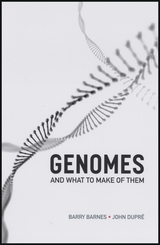 Genomes and What to Make of Them
Barry Barnes and John Dupré
University of Chicago Press, 2008 The announcement in 2003 that the Human Genome Project had completed its map of the entire human genome was heralded as a stunning scientific breakthrough: our first full picture of the basic building blocks of human life. Since then, boasts about the benefits—and warnings of the dangers—of genomics have remained front-page news, with everyone agreeing that genomics has the potential to radically alter life as we know it.
For the nonscientist, the claims and counterclaims are dizzying—what does it really mean to understand the genome? Barry Barnes and John Dupré offer an answer to that question and much more in Genomes and What to Make of Them, a clear and lively account of the genomic revolution and its promise. The book opens with a brief history of the science of genetics and genomics, from Mendel to Watson and Crick and all the way up to Craig Venter; from there the authors delve into the use of genomics in determining evolutionary paths—and what it can tell us, for example, about how far we really have come from our ape ancestors. Barnes and Dupré then consider both the power and risks of genetics, from the economic potential of plant genomes to overblown claims that certain human genes can be directly tied to such traits as intelligence or homosexuality. Ultimately, the authors argue, we are now living with a new knowledge as powerful in its way as nuclear physics, and the stark choices that face us—between biological warfare and gene therapy, a new eugenics or a new agricultural revolution—will demand the full engagement of both scientists and citizens.
Written in straightforward language but without denying the complexity of the issues, Genomes and What to Make of Them is both an up-to-date primer and a blueprint for the future.
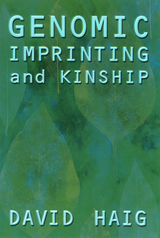 Genomic Imprinting and Kinship
Haig, David
Rutgers University Press, 2001 Until twenty years ago we had no idea which of our genes came from our father and which came from our mother. We took it for granted that our genes expressed themselves identically and that there was a 50/50 chance that they came from either parent. We also assumed that they worked in cooperation with each other. The biggest breakthrough in genetics in the past two decades has been the discovery of genomic imprinting, which allows us to trace genes to the parent of origin. David Haig has been at the forefront of theorizing these developments. He argues that these "paternally and maternally active genes" comprise less than one percent of our total gene count and are far from being cooperative. In fact, they have been shown to be in competition with one another. If Haig's theory holds true, imprinted genes exemplify an extraordinary within-individual conflict, while shaking up our fundamental ideas of what it means to be an individual. This collection of Haig's papers represents a unique comprehensive overview of the state of evolutionary biology. The pages are linked by a commentary that provides background, and brings readers up-to-date on developments that occurred after the paper's original publication. Since genomic imprinting touches on many areas in the life sciences, including evolutionary biology and developmental genetics, Haig's work is scattered through the literature. This volume brings his work together for the first time. A volume in the Rutgers Series in Human Evolution, edited by Robert Trivers. David Haig is an associate professor of organismic and evolutionary biology at Harvard University.
|
|
